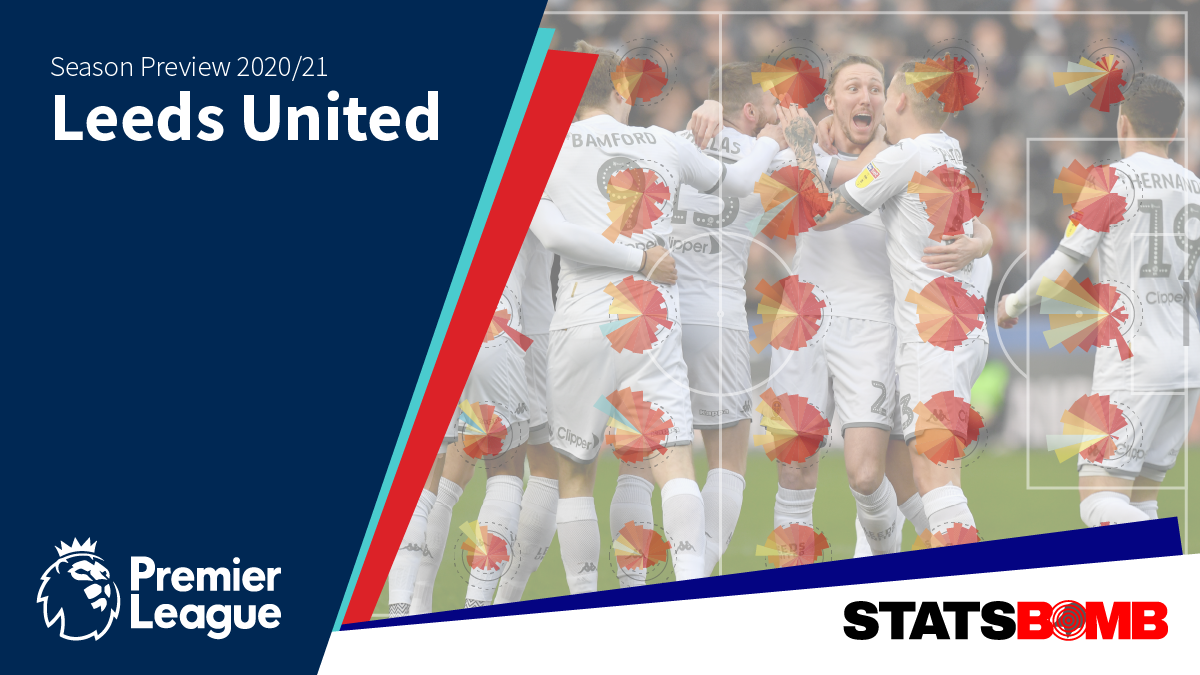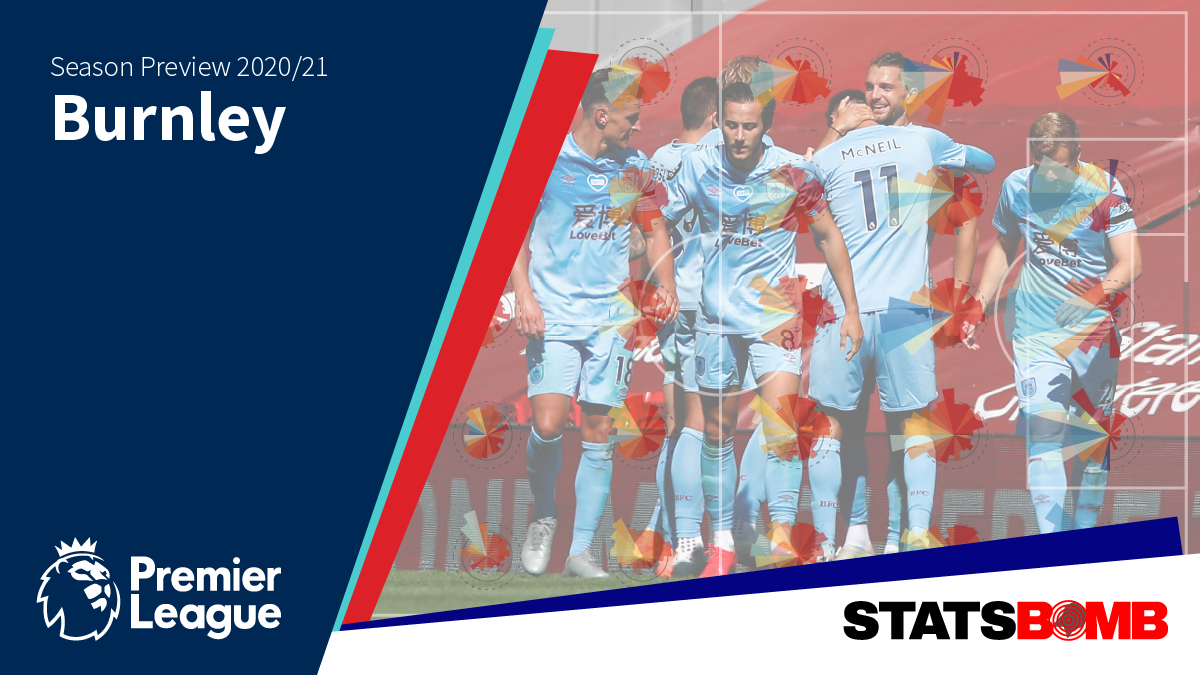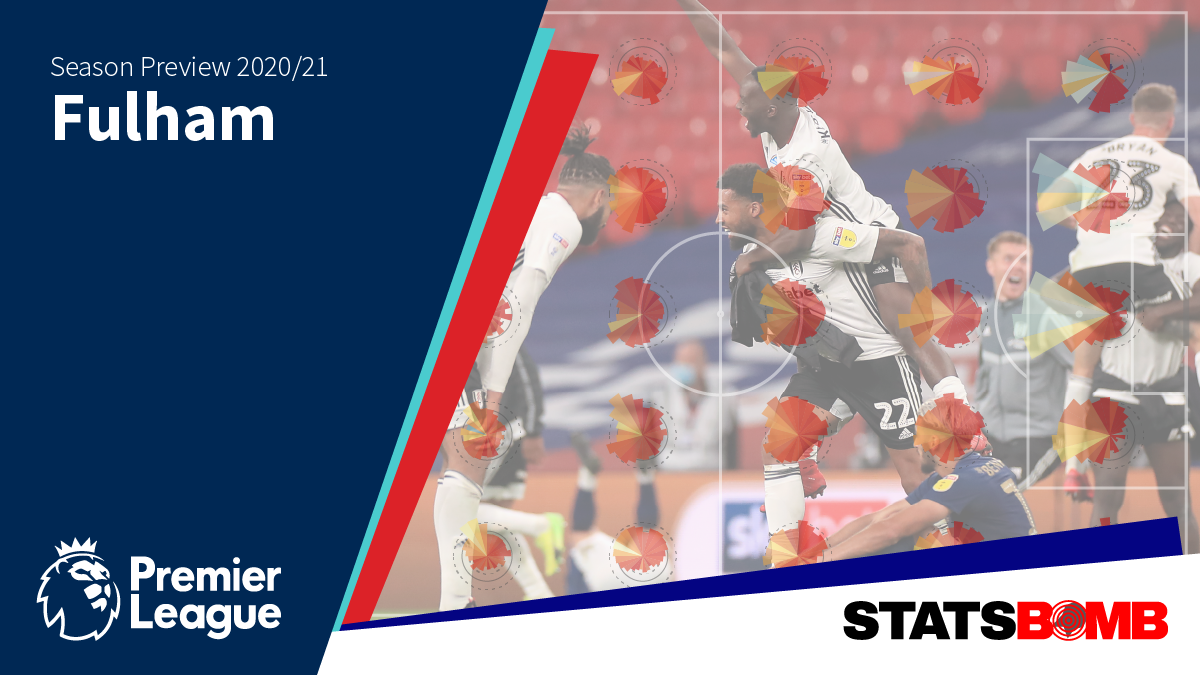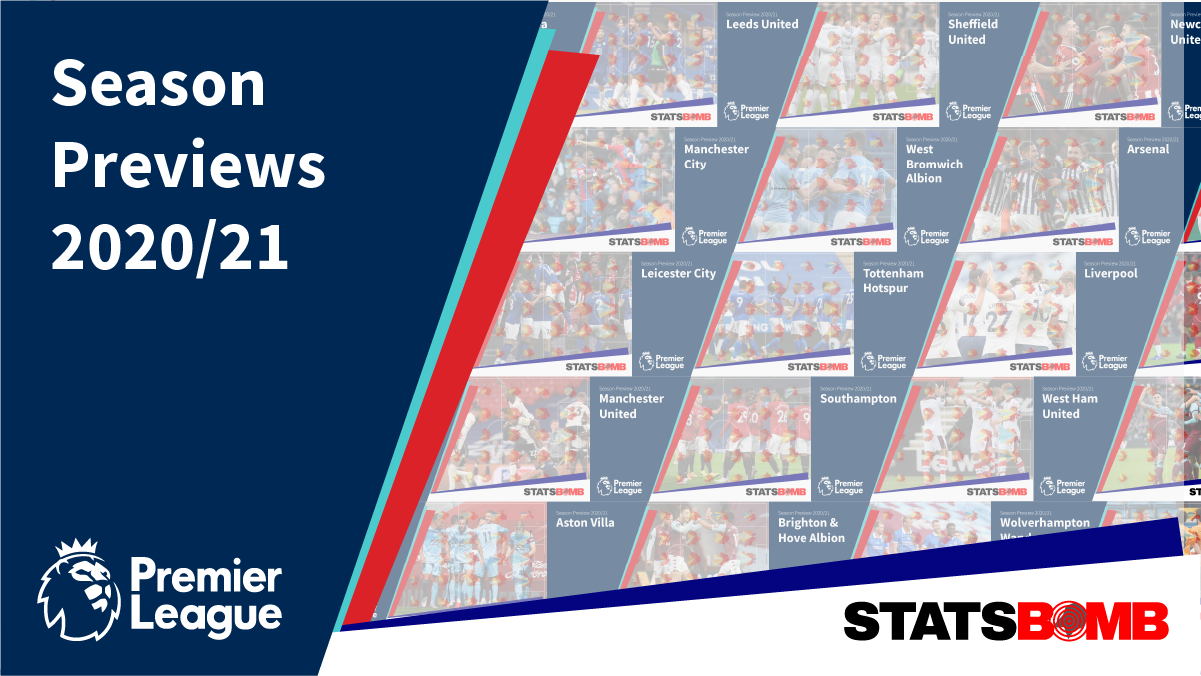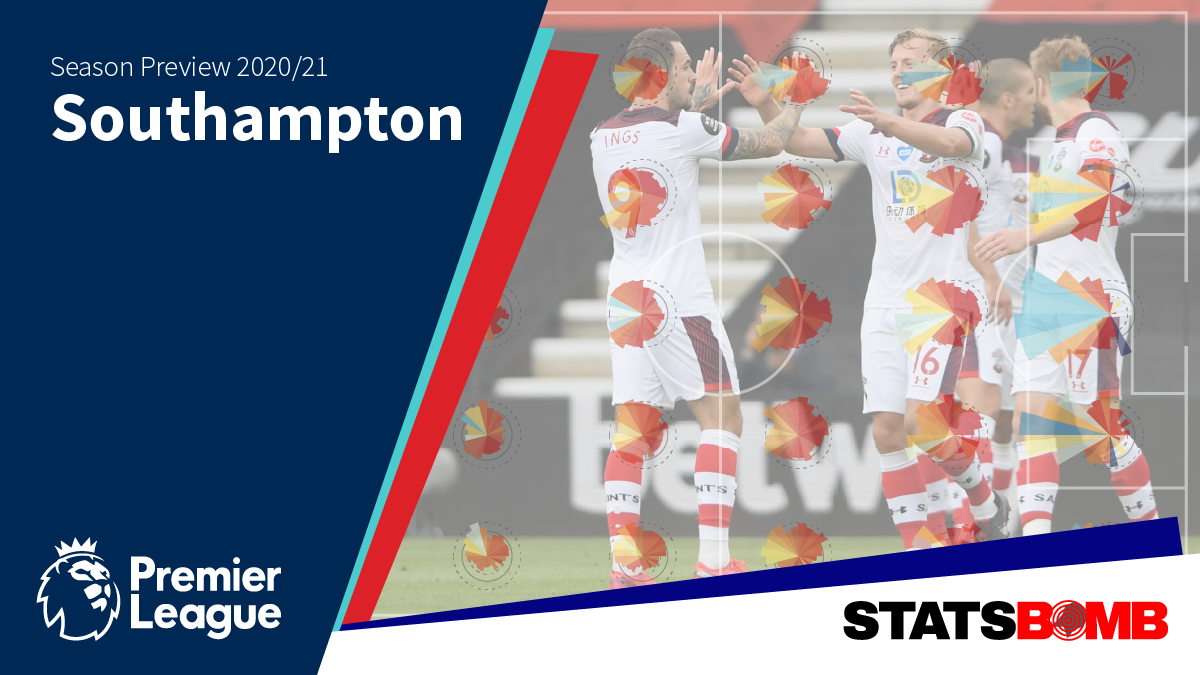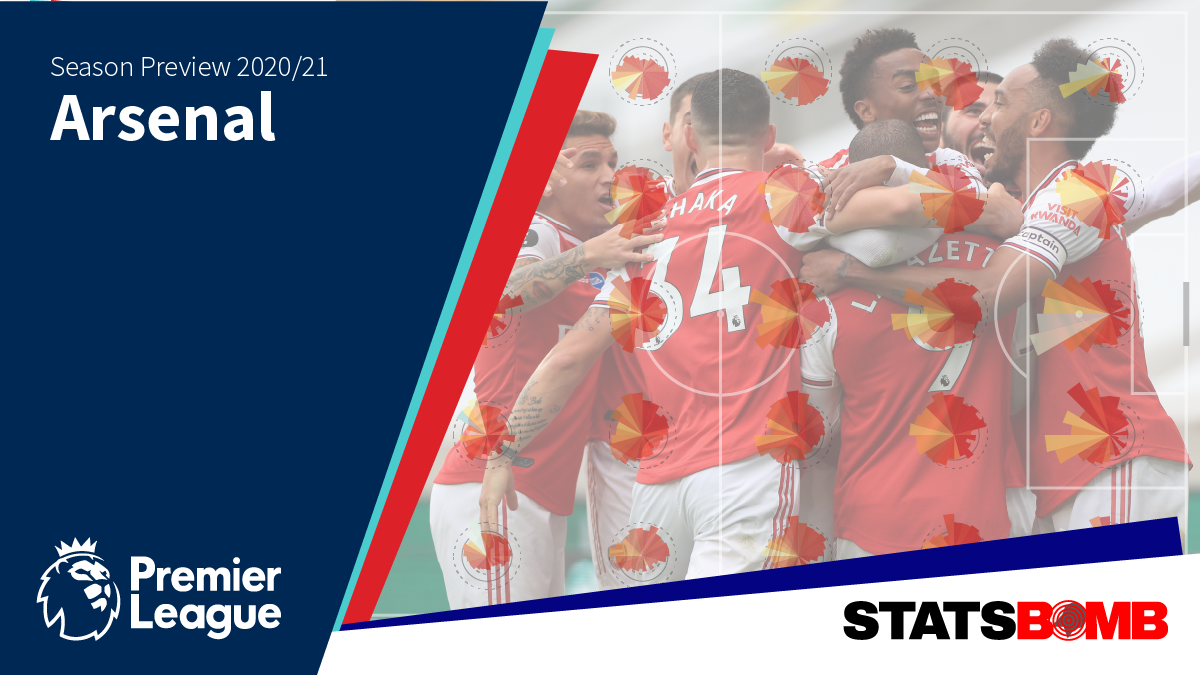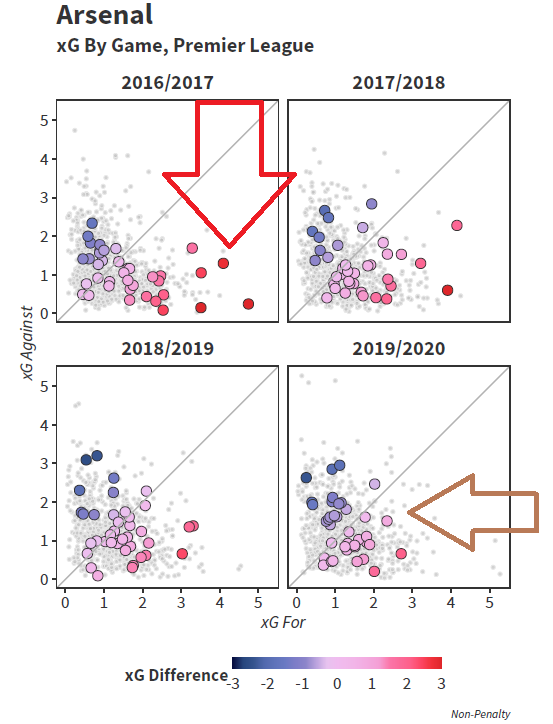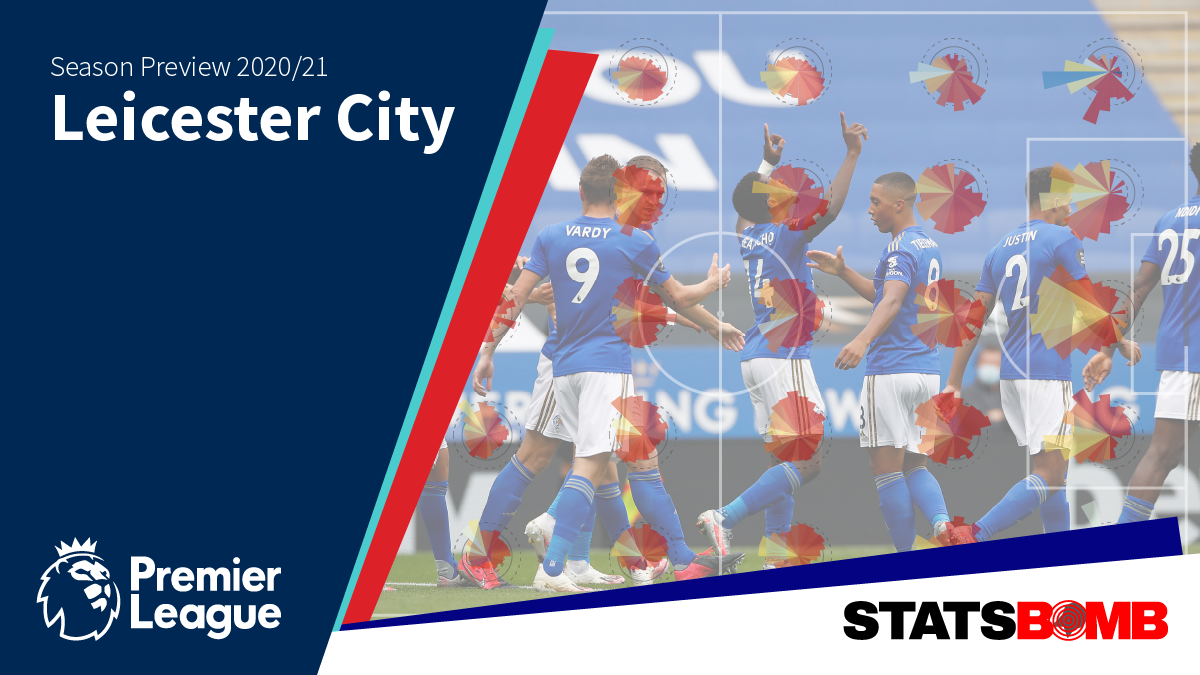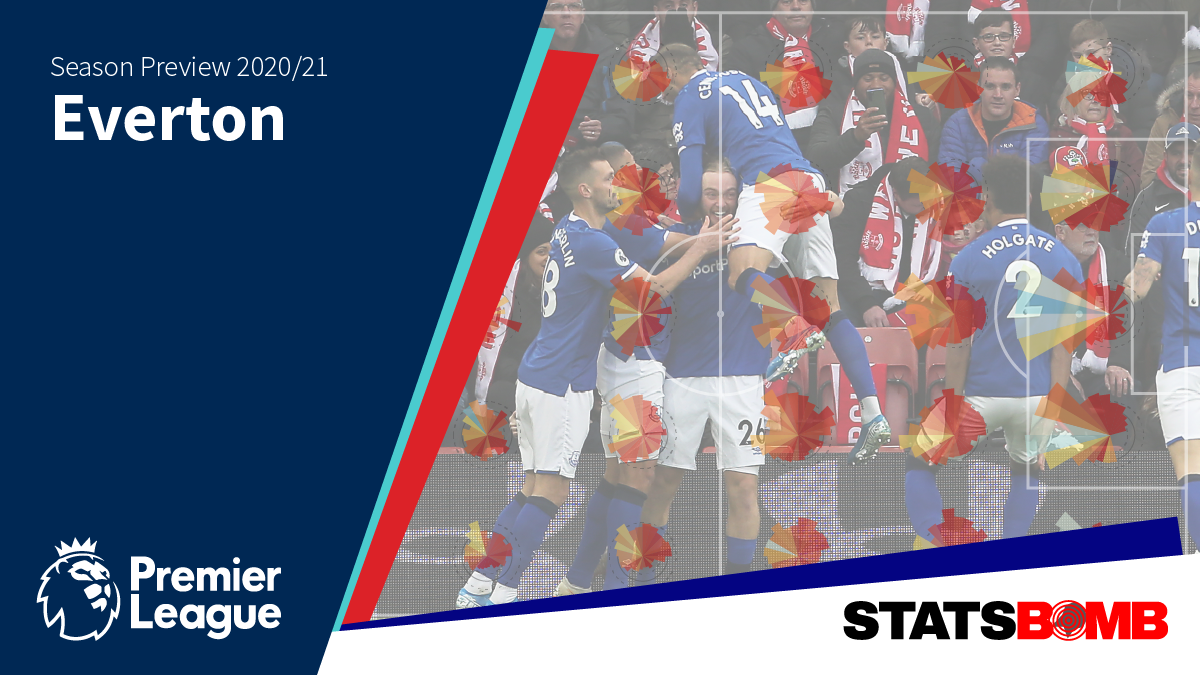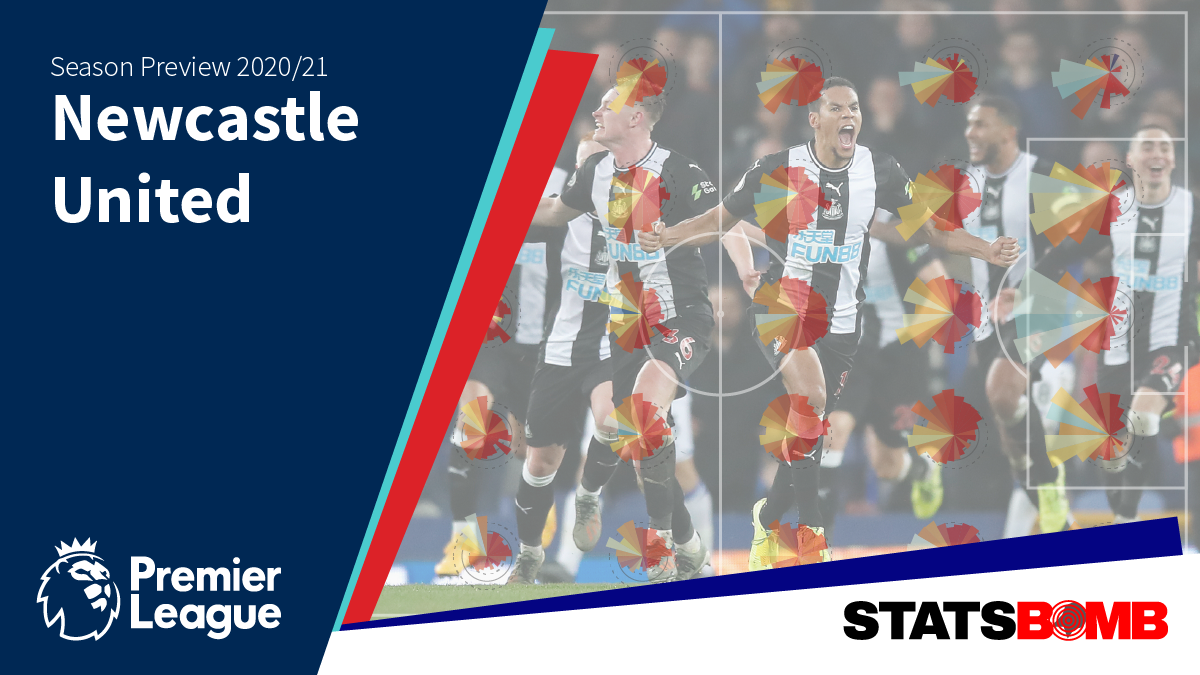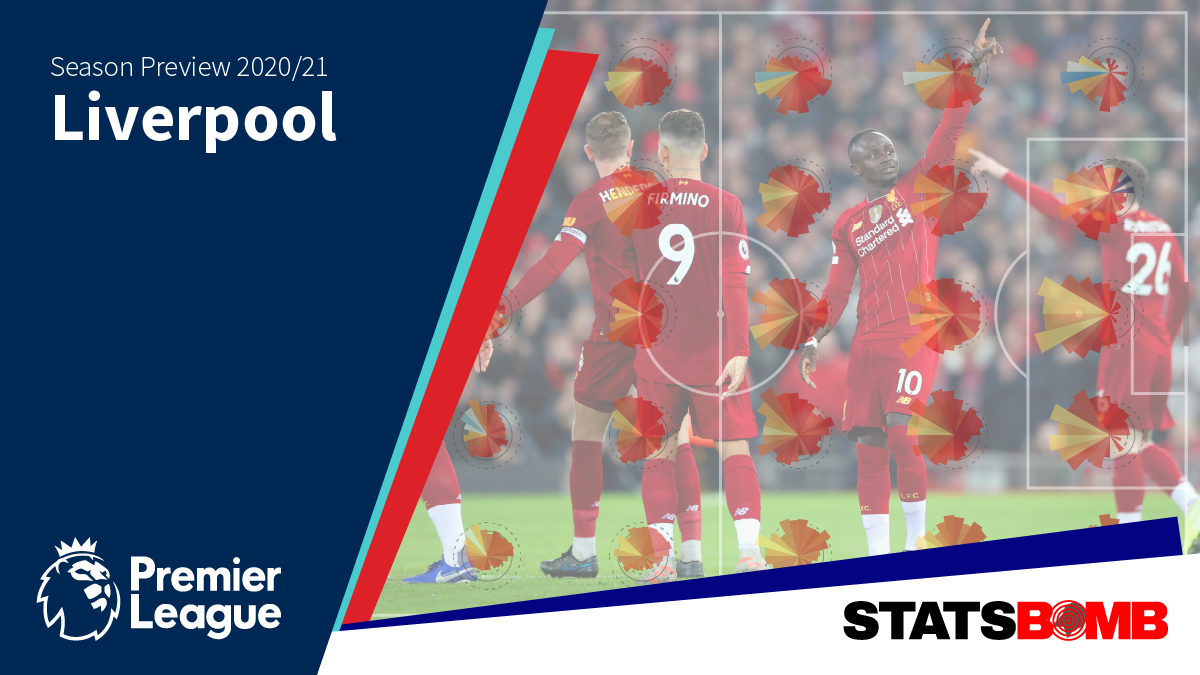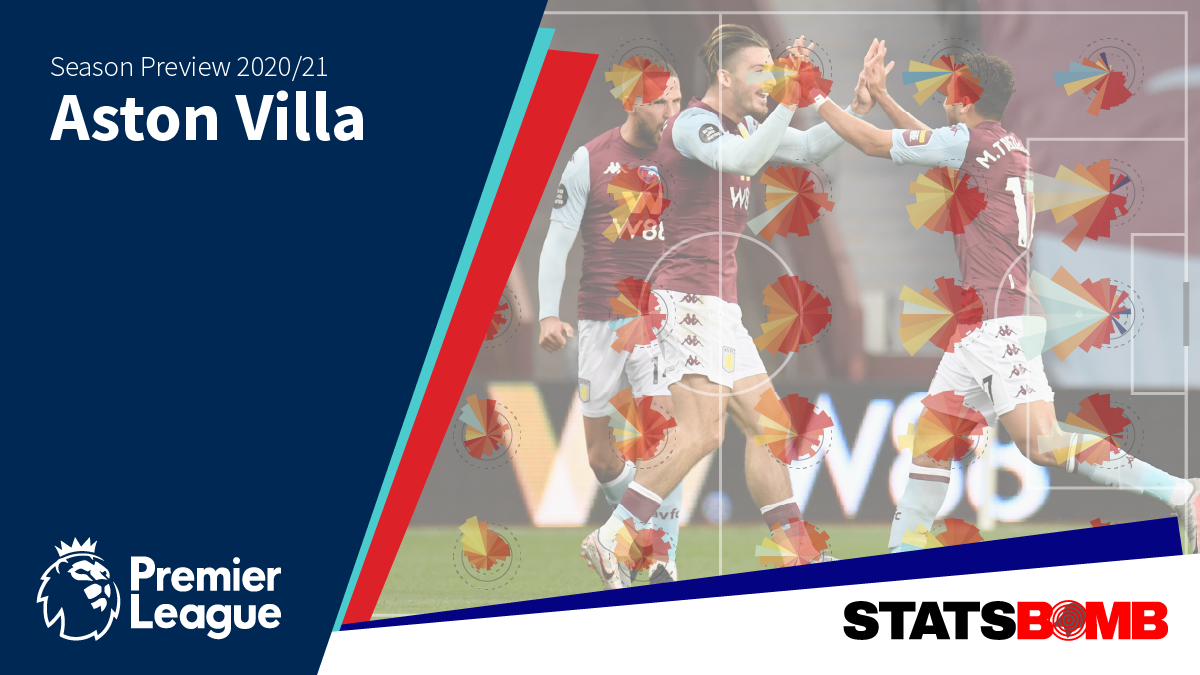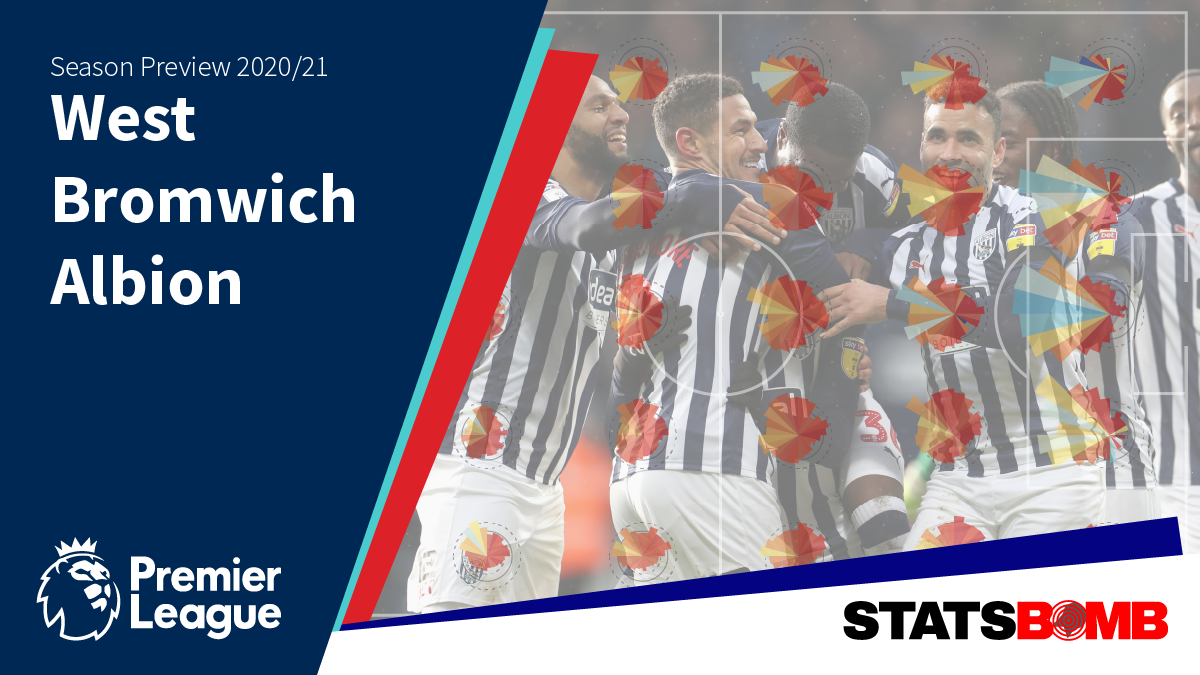Leeds are back in the top flight after more than a decade and a half away and the consensus seems to be that they are here to stay. Both the mainstream bookmakers and the spread betting markets have them in line for a mid-table finish, and they’ve certainly spent like a team determined to reestablish themselves as a genuine Premier League outfit. James has already written an excellent piece on the club’s promotion campaign, so we won’t go into too much detail about that here, but here are the salient points. Leeds had the best metrics in the Championship for two seasons in a row. After failing to convert that into promotion in 2018-19 due to a bad run of results down the final stretch, they did so in 2019-20, going up as champions. 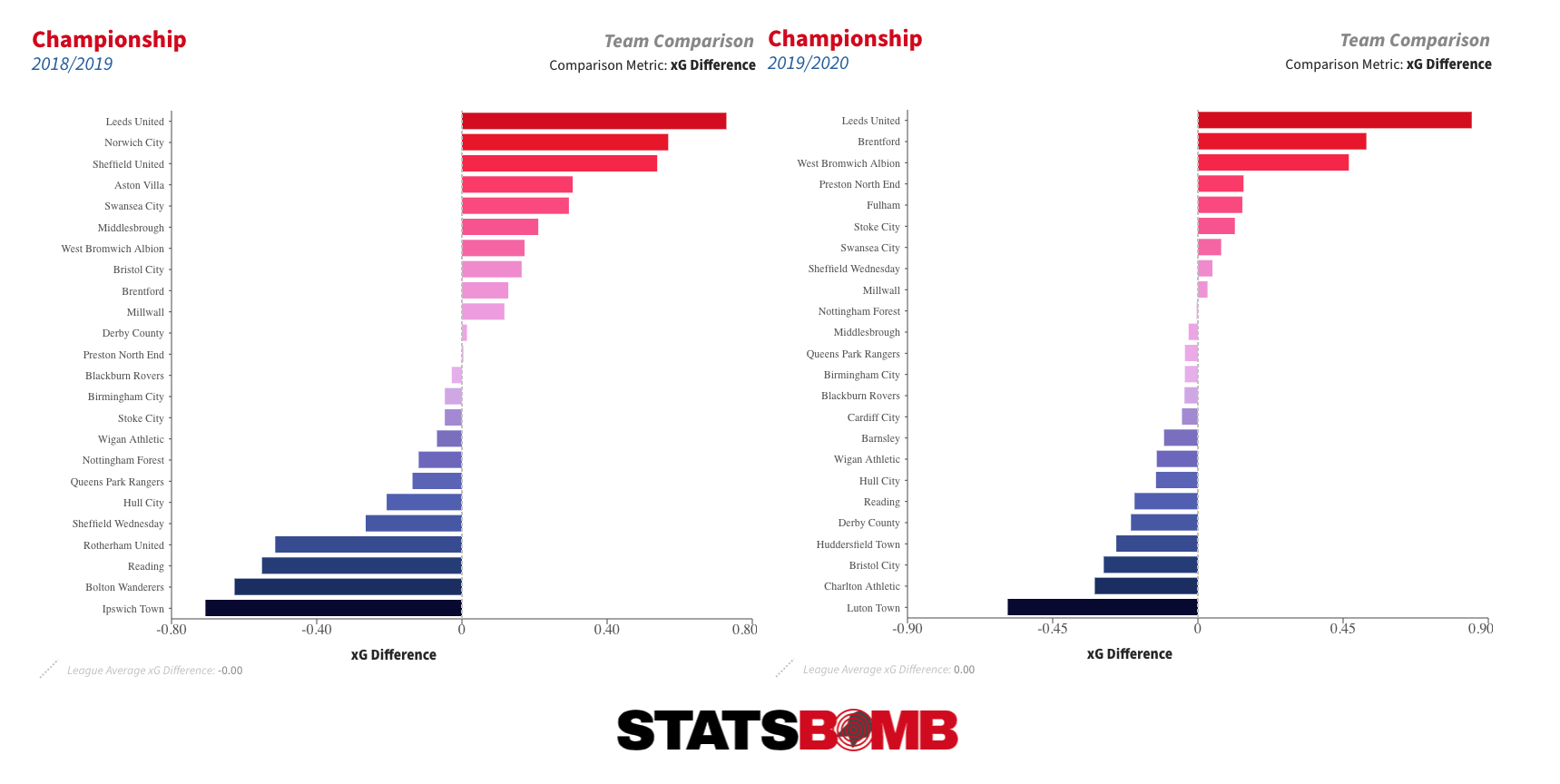 The club’s defensive record was particularly strong. They conceded just 35 times in 46 matches and also had the league’s best metrics. They gave up fewer shots (8.78 per match) than any other side, and the average quality of those shots was also one of the lowest in the division.
The club’s defensive record was particularly strong. They conceded just 35 times in 46 matches and also had the league’s best metrics. They gave up fewer shots (8.78 per match) than any other side, and the average quality of those shots was also one of the lowest in the division. 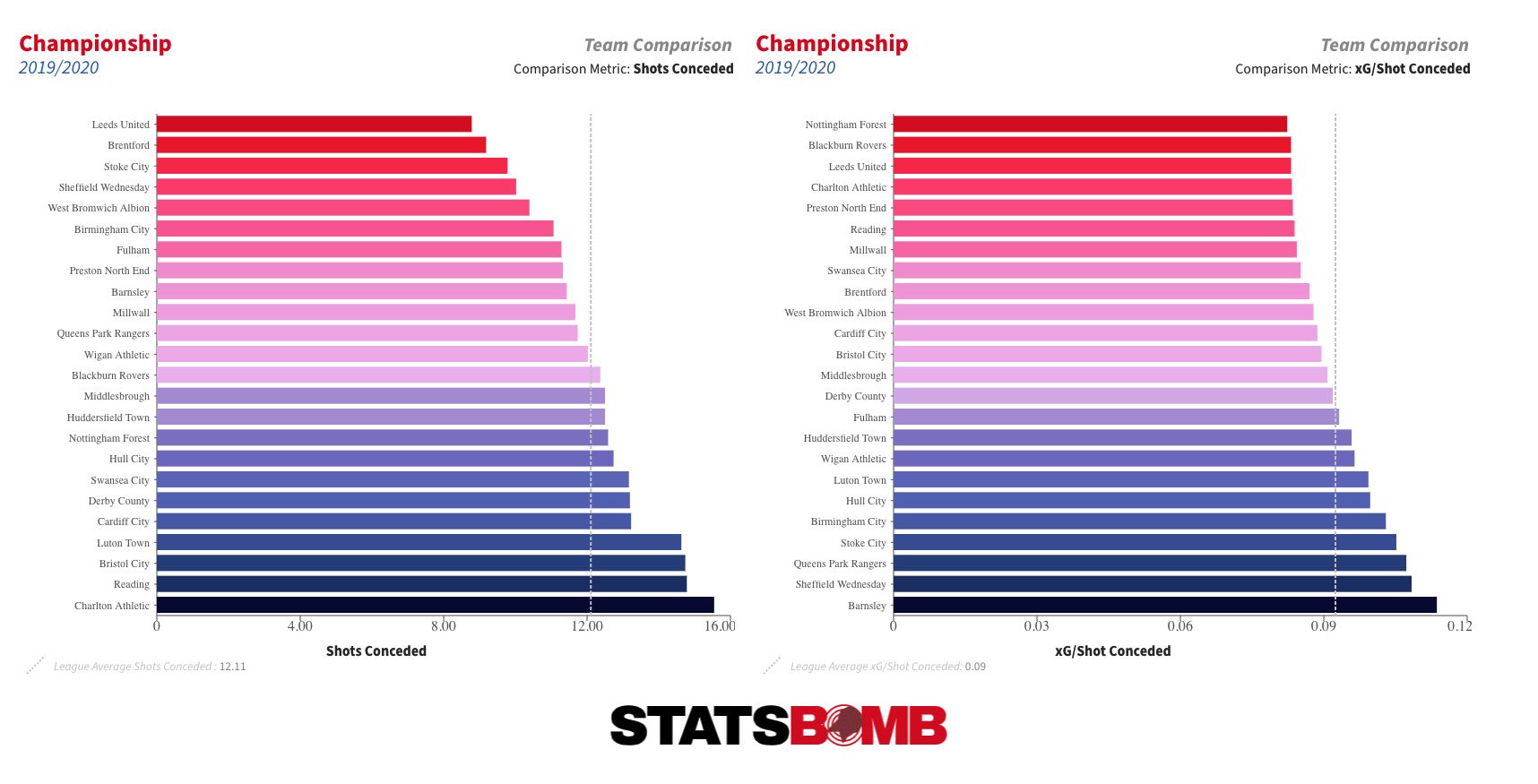 That was partly down to the efficiency of Marcelo Bielsa’s patented all-pitch press. Leeds were relentless in harrying opponents over the length and breadth of the field.
That was partly down to the efficiency of Marcelo Bielsa’s patented all-pitch press. Leeds were relentless in harrying opponents over the length and breadth of the field. 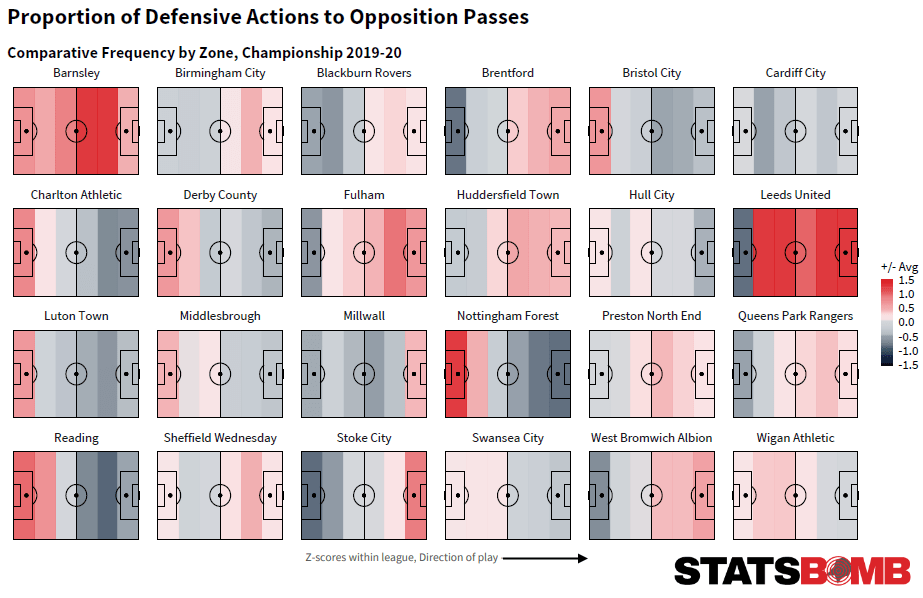 In attack, they comfortably outshot everyone, and did so while still maintaining one of the highest average shot quality marks in the league. All that off-ball movement, the pretty patterns and interchanges, helped to create a high volume of shots from good locations.
In attack, they comfortably outshot everyone, and did so while still maintaining one of the highest average shot quality marks in the league. All that off-ball movement, the pretty patterns and interchanges, helped to create a high volume of shots from good locations. 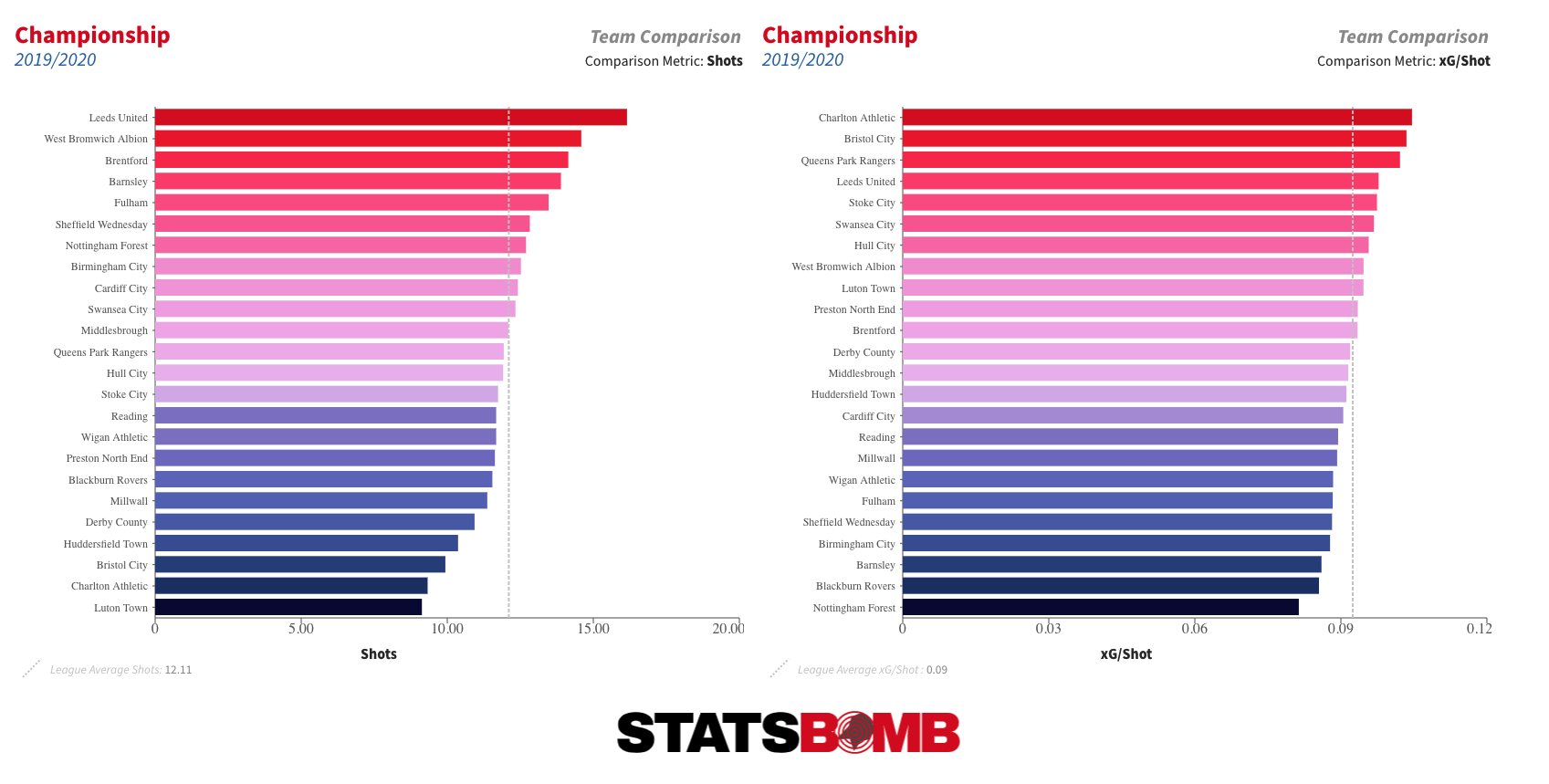 Whichever way you look at it, Leeds were a dominant team, taking 65% of the shots, accumulating 68% of the xG and scoring 69% of the goals in their matches. A clearly defined play style, strong overall metrics and a solid defensive base are all generally predictive of a good first campaign in the top flight. To illustrate this point, over the last 10 years, only two teams have been promoted with a better average goal difference per match than Leeds’ figure of 0.91: Newcastle in 2016-17 and Wolverhampton Wanderers in 2017-18. Like Leeds, both conceded under a goal per match during their promotion campaigns. Both went on to only concede around 17% more goals in the Premier League, compared to an average for promoted teams of around 40%, and both finished in the top 10. Leeds have a good base to work from, and they've also been able to retain almost all of the important squad members from their promotion campaign. Hélder Costa and young goalkeeper Illan Meslier, who got a run of games as first choice after lockdown due to Kiko Casilla’s suspension for racist language, have both had their loans turned into permanent deals. Jack Harrison will stay on board for another season on loan from Manchester City. The one key departure is that of Brighton loanee Ben White. He started all 46 matches last season, and became a key figure in the centre of defence, impressing on both sides of the ball. Reports suggest that Leeds were keen to sign him permanently, but Brighton instead decided to bring him back into the fold there. It was, therefore, unsurprising that one of the club’s first off-season signings was Robin Koch, a 24-year-old central defender from Freiburg in the Bundesliga, capped three times by Germany. White was the more proactive defender in his regular partnership with Liam Cooper, stepping forward more often to contest possession and intercept, both on a outright basis and proportionally to all defensive actions when they started together in the centre of defence. Cooper cleaned up behind and was a dominant aerial force. Koch seems to profile more like Cooper than White, with a lesser proportion of proactive defensive actions than the man he replaces. But it is important to add some context here. Freiburg were one of the most passive and deep-defending teams in the Bundesliga last season, and Koch often played as the central of three central defenders. In such a system, it is entirely normal for the player in that role to be the least proactive of the three. As such, it is hard to get a handle on just how apt a White replacement he is from the data. Their passing profiles are more similar, and Koch does seem to have solid range there. Qualitative scouting has presumably left the recruitment team confident that he can slot into White’s role. Cooper was again the less proactive element in his partnership with Pontus Jansson in 2018-19, so there is little evidence he’d be capable of defending in a different manner. As well as Koch, Leeds have also signed a trio of younger players in Charlie Allen (16), Cody Drameh (18) and Joe Gelhardt (18), the latter of whom posted good shot volume in a very limited sample size of just over 500 minutes at Wigan in the Championship last season. But the big money has been spent on the club-record, £27 million signing of Rodrigo from Valencia. Readers with good memories may recall Rodrigo from his one-season loan at Bolton Wanderers back in 2010-11, but the player who arrives at Elland Road has developed considerably since then and is now a full Spain international. He, like the entire Valencia team, didn’t have a great time of it last season, but in 2018-19, he provided a goal or assist for every 180 minutes he was on the pitch in terms of both real and expected output.
Whichever way you look at it, Leeds were a dominant team, taking 65% of the shots, accumulating 68% of the xG and scoring 69% of the goals in their matches. A clearly defined play style, strong overall metrics and a solid defensive base are all generally predictive of a good first campaign in the top flight. To illustrate this point, over the last 10 years, only two teams have been promoted with a better average goal difference per match than Leeds’ figure of 0.91: Newcastle in 2016-17 and Wolverhampton Wanderers in 2017-18. Like Leeds, both conceded under a goal per match during their promotion campaigns. Both went on to only concede around 17% more goals in the Premier League, compared to an average for promoted teams of around 40%, and both finished in the top 10. Leeds have a good base to work from, and they've also been able to retain almost all of the important squad members from their promotion campaign. Hélder Costa and young goalkeeper Illan Meslier, who got a run of games as first choice after lockdown due to Kiko Casilla’s suspension for racist language, have both had their loans turned into permanent deals. Jack Harrison will stay on board for another season on loan from Manchester City. The one key departure is that of Brighton loanee Ben White. He started all 46 matches last season, and became a key figure in the centre of defence, impressing on both sides of the ball. Reports suggest that Leeds were keen to sign him permanently, but Brighton instead decided to bring him back into the fold there. It was, therefore, unsurprising that one of the club’s first off-season signings was Robin Koch, a 24-year-old central defender from Freiburg in the Bundesliga, capped three times by Germany. White was the more proactive defender in his regular partnership with Liam Cooper, stepping forward more often to contest possession and intercept, both on a outright basis and proportionally to all defensive actions when they started together in the centre of defence. Cooper cleaned up behind and was a dominant aerial force. Koch seems to profile more like Cooper than White, with a lesser proportion of proactive defensive actions than the man he replaces. But it is important to add some context here. Freiburg were one of the most passive and deep-defending teams in the Bundesliga last season, and Koch often played as the central of three central defenders. In such a system, it is entirely normal for the player in that role to be the least proactive of the three. As such, it is hard to get a handle on just how apt a White replacement he is from the data. Their passing profiles are more similar, and Koch does seem to have solid range there. Qualitative scouting has presumably left the recruitment team confident that he can slot into White’s role. Cooper was again the less proactive element in his partnership with Pontus Jansson in 2018-19, so there is little evidence he’d be capable of defending in a different manner. As well as Koch, Leeds have also signed a trio of younger players in Charlie Allen (16), Cody Drameh (18) and Joe Gelhardt (18), the latter of whom posted good shot volume in a very limited sample size of just over 500 minutes at Wigan in the Championship last season. But the big money has been spent on the club-record, £27 million signing of Rodrigo from Valencia. Readers with good memories may recall Rodrigo from his one-season loan at Bolton Wanderers back in 2010-11, but the player who arrives at Elland Road has developed considerably since then and is now a full Spain international. He, like the entire Valencia team, didn’t have a great time of it last season, but in 2018-19, he provided a goal or assist for every 180 minutes he was on the pitch in terms of both real and expected output.  Valencia were a counter-attacking team and Rodrigo was often a key part of their forward transitions, dropping off the front to receive, turn and combine with onward runners. Quick and intelligent in his movements, he has a skillset that should mesh well with Bielsa’s system, even if, as with Koch, he comes in from a team considerably less aggressive out of possession than this current Leeds side. The age profile isn’t great, but he should prove to be a direct improvement on Patrick Bamford at the centre of the attack. Leeds have also shown strong interest in Rodrigo de Paul, a creative midfielder who has been pretty consistently good at Udinese over the last couple of seasons. He doesn’t provide a great deal of defensive output, but the old Bielsa motto of it being easier to teach a talented player to run than make an energetic player talented may just ring true here. He would certainly represent an upgrade in one of the two more advanced midfield roles in the 4-1-4-1/4-3-3 that has served Leeds so well over the last couple of seasons.
Valencia were a counter-attacking team and Rodrigo was often a key part of their forward transitions, dropping off the front to receive, turn and combine with onward runners. Quick and intelligent in his movements, he has a skillset that should mesh well with Bielsa’s system, even if, as with Koch, he comes in from a team considerably less aggressive out of possession than this current Leeds side. The age profile isn’t great, but he should prove to be a direct improvement on Patrick Bamford at the centre of the attack. Leeds have also shown strong interest in Rodrigo de Paul, a creative midfielder who has been pretty consistently good at Udinese over the last couple of seasons. He doesn’t provide a great deal of defensive output, but the old Bielsa motto of it being easier to teach a talented player to run than make an energetic player talented may just ring true here. He would certainly represent an upgrade in one of the two more advanced midfield roles in the 4-1-4-1/4-3-3 that has served Leeds so well over the last couple of seasons. 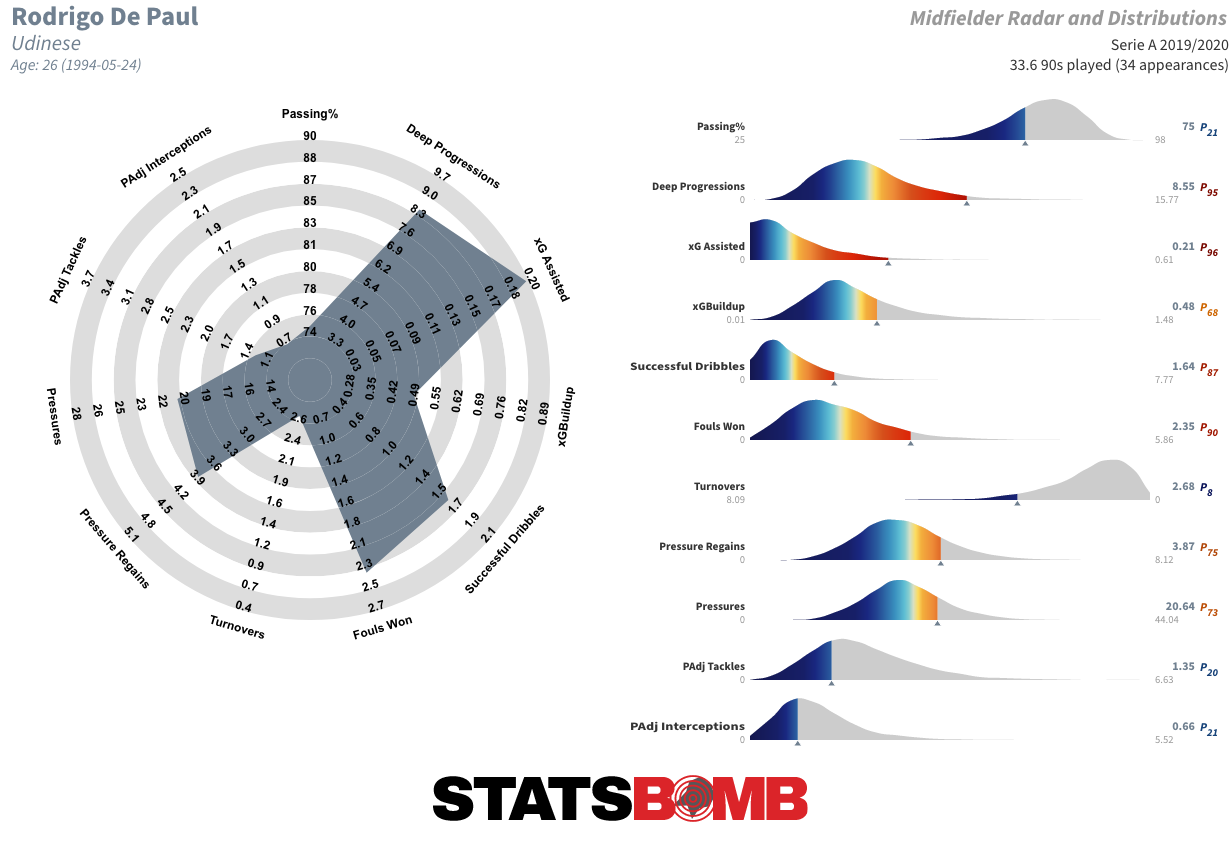 Maintaining a stable squad while upgrading in key positions seems a sensible way of confronting the club’s first Premier League season in 16 years, even though there is still a degree of uncertainty in terms of the performance levels that can be expected from some of the existing squad members. Many of these players were, after all, involved in a mid-table Championship finish in the season before Bielsa’s arrival. Any individual deficiencies will be that much clearer in the top flight. With that said, the front-foot style of play of the collective should be sufficient to get Leeds enough points from some of the league’s blander teams to provide a solid platform for a mid-table finish. Theirs is an exciting approach and it will be intriguing to see how they fare in their attempts to go toe-to-toe with teams towards the top of the table. An opening day trip to Anfield and champions Liverpool will give us an early taste of what to expect.
Maintaining a stable squad while upgrading in key positions seems a sensible way of confronting the club’s first Premier League season in 16 years, even though there is still a degree of uncertainty in terms of the performance levels that can be expected from some of the existing squad members. Many of these players were, after all, involved in a mid-table Championship finish in the season before Bielsa’s arrival. Any individual deficiencies will be that much clearer in the top flight. With that said, the front-foot style of play of the collective should be sufficient to get Leeds enough points from some of the league’s blander teams to provide a solid platform for a mid-table finish. Theirs is an exciting approach and it will be intriguing to see how they fare in their attempts to go toe-to-toe with teams towards the top of the table. An opening day trip to Anfield and champions Liverpool will give us an early taste of what to expect.
If you're a club, media or gambling entity and want to know more about what StatsBomb can do for you, please contact us at Sales@StatsBomb.com We also provide education in this area, so if this taste of football analytics sparked interest, check out our Introduction to Football Analytics course Follow us on twitter in English and Spanish and also on LinkedIn
Few managers last as long as Sean Dyche.
Closing in on eight years in the Burnley hotseat, the relegation of Eddie Howe and Bournemouth means that he is the longest serving manager in the division. This will be Burnley’s fifth consecutive season in the Premier League and their run to a tenth placed finish in 2019-20 was almost entirely unheralded. The seventh placed finish of 2017-18 clearly took the narrative gust out of this similarly impressive season. This time round they scored exactly the same amount of points (54) but actually won more games (15 to 14). They also did a good job of bouncing back from the lesser season in the middle by chipping a whopping 18 goals from their against total (50 down from 68).
After a run of 4 defeats around New Year, they lost just twice in sixteen games; firstly a 5-0 thumping from Man City, which is the kind of thing that can happen to anyone, and lastly a final day defeat to Brighton. Seven other games against top half teams yielded two wins, and five draws. In the main they were tough to beat in the extended back half of the season. Did the metrics like them too?
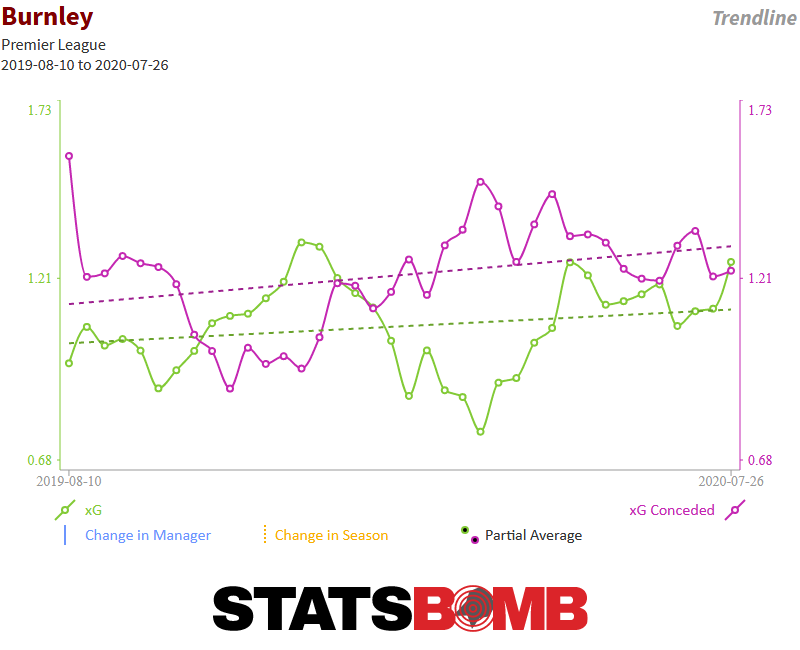
Well, yes and no?
For long swathes of the season, Burnley’s xG conceded exceeded that which they gained. This isn’t unusual though--it’s been the same in all their last four seasons--but in the aggregate, this was the best of the four seasons since promotion and it scoped out only a shade under par (-0.08xG per game). We can see how they cut out the bad games in comparison to 2018-19 if we look at their expected goals value by game here:
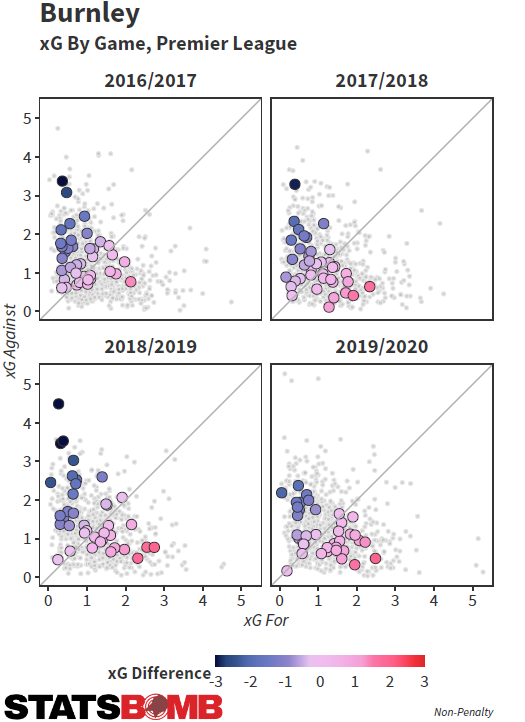
Average metrics, average league position, but a far from average method of getting the job done. Burnley remain unique and flagbearers for their specific and effective style of play. There are a few simple principles that persist season to season:
1. Don't get sent off
Burnley have received three red cards in four seasons. That equates to around once every 50 games. It is a lower rate than any other team that has been in the league during that period. They receive a medium to high volume of yellow cards, but scarcely leave the pitch with less than eleven men.
2. Don't worry about giving up shots
Conceptually, giving up shots is a bad idea. If your opponent doesn't shoot, they can't often score. Burnley don't care so much about that, because although they always give up a ton of shots, the average value of these shots is frequently among the league's lowest and therefore best:
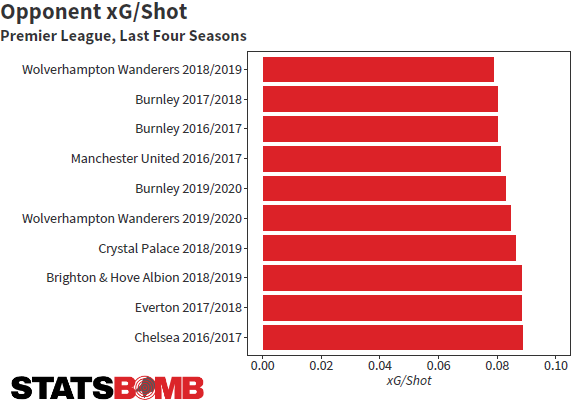
The two good seasons Burnley have had recently--2017-18 and 2019-20--have seen them give up around 14 to 15 shots per game. Their lesser seasons--2016-17 and 2018-19 have seen this at a higher level closer to 17 or 18. However, when measured, thanks in some part to the defensive positioning we have in our model, we can see that the quality of those shots is still in the main low. During 2019-20 they had more defenders behind the ball than any other team and more defenders within a cone that defines the route to goal. Filter down to just inside the box and this still holds. What other impact could stationing more players between the shooter and the goal have?
3. An army of defenders can block shots
Guess what? Burnley consistently block a higher proportion of opponent shots than the rest of the league:
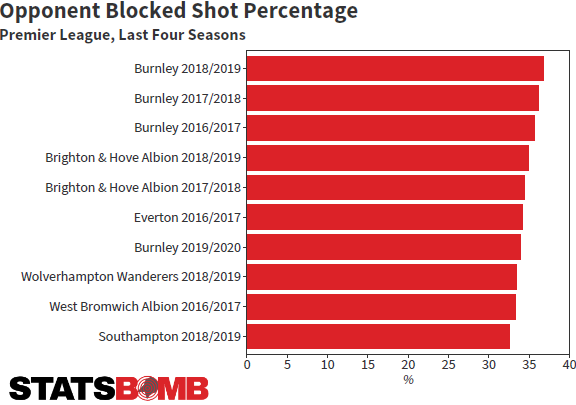
The argument between tactical choice and necessity can rage on elsewhere, but this is what Burnley do in their own box.
What do they do at the other end?
4. Bombard the box
Burnley take a lot of shots from close in. A bunch of these are headers (they rank highly there too as a percentage of all shots) and a bunch of these are set pieces, inswinging corners and the like. But at least in some regard, they get it. Burnley get that scoring is easier the closer you are to goal. This chart is filtered to 10 yards, but you can move that line around and the message is still the same:
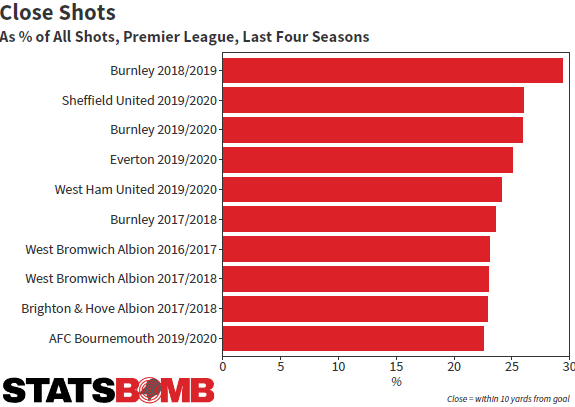
5. Thou shalt not dribble
...unless you're Dwight McNeil. Overall Burnley rank 20th/20 for each of the last four seasons for dribbles attempted and completed. There is some logic here when factored alongside the other stylistic tics. For example, if you're trying to beat an opponent, you may fail to do so and give the ball away in a bad position and your defence maybe caught short. Best if this doesn't happen at all?
NcNeil's two successful dribbles per 90 ranks 41st in the Premier League for players with over 900 minutes. So it is not as if he is wantonly skipping past opposing right backs at will but he is the one player empowered to do so. Jeff Hendrick was the only other player recording more than one per 90 last season, and he now plays for another team.
McNeil is an outlier for other reasons too. There are very few out and out left footed left wingers in the league these days. Indeed, Leroy Sané's departure to Bayern Munich shears the most prominent example of such a player away and even he may end up playing on the right. Left footed wingers tend to get inverted these days. McNeil is also, by a large margin, the only young player in Burnley's squad to have seen any significant game time in any of the last four seasons and he's only been getting significant minutes the last two.
6. If you can't grow a full beard, you're too young, unless you're Dwight McNeil
Full beard or not, at 20 years old, McNeil is a full four years younger than the next youngest first teamer in the squad, January signing from Bristol City, Josh Brownhill.
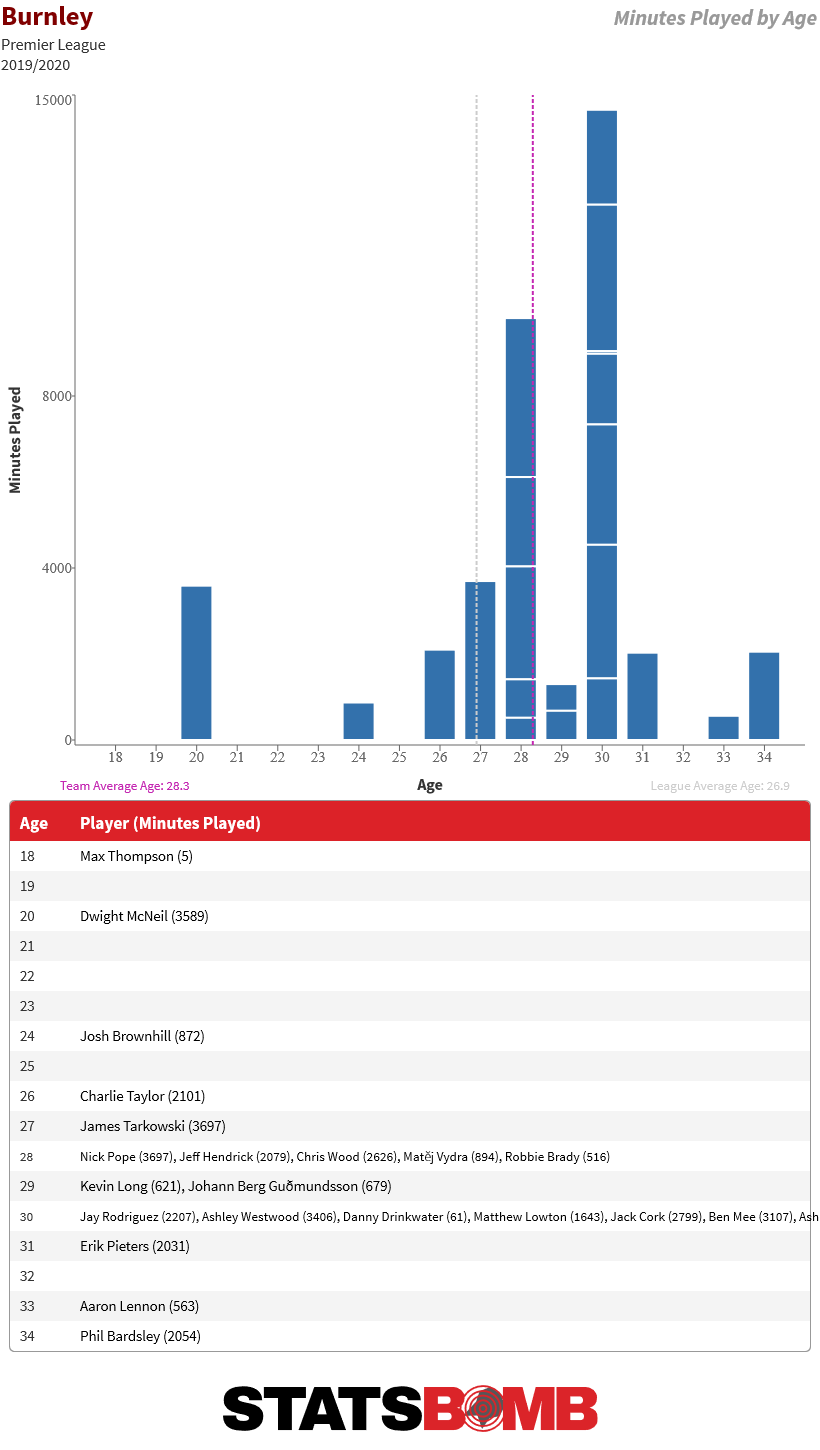
Right now, this team isn't too old. But it's not far from a situation where too many of the squad are over 30. One can hope that the Brownhill signing is a clear recognition of this issue, but with the club quiet so far in this summer transfer window, there is precious little evidence to see what extra remedial work they're going to do.
7. You better be able to play 90 minutes
Sean Dyche isn't going to be voting for five substitutes any time soon. Pre-lockdown, Burnley averaged the fewest substitutions in the league at a solid two per game. Given free reign to run amok and make five substitutions amid a heavy schedule and summer temperatures, Dyche did nothing of the sort and made fewer substitutions. There are interesting angles that have been thrown up since the idea of five substitutes became reality. Do too many substitutions interrupt team cohesion? Can the mysterious momentum be halted by too many personnel changes? Regardless of the truth here, Burnley do it their way and are unlikely to change.
8. We will press you but only where we want to
Burnley's 2019-20 pass-to-press chart was probably the most intriguing of any team in the division. When held up against their previous seasons, we can see that it's actually a subtle but fairly long term trend:
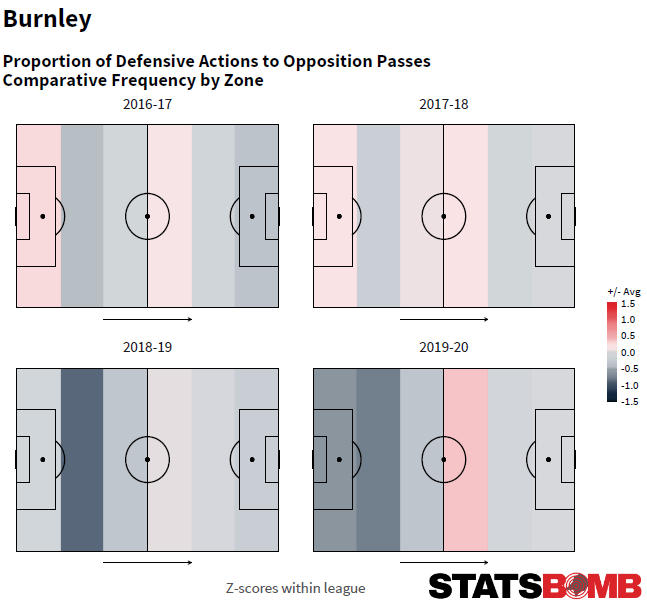
Ahead of the half way line, Burnley will press opponents on the ball. In the rest of the pitch far less so. Our aggression metric, which measures how many opponent ball receipts are pressed within two seconds ranks Burnley in 19th position. And we can see both very high up the pitch and in defensive areas, Burnley will sit off. However, they record a higher percentage of their pressure events in the opposition half than any other teams bar Liverpool and Manchester City, and they are not idle with it, as the 77% of counter pressures (within five seconds of an opposition turnover) they record also ranks highly, fourth. This is a team that deploys specific and differing strategies towards the opposition depending where they are on the pitch.
Projection
While I appreciate that not every team can have a positive profile and point upwards this season, it appears to me that Sporting Index's opening points projection for Burnley is on the low side at around 40. Outside of a legitimately horrific run of metrics in the first half of 2018-19, for the last three seasons, Burnley have shown themselves to be a fairly comfortable mid-table Premier League side. There are warnings to be heeded around the squad aging, and perhaps the squad size, but with Dyche apparently set to stay on--after some off season rumours that his time at the club was coming to an end--the club appears as set as it ever is to confound the naysayers and persist within the league. Whenever the day comes that Dyche does leave, the job of following him will no doubt be extremely difficult and that moment could well be a crux point for the team's retained Premier League status, but we're not there yet, and as such, Burnley in 2020-21 should be entirely fine.
If you're a club, media or gambling entity and want to know more about what StatsBomb can do for you, please contact us at Sales@StatsBomb.com
We also provide education in this area, so if this taste of football analytics sparked interest, check out our Introduction to Football Analytics course
Follow us on twitter in English and Spanish and also on LinkedIn
Let’s start with a question. Did Fulham deserve to go up? A provocative query and, sure, it suggests I’m going to lead the argument down a certain path but, before you blow your thatched rooftops Cottagers fans, the answer is actually both yes and no. Let me explain. Scott Parker was handed the managerial reins on a permanent basis last summer, after his caretaker stint at the end of their Premier League relegation season. An immediate return to the top flight was a realistic expectation as the majority of the side that achieved promotion in style under Slaviša Jokanović in 2017/18 was retained. Parker, himself having played under Jokanović, set about implementing a similar high-possession framework to the side that went up two seasons prior and he succeeded; at 61%, Fulham were second only to Leeds in average ball possession. Something wasn’t quite the same though. Under Slaviša, it was swashbuckling. Under Parker, it was pedestrian. Previously, it was possession as a means to attack, now it seemed to be possession as a means to defend. Relative to their promotion rivals, the Cottagers struggled to turn their ball and territory control into meaningful goalscoring opportunities and it left them always seemingly hanging onto the coattails of the top two rather than leading the charge with them. The big issue was that the side very rarely took advantage of the space available in transition when winning the ball back. Quickly (ironically), the ball would get circulated between midfield and defence until the opposition had managed to reset themselves into their defensive shape, the result being that Fulham had the slowest Pace To Goal – the average speed (in metres per second) of buildup play that results in a shot - in the Championship by some way. 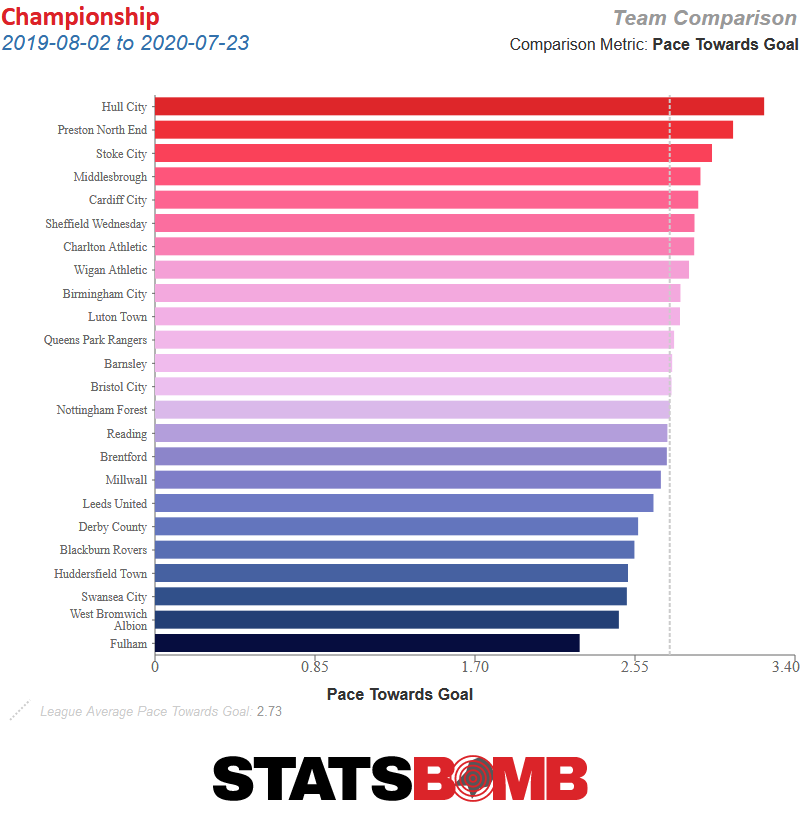 Their aversion to breaking quickly was evident in the lack of counter attacking opportunities generated, something that Jokanović’s side were not afraid to do if the space was available.
Their aversion to breaking quickly was evident in the lack of counter attacking opportunities generated, something that Jokanović’s side were not afraid to do if the space was available. 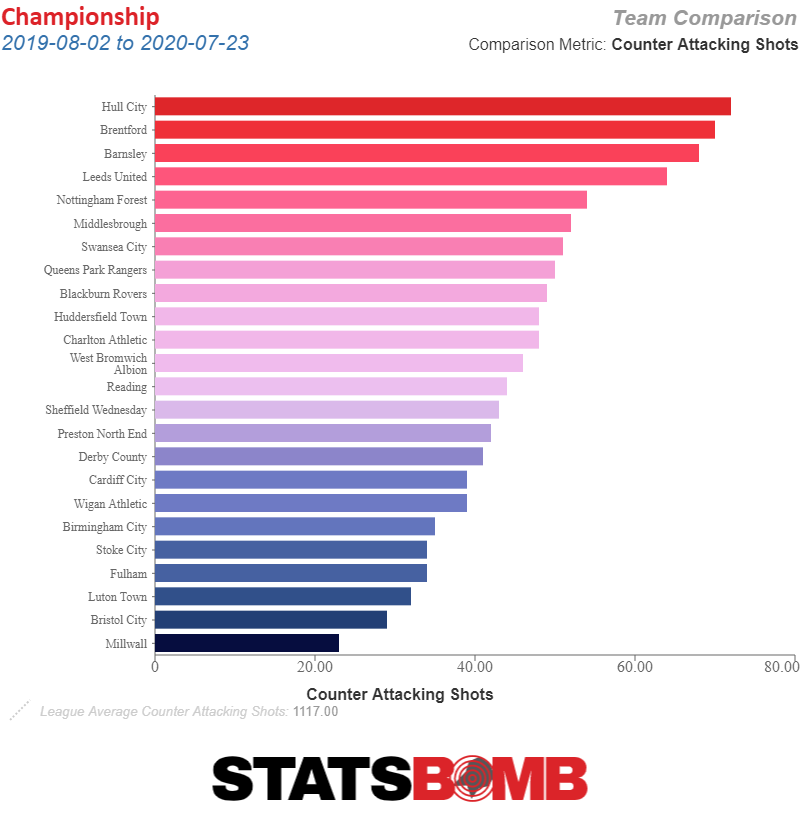 Logic dictates that you’re only going to make things more difficult for yourself if you commit to attacking against a set defence all the time and it was evident in the metrics; Fulham’s 1.18xG created per game was some way behind promotion rivals Brentford (1.33xG), West Brom (1.38xG), and Leeds (1.58xG) and others too, ranking 7th in the Championship across the regular season. Of course, there’s a balance to be struck and Fulham built a reputation for grinding out victories on the foundation of a sturdy defence, Parker’s pragmatism at least paying off at the other end of the pitch. 17 clean sheets was a total beaten only by champions Leeds, and Fulham also had a remarkable record of staying in front once they were ahead, conceding just five equalising goals in the entire season and going W21 D3 L0 in the 24 games they took the lead in. Despite that sterling record, the fans certainly weren’t particularly impressed with the regularity they were seeing their side take a lead and then sit on it rather than pushing on. Of Fulham’s 23 victories, 15 of them were by a single goal. However, there’s a real and unexpected quirk about their game state metrics. When in front, at score lines you’d expect the opposition to be having the better of the game and putting Fulham under pressure in search of an equaliser, Fulham actually created more, notching up 16.91xG to their opponents 14.24xG. They were also creating more than the opposition when scores were level, as you’d expect of a good side. Less relevant but just as weird, Fulham actually seemed to struggle most when they went behind, creating 13.79 xG to the opposition’s 14.78xG - potentially an ominous sign ahead of a season when they’ll expect to be behind more often than ahead. In summary, Fulham finished 4th in the table, had the 4th best goal difference and the 5th best expected goal difference. That’s pretty conclusive evidence to say that Fulham were, at best, the 4th best side in the division, no? Ergo, is it deserved that they were one of the three sides to go up? Well here comes the other side of the argument because of course I’m not going to ignore what happened in the play-offs. Where Parker’s pragmatism had given cause for complaint in the regular season, all of a sudden it was an asset to the task in front of them. Fulham played the first leg of their semi-final against Cardiff perfectly, conceding just six shots, and it’s hard to ask for a better result than to take a 2-0 lead away from home in the first leg. They finished the job at Craven Cottage, successfully defending a one goal aggregate lead for the entirety of the second half.
Logic dictates that you’re only going to make things more difficult for yourself if you commit to attacking against a set defence all the time and it was evident in the metrics; Fulham’s 1.18xG created per game was some way behind promotion rivals Brentford (1.33xG), West Brom (1.38xG), and Leeds (1.58xG) and others too, ranking 7th in the Championship across the regular season. Of course, there’s a balance to be struck and Fulham built a reputation for grinding out victories on the foundation of a sturdy defence, Parker’s pragmatism at least paying off at the other end of the pitch. 17 clean sheets was a total beaten only by champions Leeds, and Fulham also had a remarkable record of staying in front once they were ahead, conceding just five equalising goals in the entire season and going W21 D3 L0 in the 24 games they took the lead in. Despite that sterling record, the fans certainly weren’t particularly impressed with the regularity they were seeing their side take a lead and then sit on it rather than pushing on. Of Fulham’s 23 victories, 15 of them were by a single goal. However, there’s a real and unexpected quirk about their game state metrics. When in front, at score lines you’d expect the opposition to be having the better of the game and putting Fulham under pressure in search of an equaliser, Fulham actually created more, notching up 16.91xG to their opponents 14.24xG. They were also creating more than the opposition when scores were level, as you’d expect of a good side. Less relevant but just as weird, Fulham actually seemed to struggle most when they went behind, creating 13.79 xG to the opposition’s 14.78xG - potentially an ominous sign ahead of a season when they’ll expect to be behind more often than ahead. In summary, Fulham finished 4th in the table, had the 4th best goal difference and the 5th best expected goal difference. That’s pretty conclusive evidence to say that Fulham were, at best, the 4th best side in the division, no? Ergo, is it deserved that they were one of the three sides to go up? Well here comes the other side of the argument because of course I’m not going to ignore what happened in the play-offs. Where Parker’s pragmatism had given cause for complaint in the regular season, all of a sudden it was an asset to the task in front of them. Fulham played the first leg of their semi-final against Cardiff perfectly, conceding just six shots, and it’s hard to ask for a better result than to take a 2-0 lead away from home in the first leg. They finished the job at Craven Cottage, successfully defending a one goal aggregate lead for the entirety of the second half. 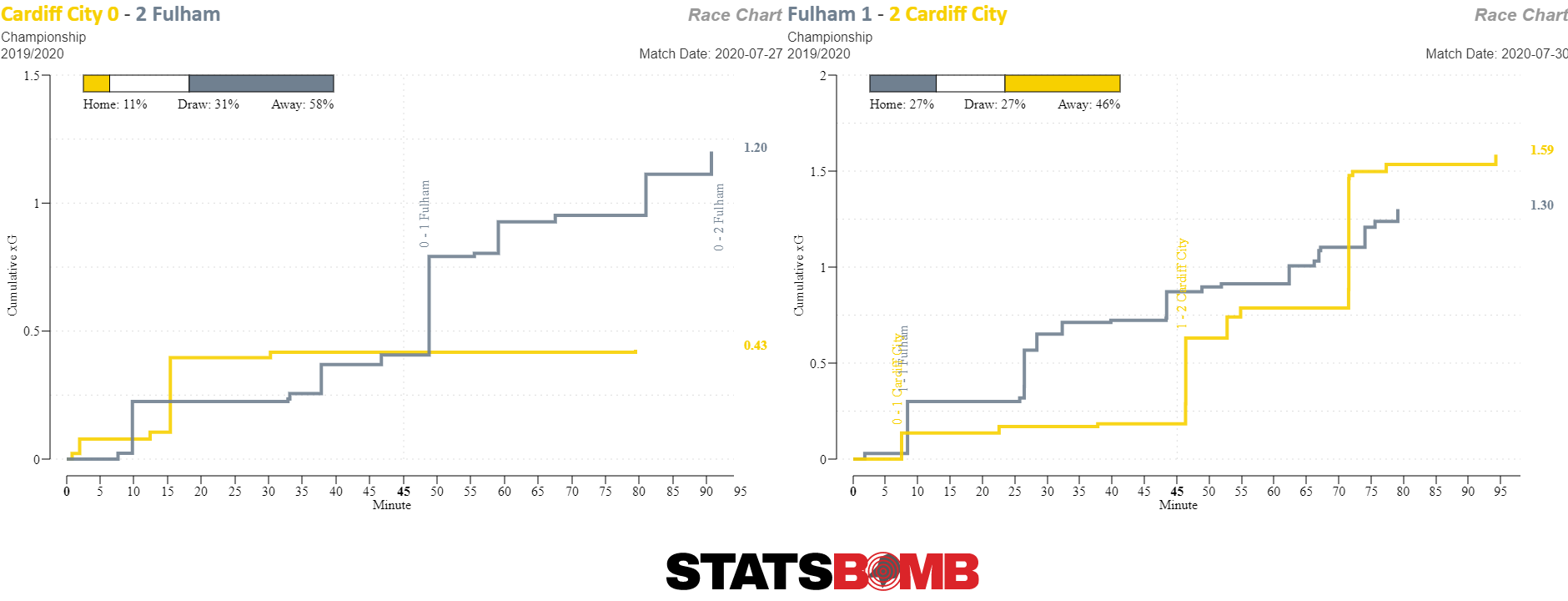 It was a similar story in the final. Fulham focused less on retaining the ball and more on preventing Brentford, and particularly Saïd Benrahma, from playing, staying in a more compact shape than usual but more importantly selecting the more energetic Bobby Reid ahead of Championship top goalscorer Aleksandar Mitrović in order to give them more mobility in leading the press and more pace on the counter. The result was an even game with the deadlock only broken by a moment of individual quality which I’m almost certain you’ll have seen if you’re reading this, but if not:
It was a similar story in the final. Fulham focused less on retaining the ball and more on preventing Brentford, and particularly Saïd Benrahma, from playing, staying in a more compact shape than usual but more importantly selecting the more energetic Bobby Reid ahead of Championship top goalscorer Aleksandar Mitrović in order to give them more mobility in leading the press and more pace on the counter. The result was an even game with the deadlock only broken by a moment of individual quality which I’m almost certain you’ll have seen if you’re reading this, but if not: 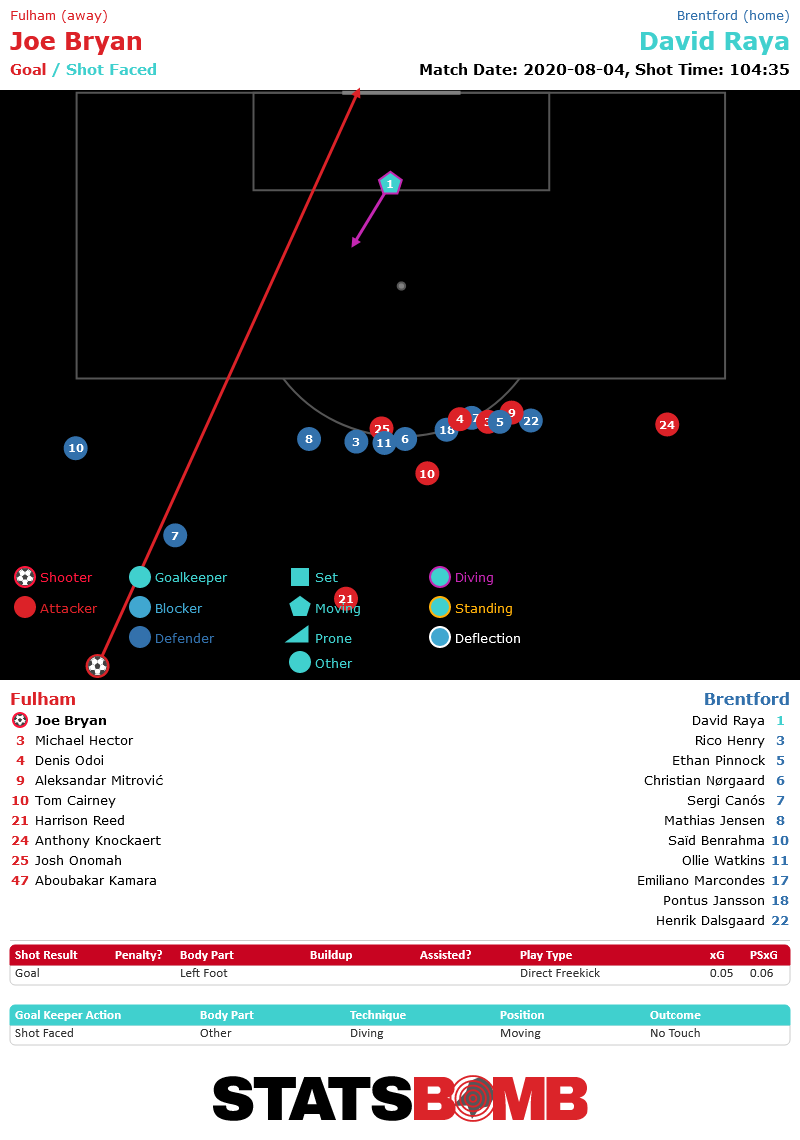 Fulham successfully negotiated the three games that their promotion depended on without riding their luck at any point during. Therefore, it’s undeniable that they did deserve their promotion, right? Let’s start to look forward now. It’s worth considering that Parker’s pragmatism, though not advisable when a big favourite with a talent advantage in a smaller league, does at least leave them better prepared to adjust to the Premier League than they were last time out. Although those attacking transitions will most certainly need to speed up. On that note, the signing of Mario Lemina from Southampton could help if he can replicate the form shown on the south coast that saw him mooted as a potential replacement for Mousa Dembélé at Tottenham. Lemina was flagged by StatsBomb’s own Euan Dewar when he analysed dribblers and their post-dribble actions a couple of seasons back and if he can help Fulham move through the centre of the park and transition from defence to attack more quickly or efficiently, that could be important. Similarly, the return of André Zambo Anguissa to the squad is notable. Anguissa was one of the more heralded signings of the 18/19 summer window and it looks increasingly more likely that he’ll stay a Fulham player in 2020/21, returning after playing a key role in helping Villarreal finish 5th in La Liga. Now two years older than when he first signed and closer to his peak at 24, there’s potential he could step up in the way that was hoped when he first signed.
Fulham successfully negotiated the three games that their promotion depended on without riding their luck at any point during. Therefore, it’s undeniable that they did deserve their promotion, right? Let’s start to look forward now. It’s worth considering that Parker’s pragmatism, though not advisable when a big favourite with a talent advantage in a smaller league, does at least leave them better prepared to adjust to the Premier League than they were last time out. Although those attacking transitions will most certainly need to speed up. On that note, the signing of Mario Lemina from Southampton could help if he can replicate the form shown on the south coast that saw him mooted as a potential replacement for Mousa Dembélé at Tottenham. Lemina was flagged by StatsBomb’s own Euan Dewar when he analysed dribblers and their post-dribble actions a couple of seasons back and if he can help Fulham move through the centre of the park and transition from defence to attack more quickly or efficiently, that could be important. Similarly, the return of André Zambo Anguissa to the squad is notable. Anguissa was one of the more heralded signings of the 18/19 summer window and it looks increasingly more likely that he’ll stay a Fulham player in 2020/21, returning after playing a key role in helping Villarreal finish 5th in La Liga. Now two years older than when he first signed and closer to his peak at 24, there’s potential he could step up in the way that was hoped when he first signed. 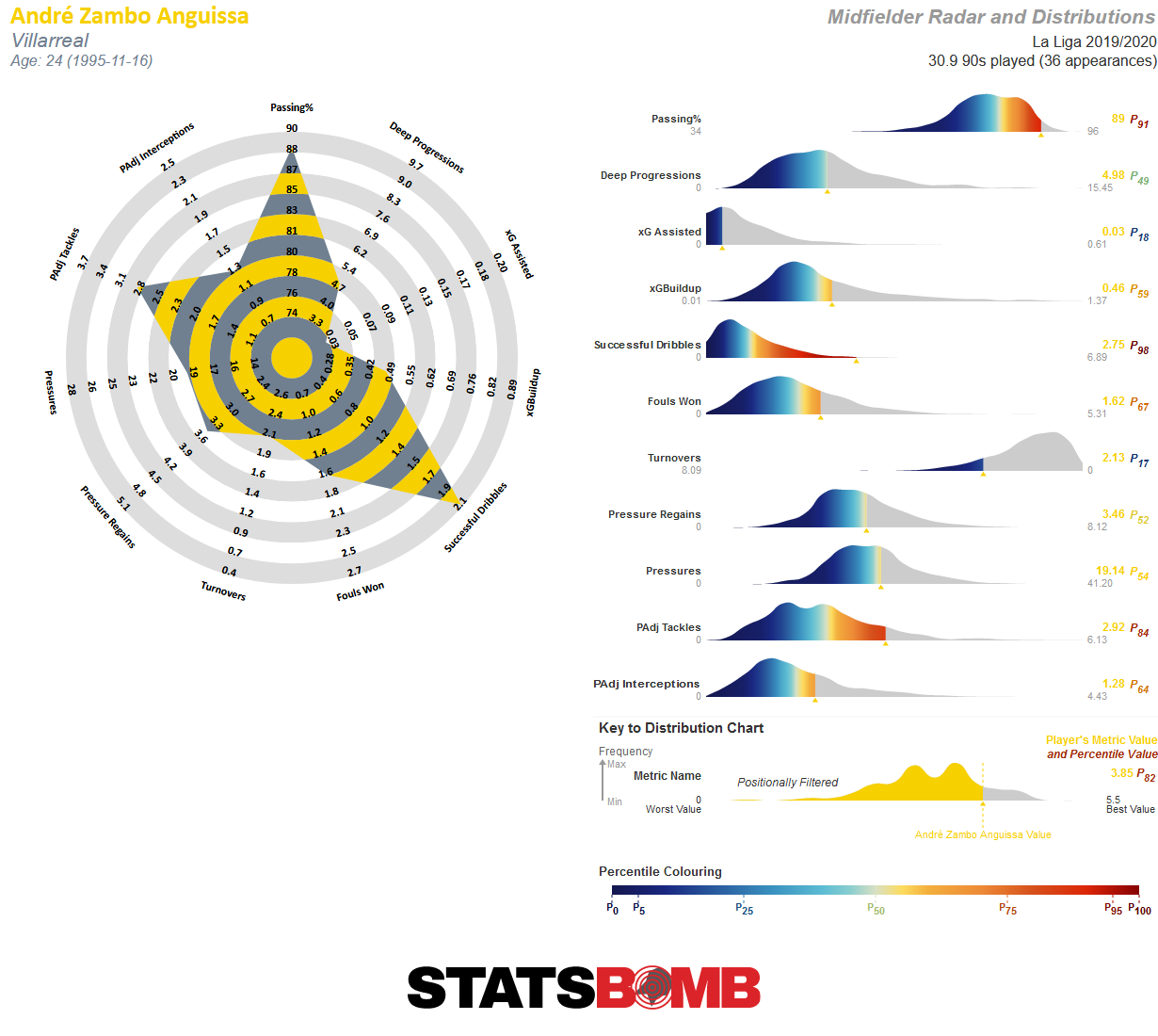 Anguissa was part of the infamous £100million spend that summer, but comparisons between that window and this are scarce. There were some domestic signings back then but the vast majority were brought in from overseas and with no experience of English football. This time, Fulham’s business has so far focused entirely on the domestic market and with smaller sums being exchanged: the only (soon to be confirmed) signing from overseas has been that of wing back Ola Aina who’s spent the last two seasons with Torino in Serie A but moved there from Chelsea. Of the business that remains to be done, there are concerns over Fulham’s reliance on 26-goal Mitrović, who was given very little help in the goalscoring department last season. He’ll be the main man again and has proven he can be counted on for some contribution at Premier League level, but more needs to come from the support acts out wide. Ivan Cavaleiro and Anthony Knockaert notched just nine goals between them last season and given the unlikelihood that Mitrović reaches another double-dozen, they’ll need to step up.
Anguissa was part of the infamous £100million spend that summer, but comparisons between that window and this are scarce. There were some domestic signings back then but the vast majority were brought in from overseas and with no experience of English football. This time, Fulham’s business has so far focused entirely on the domestic market and with smaller sums being exchanged: the only (soon to be confirmed) signing from overseas has been that of wing back Ola Aina who’s spent the last two seasons with Torino in Serie A but moved there from Chelsea. Of the business that remains to be done, there are concerns over Fulham’s reliance on 26-goal Mitrović, who was given very little help in the goalscoring department last season. He’ll be the main man again and has proven he can be counted on for some contribution at Premier League level, but more needs to come from the support acts out wide. Ivan Cavaleiro and Anthony Knockaert notched just nine goals between them last season and given the unlikelihood that Mitrović reaches another double-dozen, they’ll need to step up. 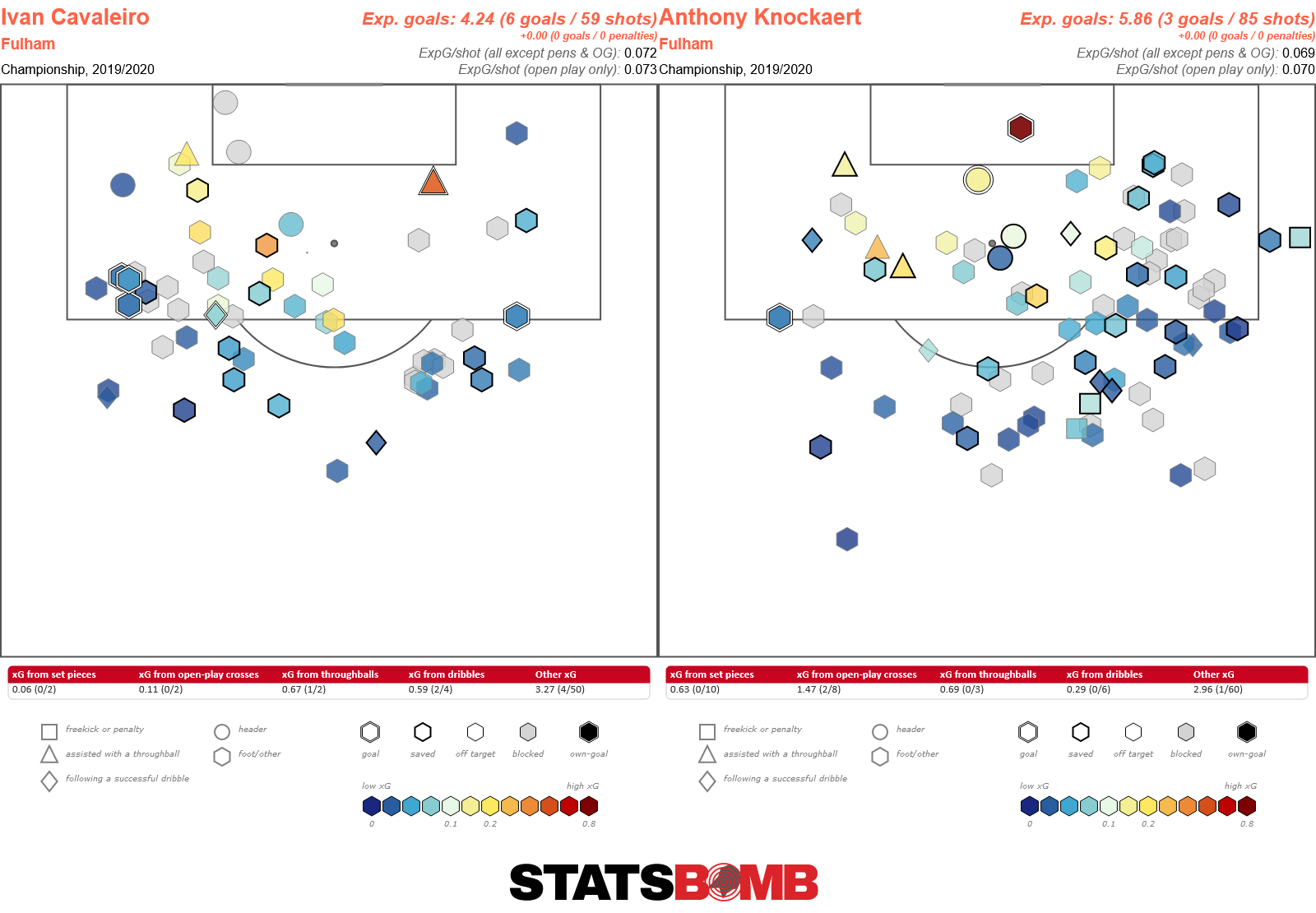 In a weird flip, Fulham could be coming into this season as a perceivably and demonstrably worse side than the one that was promoted last time out but at the same time one that’s better prepared and suited for the challenge that’s ahead of them thanks to a risk-averse manager and more settled squad. Expectations amongst the fanbase are also lower due to the manner of promotion and tighter transfer spending. Critiqued for much of last season but with a bit more credit in the bank after promotion, it’ll be interesting to see how much patience Parker gets should things not go to plan straight away. Joint relegation favourites with West Brom seems a fair assessment.
In a weird flip, Fulham could be coming into this season as a perceivably and demonstrably worse side than the one that was promoted last time out but at the same time one that’s better prepared and suited for the challenge that’s ahead of them thanks to a risk-averse manager and more settled squad. Expectations amongst the fanbase are also lower due to the manner of promotion and tighter transfer spending. Critiqued for much of last season but with a bit more credit in the bank after promotion, it’ll be interesting to see how much patience Parker gets should things not go to plan straight away. Joint relegation favourites with West Brom seems a fair assessment.
If you're a club, media or gambling entity and want to know more about what StatsBomb can do for you, please contact us at Sales@StatsBomb.com We also provide education in this area, so if this taste of football analytics sparked interest, check out our Introduction to Football Analytics course Follow us on twitter in English and Spanish and also on LinkedIn
We hope you've enjoyed the StatsBomb Premier League season previews! Here's a handy place to keep them all. Just click the links to read about each team. Thanks to Nick Dorrington, Oli Walker and Ted Knutson for writing and thanks from me to you for reading. If you enjoyed these articles do share widely! Arsenal Aston Villa Brighton and Hove Albion Burnley Chelsea Crystal Palace Everton Fulham Leeds United Leicester City Liverpool Manchester City Manchester United Newcastle United Sheffield United Southampton Tottenham Hotspur West Bromwich Albion West Ham United Wolverhampton Wanderers
If you're a club, media or gambling entity and want to know more about what StatsBomb can do for you, please contact us at Sales@StatsBomb.com We also provide education in this area, so if this taste of football analytics sparked interest, check out our Introduction to Football Analytics course Follow us on twitter in English and Spanish and also on LinkedIn
During the opening few weeks of 2019-20, Ralph Hasenhüttl mixed up his formations a little. The well-remembered Leicester game was the sixth time in ten matches that Southampton started with a variation involving three centre backs. That game wasn’t the final straw--two more games took place before an international break, but when Southampton came back to face Arsenal on the 23rd November, they played a version of 4-4-2. And from that point on they stuck to it. The reason for this change was clear enough: Southampton were 19th and on a run of no wins in seven. If ever there’s a good time to refocus thoughts, then languishing in the relegation places with your job under threat is it and Hasenhüttl quickly went back to basics. From that point on, Southampton pressed more frequently (led the league in volume of pressure events), timed their pressure events more aptly (led the league for counterpressure events), were more aggressive in closing down opponent pass receipts than any other team (29%) and had the lowest pass per defensive action value. Results improved and quickly: a 2-2-8 start gave way to a 8-2-7 run pre-Covid break and 5-3-1 afterwards. Metrics generally followed suit too with a -0.4xG difference per 90 in that weak period switching round to +0.18 for the rest of the season (albeit the post-Covid metrics lagged behind good results). However you slice it though, once Hasenhüttl went to his pressing 4-4-2, Southampton were pretty good, around the sixth or seventh best team in the league. 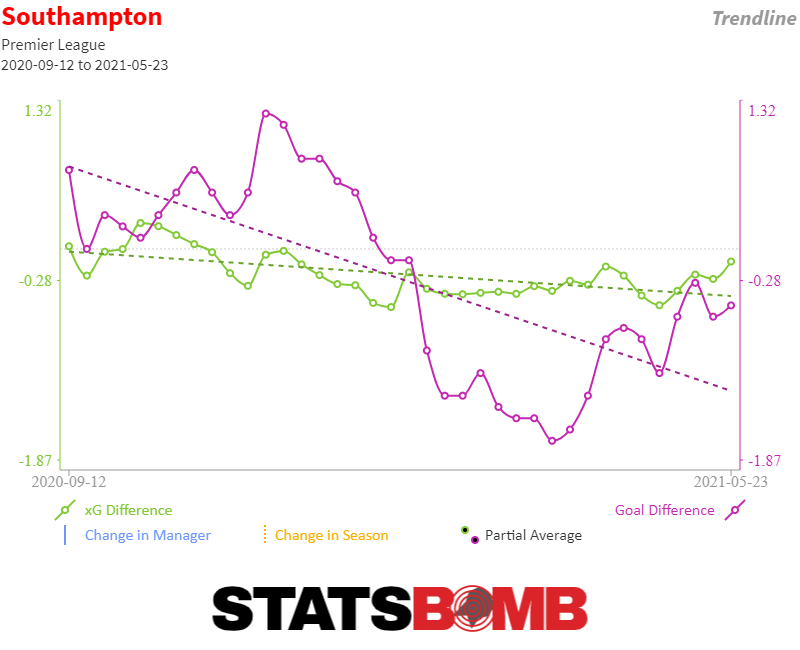 There were bad games across the season, and that rather impacted the metrics as a whole. Seven times Southampton gave up large xG totals (around 2.5 and up) in individual games. Some of them were understandable; both Manchester City games, Liverpool away and the 9-0, but it also occurred in back to back games just before the Covid break away to West Ham and home to Newcastle (thanks to Moussa Djenepo's first half red card) and then at home to Arsenal after the restart:
There were bad games across the season, and that rather impacted the metrics as a whole. Seven times Southampton gave up large xG totals (around 2.5 and up) in individual games. Some of them were understandable; both Manchester City games, Liverpool away and the 9-0, but it also occurred in back to back games just before the Covid break away to West Ham and home to Newcastle (thanks to Moussa Djenepo's first half red card) and then at home to Arsenal after the restart: 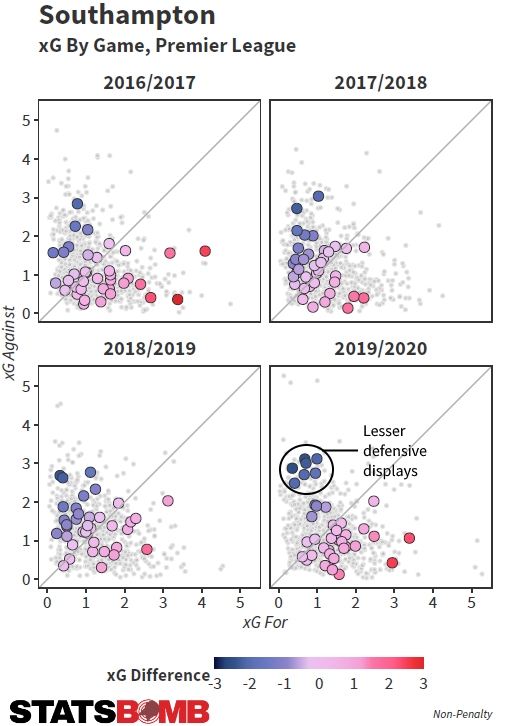 There's little doubt that this kind of vulnerability can be a by-product of games in which pressing teams are outmaneuvered. The Liverpool away game is a great example, as the team competed really well in the first half but Liverpool exerted themselves as the game wore on and won 4-0. The passing network from that game shows the generally equal balance of the game in regard to possession locations, which is unusual for a team against Liverpool. Another real rarity was Trent Alexander-Arnold getting pushed right back into the er... right back slot:
There's little doubt that this kind of vulnerability can be a by-product of games in which pressing teams are outmaneuvered. The Liverpool away game is a great example, as the team competed really well in the first half but Liverpool exerted themselves as the game wore on and won 4-0. The passing network from that game shows the generally equal balance of the game in regard to possession locations, which is unusual for a team against Liverpool. Another real rarity was Trent Alexander-Arnold getting pushed right back into the er... right back slot: 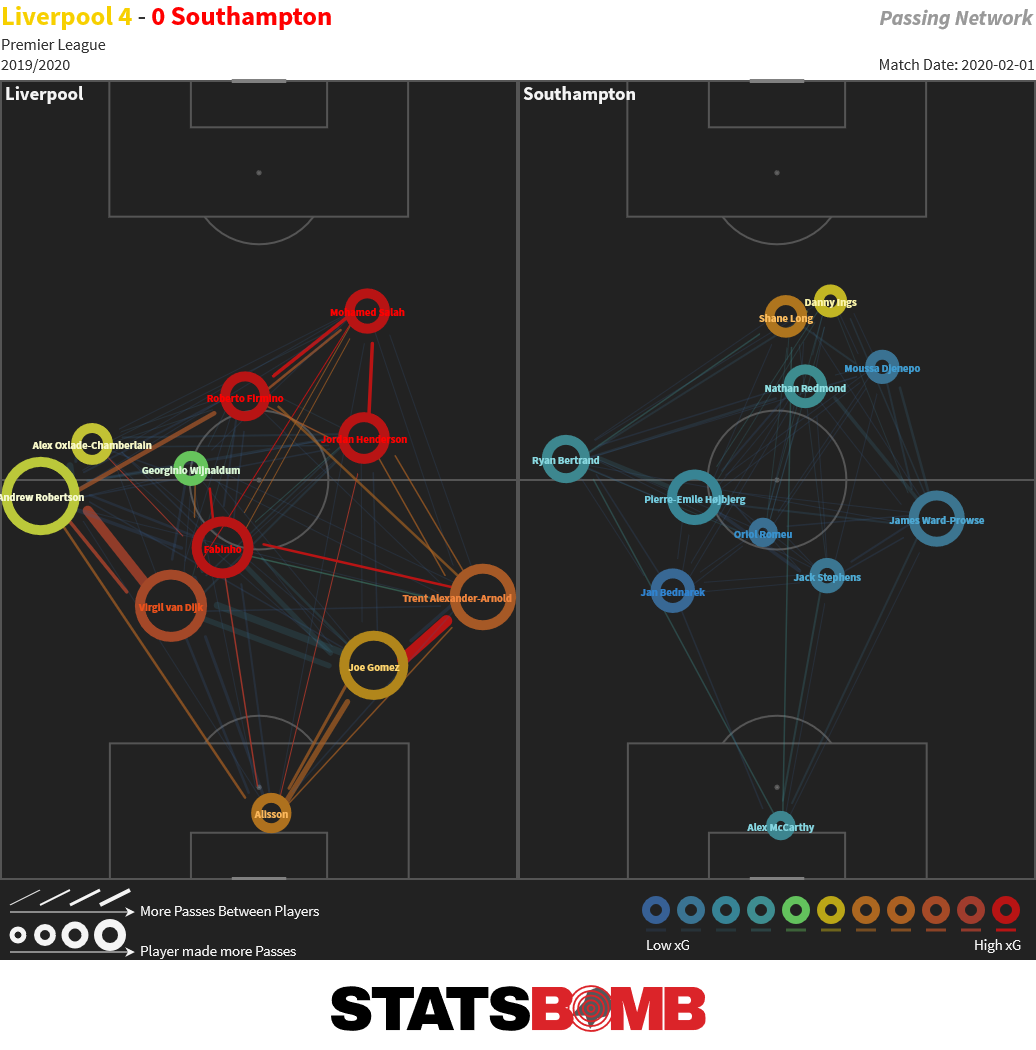 Southampton’s season was gilded by a phenomenal season from Danny Ings. He scored 22 goals in the league (21+1 penalty) from an expected rate of close to 16, but more remarkable was his sheer consistency. Across the past four seasons, only Mohamed Salah in 2017-18 has scored a non-penalty goal in over half a team’s games in a season (23 separate games), Ings is second on that list having notched in 19. If you sat down to watch a Southampton game in 2019-20 it was a literal coin flip whether or not you’d see an Ings goal. He only scored one header and was not adept at getting on the end of crosses from open play, but otherwise scored a likeable variation of goals: tap-ins, off throughballs, after beating a defender to make space or a shot, from longer range and with both feet.
Southampton’s season was gilded by a phenomenal season from Danny Ings. He scored 22 goals in the league (21+1 penalty) from an expected rate of close to 16, but more remarkable was his sheer consistency. Across the past four seasons, only Mohamed Salah in 2017-18 has scored a non-penalty goal in over half a team’s games in a season (23 separate games), Ings is second on that list having notched in 19. If you sat down to watch a Southampton game in 2019-20 it was a literal coin flip whether or not you’d see an Ings goal. He only scored one header and was not adept at getting on the end of crosses from open play, but otherwise scored a likeable variation of goals: tap-ins, off throughballs, after beating a defender to make space or a shot, from longer range and with both feet.  He also led the press: his 25 pressure events per game was highest in the team. Loads of goals, loads of work rate. What’s not to like? He didn’t create much with his passing, but nor did anyone else, that's just not how this team creates. The team pushed high, won the ball back and grabbed shots--they ranked fifth behind the top four sides for shots directly generated from a high press at over three per game. We can see how Southampton have evolved over four seasons here, or at least how Hasenhüttl's tenure has built the press from the front. They're more active high up the pitch than at any time since (to my surprise) Claude Puel in 2016-17, and the pattern in how they play now is very clear:
He also led the press: his 25 pressure events per game was highest in the team. Loads of goals, loads of work rate. What’s not to like? He didn’t create much with his passing, but nor did anyone else, that's just not how this team creates. The team pushed high, won the ball back and grabbed shots--they ranked fifth behind the top four sides for shots directly generated from a high press at over three per game. We can see how Southampton have evolved over four seasons here, or at least how Hasenhüttl's tenure has built the press from the front. They're more active high up the pitch than at any time since (to my surprise) Claude Puel in 2016-17, and the pattern in how they play now is very clear: 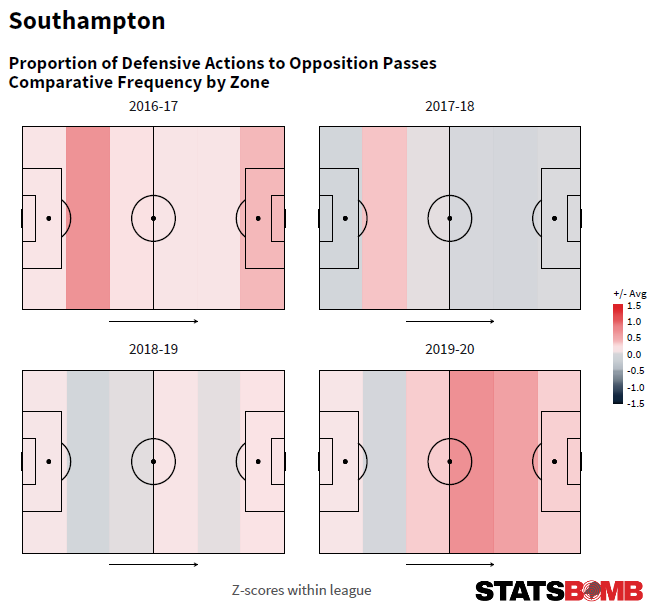 There's a lesson here around lineage and manager recruitment too. It can take time for a manager to get their methods across, even more so if they need to unpick diametrically opposed work done in a different direction by former managers. Having kept faith with Hasenhüttl through a tough period, a concerted and clear style has emerged, with some success. Personnel Southampton have made a couple of early moves in the market to shore up their defence. Kyle Walker-Peters followed up his loan from Tottenham with a permanent move. That a large volume of Tottenham fans were sad to see him depart, feeling he could have been used more over the years is indicative of his general ability. He could easily have been used more in their rotation and should be entirely fine at Southampton, especially with half a season under his belt already. Mohammed Salisu effectively takes Maya Yoshida’s place in the squad and as a young left footed centre back, is a relatively scarce talent within the league, and within this squad. The 6ft3” former Real Valladolid man has just one season of top-flight experience. During that season he was Valladolid’s main back line defender recording significantly higher percentage of defensive clearances than his centre back partners, scarcely being dribbled past but was not error-free, as you might expect from a young centre back. There may be more additions to come. In particular, central midfield looks a little light with Pierre-Emile Højbjerg moving to Tottenham and Harrison Reed and Mario Lemina each landing at Fulham for the forthcoming season at least, instead of returning. There's also some hope to see better in season two from Che Adams and Moussa Djenepo. Both found it hard to gain consistent minutes in 2019-20, but some starts late on saw Adams finally score his first Premier League goal with a kooky 40-yarder against Manchester City and he followed it up with three more before season's end. Meanwhile, Djenepo had a stop-start season with injuries, the loss of his mother and suspension all contributing to reduced time spent on the pitch. when he did play, he showed he wasn't far off the player he showed at Standard Liege:
There's a lesson here around lineage and manager recruitment too. It can take time for a manager to get their methods across, even more so if they need to unpick diametrically opposed work done in a different direction by former managers. Having kept faith with Hasenhüttl through a tough period, a concerted and clear style has emerged, with some success. Personnel Southampton have made a couple of early moves in the market to shore up their defence. Kyle Walker-Peters followed up his loan from Tottenham with a permanent move. That a large volume of Tottenham fans were sad to see him depart, feeling he could have been used more over the years is indicative of his general ability. He could easily have been used more in their rotation and should be entirely fine at Southampton, especially with half a season under his belt already. Mohammed Salisu effectively takes Maya Yoshida’s place in the squad and as a young left footed centre back, is a relatively scarce talent within the league, and within this squad. The 6ft3” former Real Valladolid man has just one season of top-flight experience. During that season he was Valladolid’s main back line defender recording significantly higher percentage of defensive clearances than his centre back partners, scarcely being dribbled past but was not error-free, as you might expect from a young centre back. There may be more additions to come. In particular, central midfield looks a little light with Pierre-Emile Højbjerg moving to Tottenham and Harrison Reed and Mario Lemina each landing at Fulham for the forthcoming season at least, instead of returning. There's also some hope to see better in season two from Che Adams and Moussa Djenepo. Both found it hard to gain consistent minutes in 2019-20, but some starts late on saw Adams finally score his first Premier League goal with a kooky 40-yarder against Manchester City and he followed it up with three more before season's end. Meanwhile, Djenepo had a stop-start season with injuries, the loss of his mother and suspension all contributing to reduced time spent on the pitch. when he did play, he showed he wasn't far off the player he showed at Standard Liege: 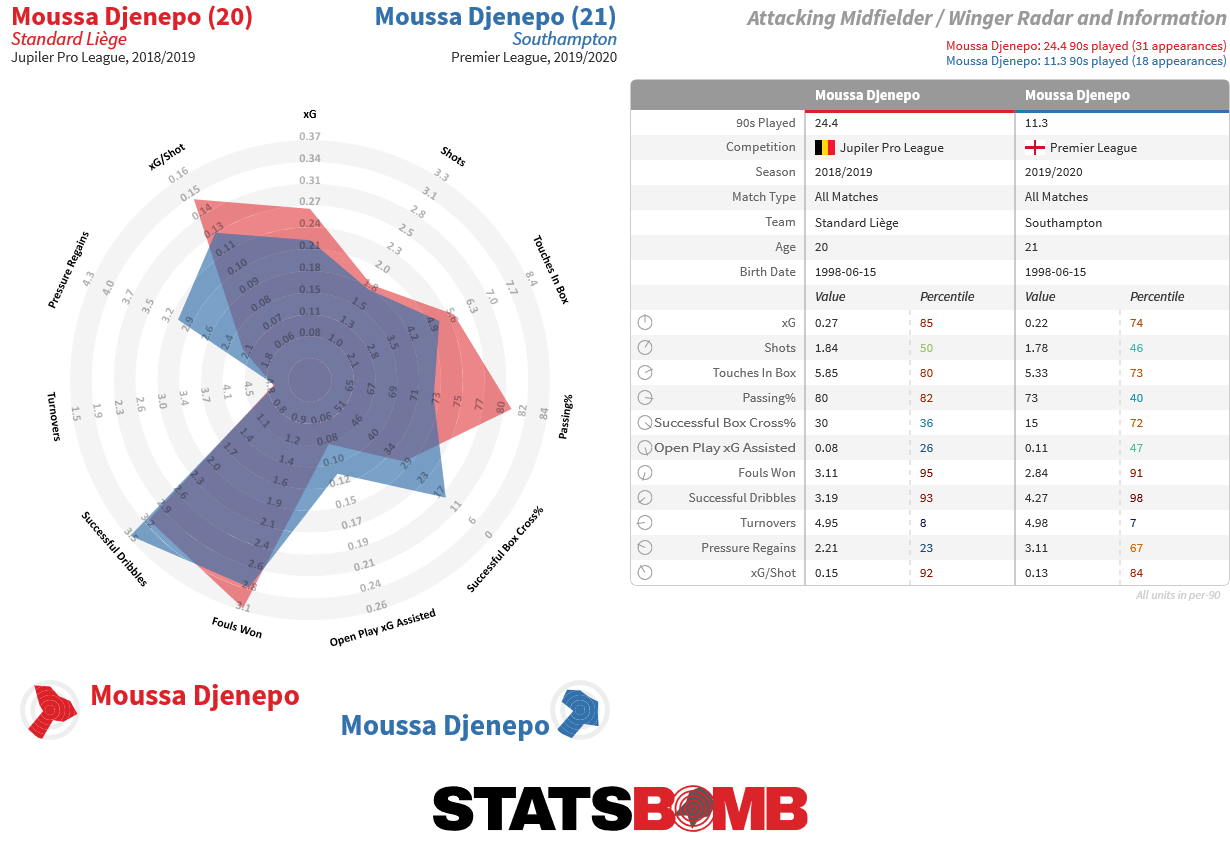 Projection Southampton finished eleventh last season, which represented getting the car back on the tarmac after a couple of seasons of off-roading down the table. All in, raw expected goals rated them eighth best and liked them more than Tottenham and Arsenal. Sporting Index opening lines had them at around 50 points which maroons them in mid-table but would also be completely safe. You don't look at this squad and see the appealing talent levels that led Liverpool to routinely buy Southampton players for so many years, and ironically the one player who made the opposite journey, Ings, is one that will likely have a huge bearing on how Southampton progress this season. If he can stay fit and continue to score at a good clip, it takes the pressure off the midfield, which has been somewhat goalshy for a number of seasons. It is also good for the league that we have a non-elite pressing team competing at a solid level, and Hasenhüttl may not have hit his ceiling here yet. Anything in the top half will represent another good season, and should certainly be the aim.
Projection Southampton finished eleventh last season, which represented getting the car back on the tarmac after a couple of seasons of off-roading down the table. All in, raw expected goals rated them eighth best and liked them more than Tottenham and Arsenal. Sporting Index opening lines had them at around 50 points which maroons them in mid-table but would also be completely safe. You don't look at this squad and see the appealing talent levels that led Liverpool to routinely buy Southampton players for so many years, and ironically the one player who made the opposite journey, Ings, is one that will likely have a huge bearing on how Southampton progress this season. If he can stay fit and continue to score at a good clip, it takes the pressure off the midfield, which has been somewhat goalshy for a number of seasons. It is also good for the league that we have a non-elite pressing team competing at a solid level, and Hasenhüttl may not have hit his ceiling here yet. Anything in the top half will represent another good season, and should certainly be the aim.
If you're a club, media or gambling entity and want to know more about what StatsBomb can do for you, please contact us at Sales@StatsBomb.com We also provide education in this area, so if this taste of football analytics sparked interest, check out our Introduction to Football Analytics course Follow us on twitter in English and Spanish and also on LinkedIn
A manager change. A global pandemic. A 10th place finish in expected goal difference. Another FA Cup trophy at the end of it. And then the release of seemingly the entire scouting department plus the firing of Head of Football Raul Sanllehi to boot. What to even make of the 19-20 season from Arsenal?
Recruitment last summer was "fine," if overpriced. Wide forward had long been a need, and Nicolas Pepe filled it adequately, even though Arsenal probably overpaid for him by £25M. Kieran Tierney took ages to get healthy and settled, but once he started playing, he quickly became a fan favourite. 18-year-old William Saliba was purchased and then immediately sent back to Saint-Etienne to continue his education. And David Luiz was brought over from Chelsea as a rich man's Shkrodan Mustafi, in the hope that Unai Emery would never be forced to play both of them together on match day.
Combine those with the younger signings from a year before in Torreira, Bernd Leno, and Matteo Guendouzi, and it felt like Arsenal fans might have a reason to be optimistic.
Except... well.
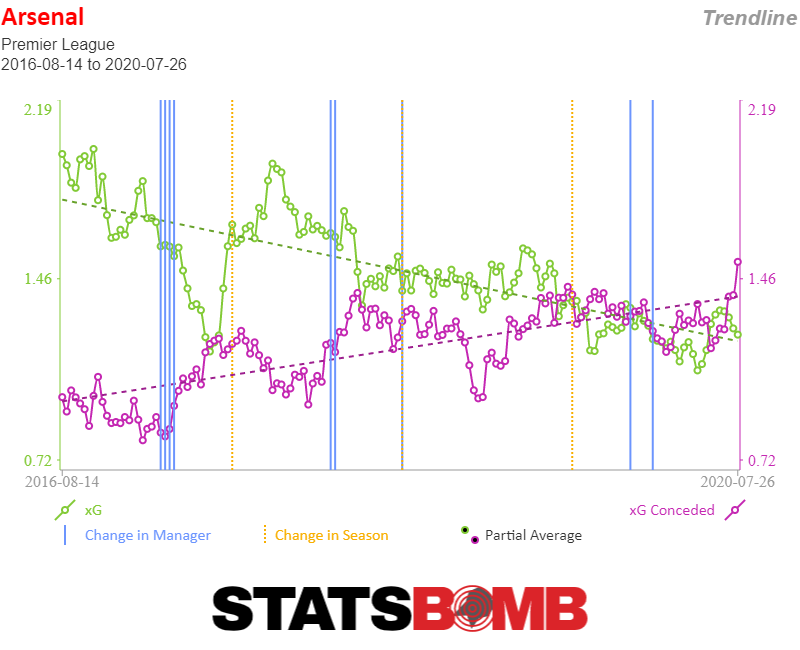
My worry with the hire of Unai Emery was that Arsenal would sacrifice the funky attacking patterns that were a hallmark of Arsene Wenger's era in exchange for stabilising the defence. The reality was that Emery never stabilised the defence while the attack did indeed become a hell of a lot less fun.
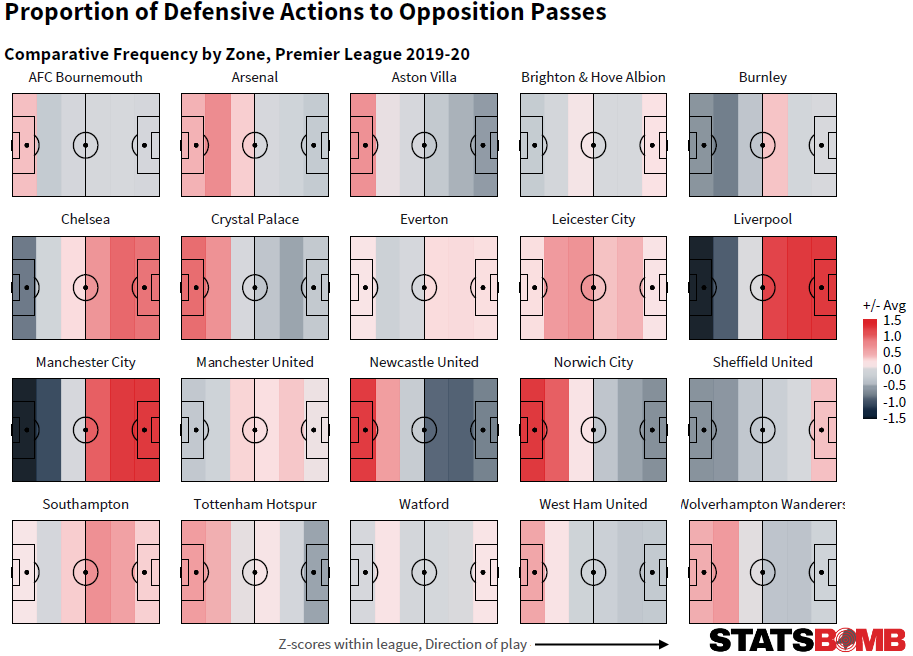
Along with frustrations over recruitment toward the end of the Wenger era, including a complete lack of inbound young attacking talent, one of the points I had hoped Arsenal would address with a new manager was to become more aggressive in the high press. The low block and occasional pressing style under Steve Bould (from the late Wenger years) was just effective enough for fourth, but no more than that. My hope was that Arsenal would dial up the pressure and move up the table as well.
Unfortunately under Emery, Arsenal not only forgot how to dominate the ball, they also forgot how to dominate... anything.
The lack of an elite defence (see Manchester United) combined with relative dross on the attacking end, meant Unai Emery was shown the door after a string of poor results in November. Speaking to one club insider this past summer, they stated that the writing was already on the wall for Emery after season 1, which made it even more strange that Sanllehi wanted to extend his contract. They also felt the summertime splash in the transfer market made little sense with a lame duck manager, which isn't wholly unfair.
Reading between the lines, the state of Arsenal's upper management in recent years can be described as "bumpy" at a minimum, and ranges to "complete flaming chaos with a side of potential corruption" for those who were both present and particularly descriptive of the situation.
Enter Mikel Arteta
Allegedly, Arteta was nearly hired to succeed Arsene Wenger before a change of heart saw Emery take the reins in summer 2018. A season and a half later, Arteta entered the club with his first chance at being a head coach. Before moving forward, however, it makes a little bit of sense to step back.
In spring of 2017, Arsenal did a very quiet set of interviews with top head coach candidates in preparation for Wenger leaving the club. On the potentials list were a variety of names, including Thomas Tuchel and Roger Schmidt. (I heard Marcelino was mooted as well, but I don't know anything beyond rumour there.) Tuchel would later replace Emery at PSG and take them to the CL Final this summer, while Schmidt finished out his time in China before taking a break from football, and was recently hired to coach similarly-abbreviated but not-remotely-the-same-stature club PSV. I note this because at one time it seemed fairly clear Arsenal were looking for tactical styles that included a regular high press.
In addition to playing under Arsene Wenger, Mikel Arteta spent three seasons coaching and learning from Pep Guardiola, not only one of the greatest coaches in modern football, but also an advocate of the... you guessed it... high press playing style.
The problem for coaches taking over mid-season is that it's really hard to find the training time to teach defensive structure changes. This is especially true when the team they take over are also involved in Europa League play and make deep runs in domestic cups - there just isn't enough time on the training pitch to completely revamp the principles. So it wasn't entirely surprising that Arteta's Arsenal team played similarly to Emeryball, with perhaps a bit better tactical understanding.
This is especially true when you consider that most of the post-pandemic run-in were games where the results didn't matter, at least for Arsenal. Combine a potential lack of motivation in the league run-in (and a focus on the FA Cup) with four red cards in the 21 matches after Arteta took over, and you get a sense that the headline averages don't tell the whole story.
What was slightly surprising, was that the team started to put up honest-to-god results against Big 6 teams for the first time in... well, seemingly forever. Arsenal beat Liverpool in the league, then Man City and Chelsea in the FA Cup before defeating Liverpool on penalties in the Community Shield. This was new. This was different. Even if the process wasn't exactly sterling - Arsenal were still losing the expected goals battles - the results were... good?
But are they sustainable? Ahhhh, there is the rub.
How do Arsenal get better in 2020-21?
A) Recruitment Arsenal's squad have been an army of misfit toys for a while now. They have talent, but the elite players seem to play the same positions (Aubameyang and Lacazette), and there are almost no peak age players (24-27) in the squad. From a squad building perspective, it has been messy for years.
Possibly the biggest need in the squad this summer was retooling the centreback rotation. If Guardiola's style is anything to go by, Arteta will require ball-playing CBs with pace. William Saliba is extremely young, but the potential answer to part of that equation. The addition of Gabriel Magalhaes from Lille looks to be another potential answer. However, given the ages, my guess is that these two will rarely play together as a pairing this year.
Which leaves you with the rest of the centrebacks. Mustafi looked mostly competent post-pandemic right up until he reverted to his tradition Arsenal form of calamitous mistakes in the last few matches. If calamity is the baseline, the brief purple patch has to be considered an outlier. Relying on him is not a thing most coaches would do by choice. Sokratis has been deemed surplus to requirements, and given his age when he arrived from Dortmund was always a stopgap measure. Pablo Mari looks to be a man mountain, but injury in the opening minutes of the season's return meant we have basically nothing further to evaluate him on aside from being large and left-footed. It's a start, at least?
Rob Holding is likely to be a loanee this season, lacking both the pace and the passing to be a top tier CB, though he's a serviceable Premier League one and was bought for a pittance from Bolton.
Calum Chambers is... still under contract.
That leaves us with the variance of David Luiz. Luiz's tenure at Arsenal has been plagued largely by mistakes and red cards, which is why it came as a surprise that he signed a contract extension early in the summer and looks set for another season at the club. Fans were left muttering, "Kia taketh, but when doth he give?" Willian on a free was presumably not the hoped for answer.
While Gabriel and Saliba are probably the future, the present looks somewhat uncertain.
Equally uncertain is the midfield composition. Convincing Dani Ceballos to return was vital - he was Arsenal's most important midfielder after the pandemic return, and offers versatility as well as top quality production. Xhaka has the passing but lacks the legs to be one of the elite players at his position, and then you hit... well, we don't know yet.
Torreira is likely to be sold, Guendouzi as well, and Arsenal wish Ozil would wriggle himself into a move anywhere but here. Which leaves the cupboard fairly threadbare when it comes to central midfielders. Outgoings could fund a high level incoming like Aouar (which would be fairly impressive recruitment coup), but even adding a player of that calibre means quite a few minutes for Joe Willock to gain experience. Maitland-Niles looks like RB1 if Bellerin leaves to pursue trophies and fashion in Paris, which leaves Bukayo Saka as a pacey flex-8 and almost no one else.
If Arsenal do sign Aouar, they'll hope for a return of his 20-year-old season under Bruno Genesio.
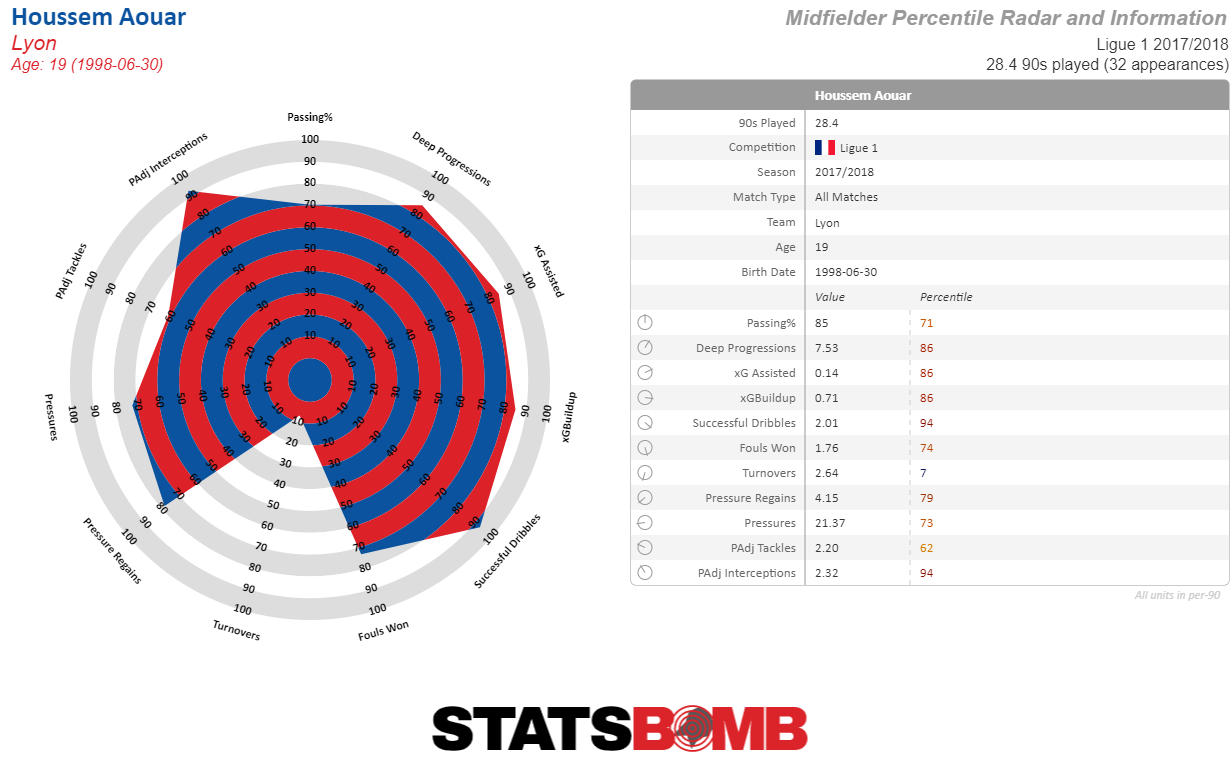
My thoughts on Thomas Partey I will revisit in a postscript.
The Kids
Signing Saka to a long-term extension was extremely important for both the Gunners and their fanbase. The academy production line has gone from almost nothing five years previous to churning out attacking talent that is only a small step below the best academies in the world. Saka broke through and regularly looked like one of the better players on the pitch playing in the Premier League at age 18. Losing that type of talent would have been heartbreaking, even if Arsenal don't quite know his best position yet.
Nketiah (21) isn't quite ready to lead the line, but he's probably only a season or two off and also needs lots of minutes to finish his development. Reiss Nelson (only 20) is more of a question mark, and this is especially true with the signing of Willian. My guess is Arteta felt he wasn't going to be good enough to be the second option wide right, which means Nelson probably goes into the Sales/Loans pile to generate enough funds to fill out the squad, but I could be wrong.
Before his injury, Gabriel Martinelli looked like a wonderkid, and it is hoped he'll continue to develop into an elite attacker even if he probably won't be back in action until the winter.
Arsenal's attacking youth are a bit too young and a bit raw, but are already good enough to merit either decent minutes in the league and cup competitions, or to generate enough sales revenue to fund additional transfers.
B) Defensive Style
"No playmaker in the world can be as good as good counter-pressing." - Jurgen Klopp
One of the ways Arsenal can get better as a team is by playing a better defensive style. High pressure is related to both fewer expected goals against and to generating additional expected goals in attack. Arsenal as a whole lack some creativity in attack, and I'm not sure they are going to be able to fix that in the transfer market this window.
However, in the absence of elite creative players, gegenpressing and learning to transition more and better can still help generate additional, almost free goals. The test here will be whether Arsenal have the personnel to do it, and whether Arteta can get them playing it well in time for the new season.
Even if they aren't elite at it to start (and neither Klopp's LFC nor Pochettino's Spurs were), committing to this style and improving at it over the course of the season is a useful goal unto itself. And potentially necessary to help generate more goals from a team that doesn't look like it will add creative firepower until potentially January at the earliest.
C) Set Pieces These went from a mild success under Emery to a moderate disaster under Arteta both in attack and defence. Andreas Georgson has been brought in to help improve this phase of the game and I wish him all the best. Even if he makes it so I stop wincing every time Arsenal face a defensive corner, I will consider this a success.
D) Behaviour With a Lead
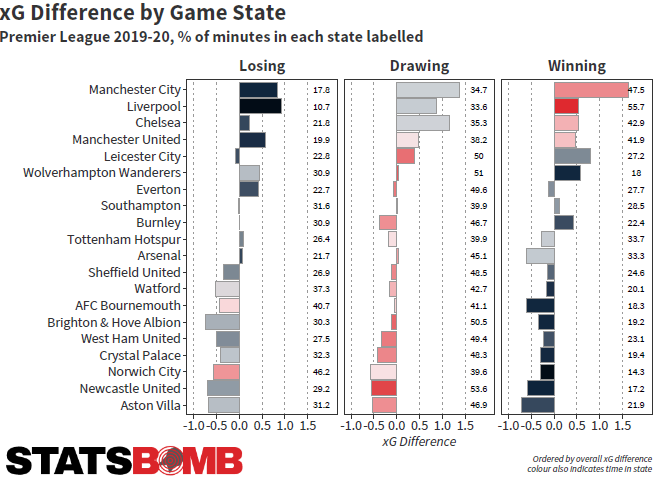
This one is subtle, but it was a massive problem throughout the course of last season. Arsenal had the fourth worst expected goals difference in the league when they had a lead.
All of the top 6 teams had a positive expected goal difference with the lead. The best teams look to extend leads, not protect them. Protecting leads is a recipe for 14 draws in 38 league matches and another likely midtable finish.
To put this another way - when playing with a one-goal lead, Arsenal became relegation candidates. They had 36% of the expected goals, 32% of the total shots, but still managed 47% of the goals. Luck? Talent? Bit of both probably, with a strong worry that it won't be repeatable should they try it again.
This is typically a tactical choice, and one that needs to change if Arsenal are going to challenge for anything useful this season.
Conclusion
An optimist would look at the FA Cup trophy and numerous victories against the Top 6 as a positive sign. They will also take hope in the idea that Arteta should put in a similar defensive system to what Pep runs at City, even if they are cautious that Arsenal may not have the players to execute that style particularly well for at least another year.
A pessimist will look at the average numbers on both sides of the ball under Emery and Arteta, and conclude that Arsenal have not been Actually Good since 2016-17 and there are no obvious signs of getting better. They will also look at the mess at the top of the club and mixed bag of recruitment as further proof that Arsenal are not ready to pull out of their slide into mediocrity just yet.
Myself, I lean toward optimism. I think the results suggest a better process is on the way, and that's backed up by my eye test when I watch this team execute tactically now versus what it was like under Unai Emery.
A top 4 challenge is probably a little less than a coinflip, especially with the firepower Chelsea have brought in this summer, but if better tactical choices are made, a return to the top 6 is fairly likely.
--Ted Knutson
@mixedknuts
Post Script

I moved this down here because it requires some time and some nuance to explain and I didn't want to clutter up the preview with additional nonsense.
If you prefer the podcast version of this argument, you can find it here: https://soundcloud.com/statsbomb-pod/statsbomb-podcast-july-1-q-a
I said this back in June and I stand by it. I also followed up that tweet with additional reasoning.
First, "free" isn't free. In many cases free simply means taking 30-50% of the transfer fee a team would normally pay and adding it to the player's wage packet. So instead of Partey making £200K a week, he now makes 300 or 350K a week. Given his age - he would be starting his contract at 27 - this means Arsenal would be taking a HUGE risk if Partey didn't work out.
When it comes to squadbuilding, taking big risks on older players with giant wages and potentially low resale value is a terrible idea. Occasionally it works out - Aubameyang at Arsenal is one rare example and someone I would have been happy to buy at £50M but much less happy with at £70M - but mostly it doesn't and it means you are stuck with a player that has declining output and who may become effectively unmoveable.
(There are a million zillion examples of this, but the one that always strikes me is how often Manchester City did this until a couple of years ago. Fernandinho worked out alright, but a ton of those others guys did not (Navas, Negredo, Bony, Nolito), and the failure to keep younger fullbacks around basically cost City a title in Pep's first season at the club.)
Beyond the age, and the wages, and the squadbuilding principles, I just don't see good data-based reasons to be excited about Partey.
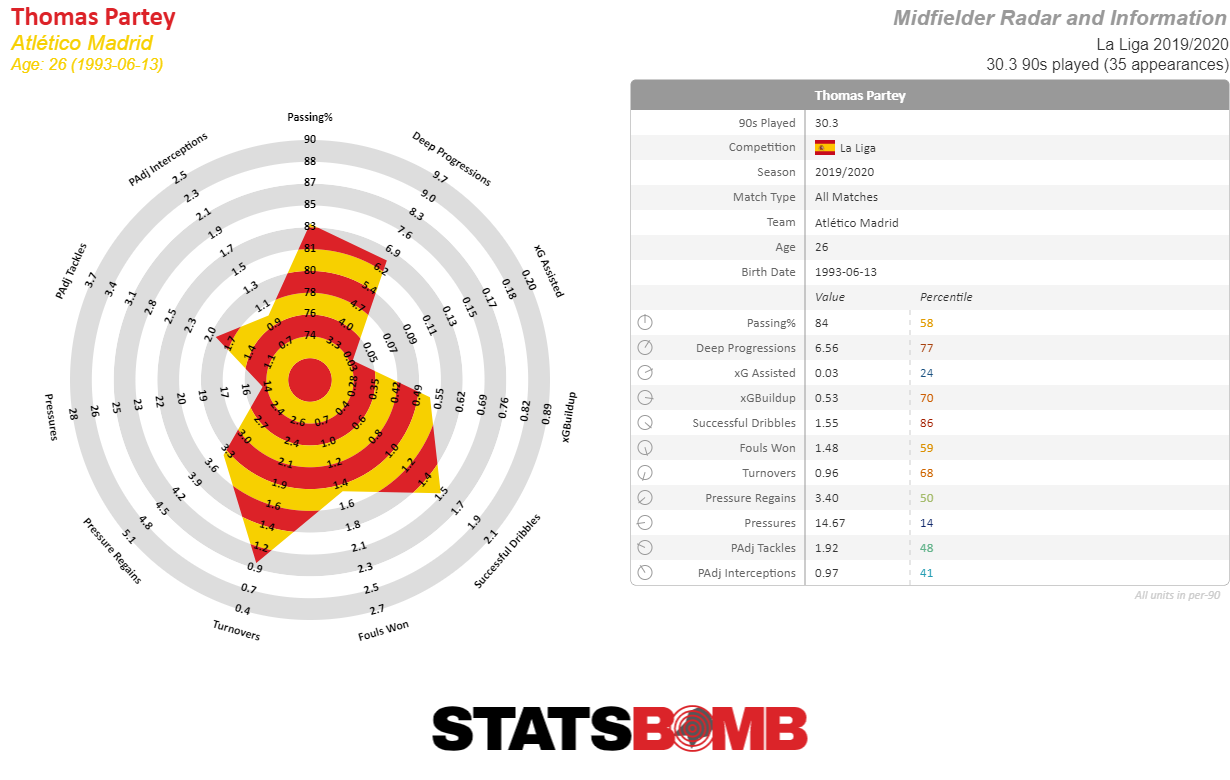
If you're splashing the cash, you really want scouting and data to both be excited about a player. That's not output I want to spunk £50M and big wages on. Or big wages and a 5-year contract.
He was amazing against Barcelona! Great, then why wasn't he amazing against all the other teams in La Liga last season?
Atletico are weird tactically, and his stats are not reflective of how he will play elsewhere. Again, fine... but we can ONLY judge his output from Atletico because that's the only place he's played since 2015. This increases the risk that the transfer goes wrong.
He's an elite defensive midifelder! His output looks nothing like an elite defensive midfielder.
He's NOT a defensive midfielder, he's a box-to-box midfielder who is great on the ball. Okay, but he also doesn't score goals or create goals for his teammates, so what are you actually paying for?
Transfer shopping is all about correctly evaluating and mitigating risk. If you are going to spend big, there needs to be very little risk something doesn't work out, and hopefully some upside involved as well. Liverpool don't make mistakes on transfers. That's why they are where they are now, despite finishing 8th as recently as 15-16. If you buy young guys and they don't work out, at least you can sell them on at a small loss and roll the dice again (Lucas Torreira). But if you buy/sign an older player on big wages and they don't work out, you are dead. You either have to eat a ton of their wages to move them on, or they stick around until the end of their contract with declining production.
My perspective on Arsenal and transfers has been the same for years now. I think they should not be building to try and finish 4th and make the Champions League.
I think they should be building a squad to try and finish first, even if that's one or two years down the line. And the way you do that is not via signing 27 and 28yos... you do it via taking some risk on 21-24 year olds, hoping your analysis is good, and letting them mature into elite players while improving the style of play.
It’s extremely uncharitable to take a look back at 2019-20 and declare it anything other than a success for Leicester. Yes, Champions League qualification looked likely for most of the season, and to miss out was ultimately a disappointment, but the trajectory and outcome were more than fine.
In Brendan Rodgers’ first full season in charge, Leicester built on a strong run at the back end of 2018-19 to finish fifth. Since their unexpected title win in 2015-16, the team has turned over managers at a rapid rate but also contrived to stabilise and grow. Finishes of twelfth, ninth and ninth have now been exceeded and in raw terms the team improved ten points season to season. This meant it was still their second most successful Premier League season and while not quite the 40 point year to year boost that made them champions, the original baseline they moved upwards from was higher and the likelihood of maintaining a good level surely is too.
In a season of two halves, Leicester ballooned over what were solid metrics pre-Christmas then found their run deflated despite continuing solid metrics from there on in. They scored 39 points in the first 19 games with a plus-22 non-penalty goal difference and plus-8 expected goal difference, then 23 points from the last 19 with plus-7 for non-penalty goals and plus-10 for xG. Wait a minute? Very similar expected numbers in both halves of the season? Yes, and that's why sometimes, outcomes can be deceptive.
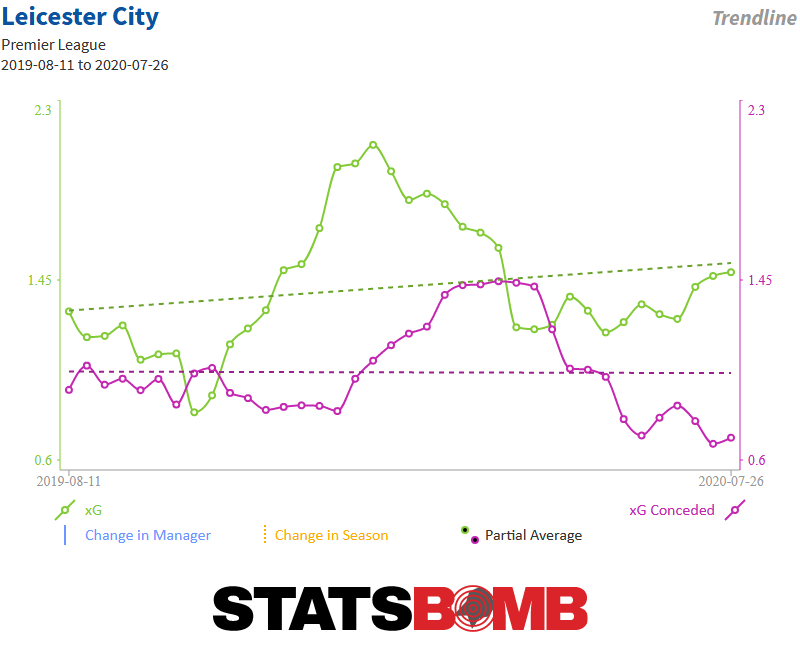
Overall, it's impossible to take a negative stance on their metrics. Expected goal difference? Fourth. In attack? Fourth. Defence? Fifth. Leicester got the cusp of the top four not by some fluke but by playing football of a quality that merited their position.
What made Leicester good last season? To start, Brendan Rodgers got them working pretty hard off the ball:
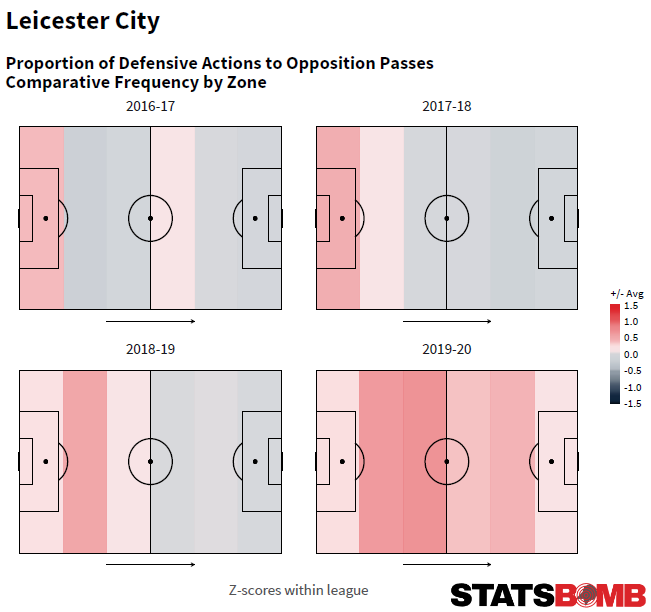
That chart includes StatsBomb pressure events alongside other "traditional" defensive metrics (tackles and the like). It shows that in proportion to their opponent's pass volumes, Leicester were either slightly or quite frequently above average in how they engaged in every zone of the pitch--a notable change from previous seasons. The old school pass per defensive action metric (not pressure, just high up the pitch) had Leicester logged as lowest (best) across 2019-20 and consistent over each half of the season. The proportion of opponent receipts that were pressed within two seconds, had Leicester at 28% in the first half of the season (2nd) and 27% in the back half (1st). Outside of Manchester City, Liverpool and to a degree, Chelsea, the teams that enact a press that shows up well in data are Leicester and Southampton. This team puts in a shift.
Part of what enabled this is that the role and purpose of players in Rodgers' line-ups were fairly consistent and clear. There is a sense of Liverpool in how Leicester partition their contributors into attackers than use possessions and defenders that don't, not least insofar as the two full-backs, Ricardo Pereira and Ben Chilwell fitted firmly into the attacking band. Alongside James Maddison, this trio finished the most Leicester possessions during 2019-20, and it's easy to presume that missing these three in the run in was costly. Once Maddison was unable to feature, Rodgers seemed more inclined to work with three centre backs, pushing the full-backs ever higher, perhaps knowing he didn't have another Maddison-type, as an attempt to further embellish the full back attacking contribution. Of course by now, Pereira's loss to an ACL in March cut deep, for all that Justin did a solid job in covering, and Chilwell was later missed too with 19 year old Luke Thomas covering. Pre-lockdown, the team had been injury free and consistent with a version of 4-1-4-1 most commonly used. Barnes, Tielemans and Perez contributed a fairly democratic attack looking to power Vardy's Indian summer, while Wilfried Ndidi sat in front of the centre backs and covered everything going the other way.
Personnel
It's to Leicester's credit that ever since their title win, they've sold a big ticket star every summer to a big six club, yet managed to build and maintain a fairly solid squad and compete well against exactly those teams. N'Golo Kanté and Danny Drinkwater and now Chilwell all went to Chelsea, Riyad Mahrez to Manchester City and Harry Maguire to Manchester United. This reliable income has been a useful counterbalance to necessary spending and has meant that they have made a bunch of mid-priced bets along the way. More recently they have quite often come out the right side of the deals. Youri Tielemans was the most expensive (at around £40m) but elsewhere Ndidi, Maddison, Caglar Söyüncü and Pereira have forged good careers at Leicester and were core parts of last season's team. Even players that have not become core starters such as Kelechi Iheanacho, Dennis Praet or James Justin are now able to round out the squad and offer useful depth, while it's always fun to find a Harvey Barnes or Hamza Choudhury lurking in your development squads.
None of these players are anywhere near being the wrong age and most of them are still on the cusp of their best years. The squad has a lot of pre-peak talent that has grown together. The veterans here are two title winners in keeper Kasper Schmeichel and Vardy and a still effective Jonny Evans. who has now spent five seasons post-Manchester United proving their decision to move him on to be not optimal. With this kind of age profile, there is no obvious reason why this team shouldn't be as good if not better this coming season:
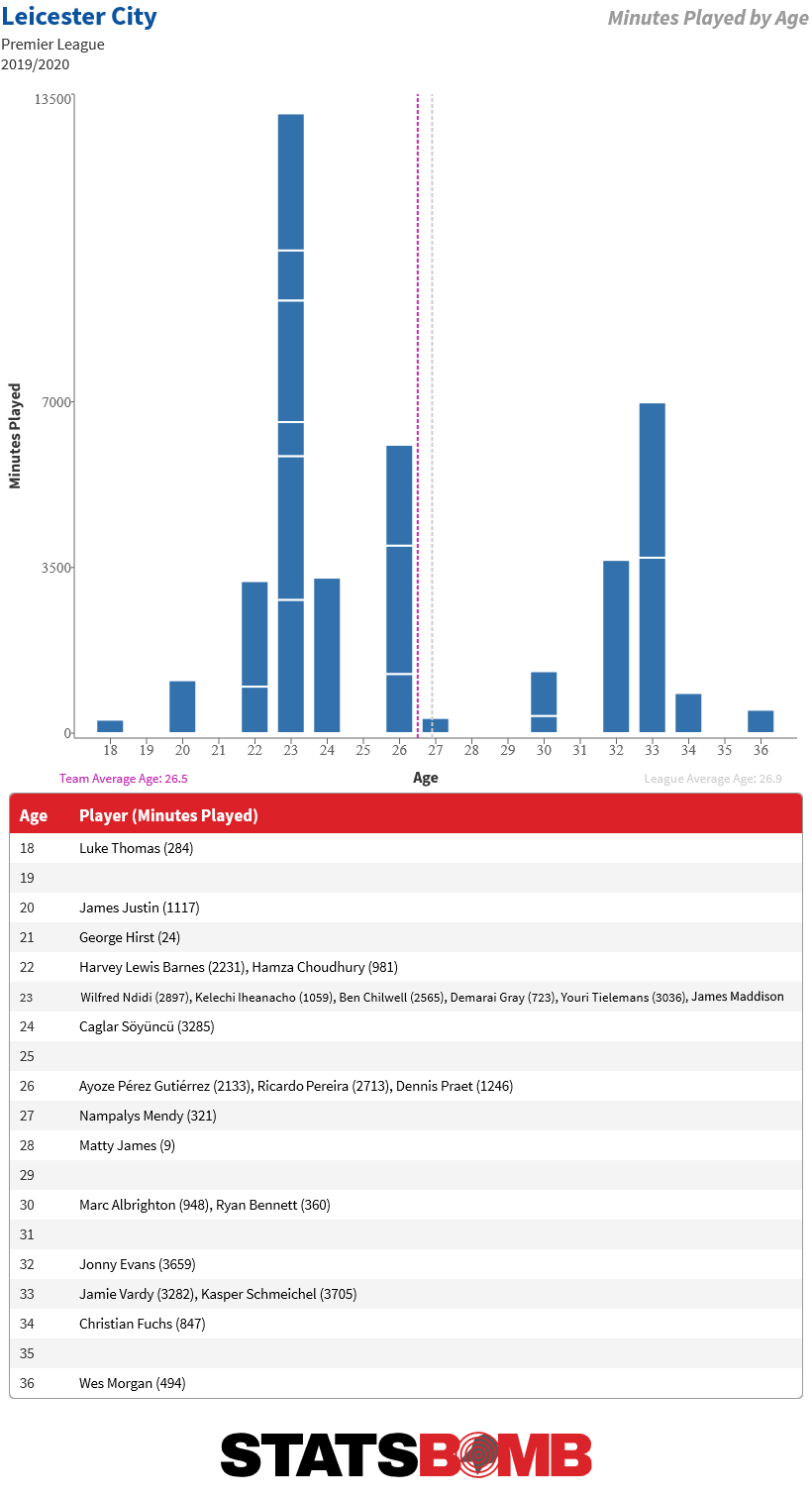
With Chilwell departing, a replacement was quickly sought. Signing a player from Atalanta does have a ring of "hipster's choice" to it but Timothy Castagne represents another right age (24) mid-range fee (£21.5m) with a decent amount of experience in a good side. He has covered either flank as a full back; he's spent time fairly equally on both sides across the last two seasons but with Pereira (if fit) and James Justin already ensconced on the right side it seems most likely that he'll be stationed on the left. Remaining left full back Christian Fuchs is surely winding down at 34 so it's not impossible they will strengthen again here, but Castagne's profile is that of a player who is slightly more secure on the ball than Chilwell, while not contributing to the attack in the same way.
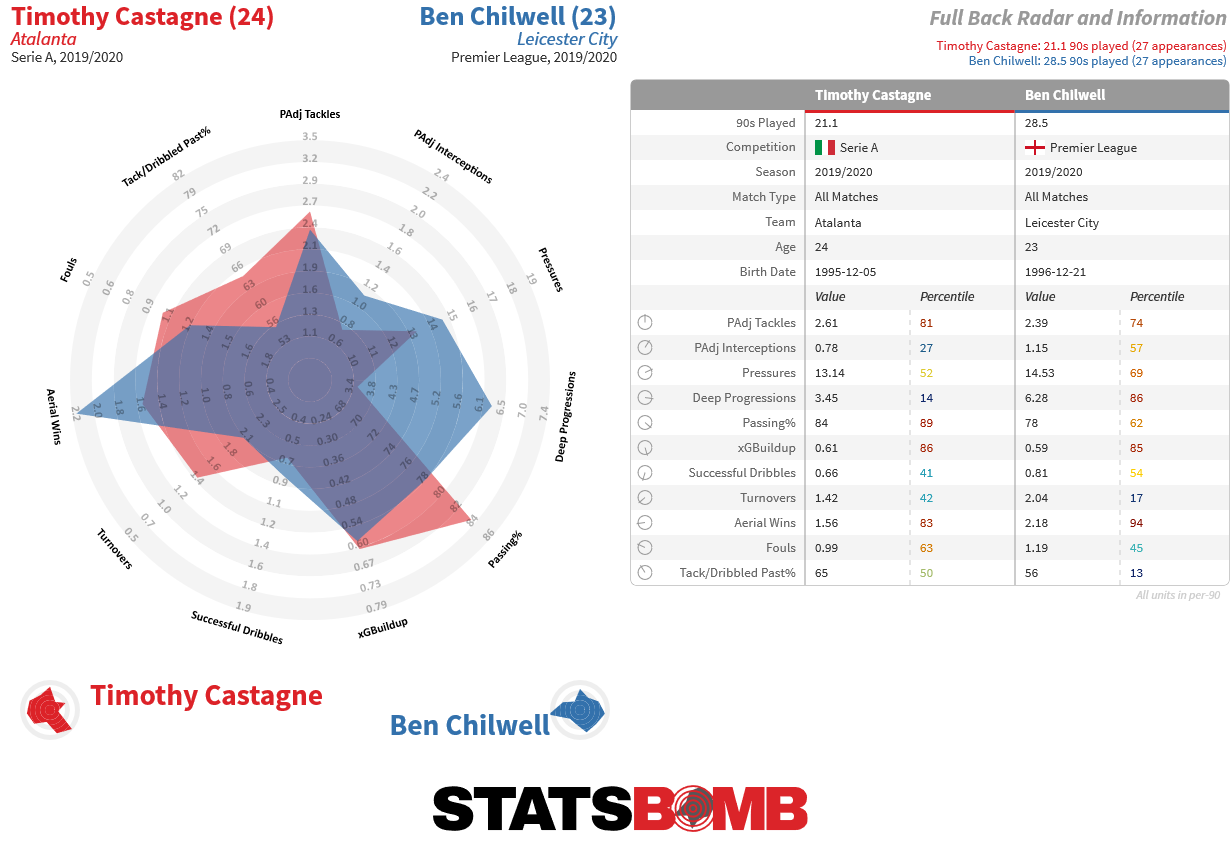
Castagne also doesn't offer the ball carrying high up the pitch or as a general outlet that Chilwell did, so there may be tweaks afoot in the style Leicester play:
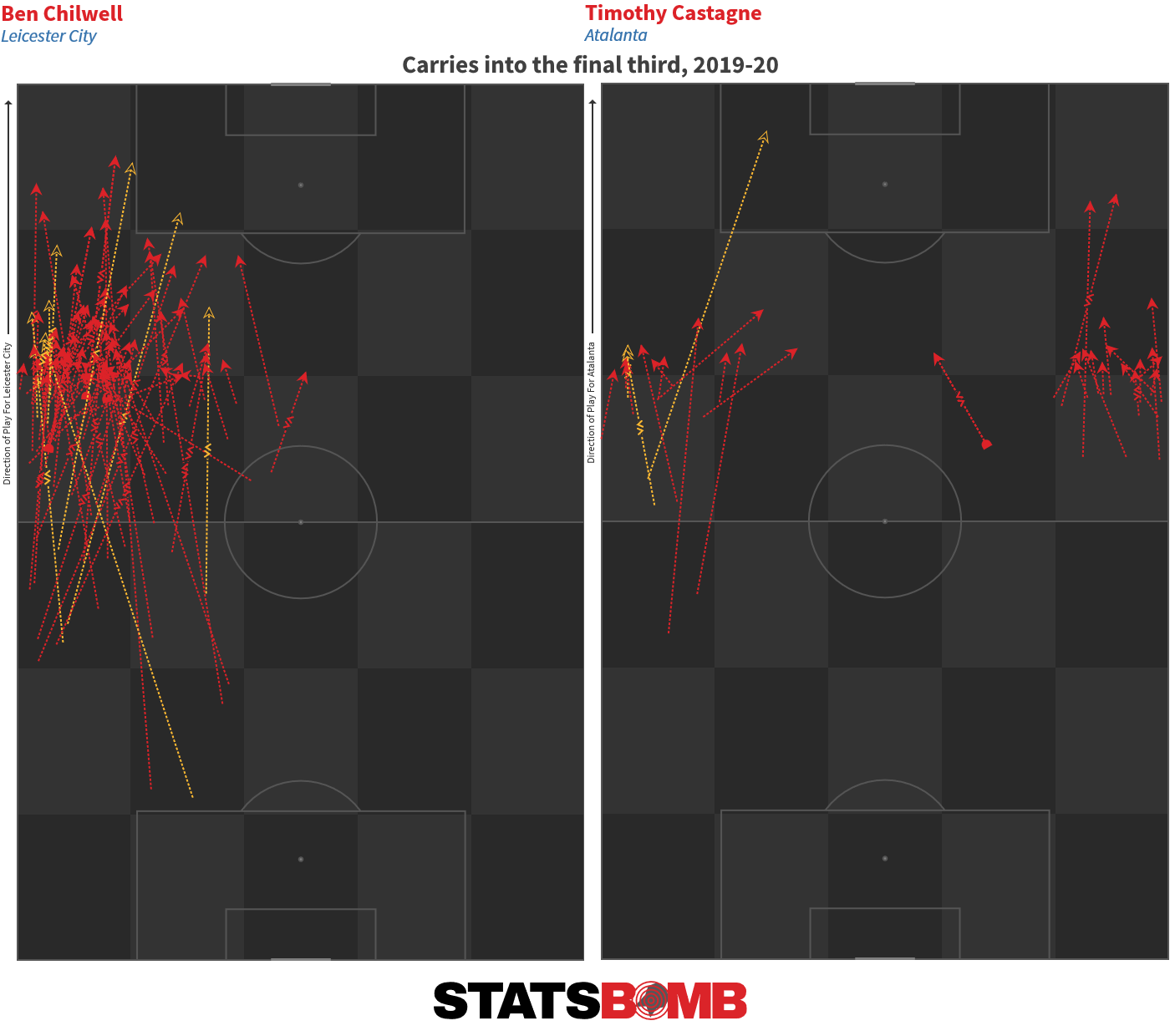
Elsewhere, Vardy remains somewhat immune to his age, and Rodgers has managed to extract his best goalscoring form in some seasons, by targeting shrewder movement and utilising his speed to get on the end of throughballs:
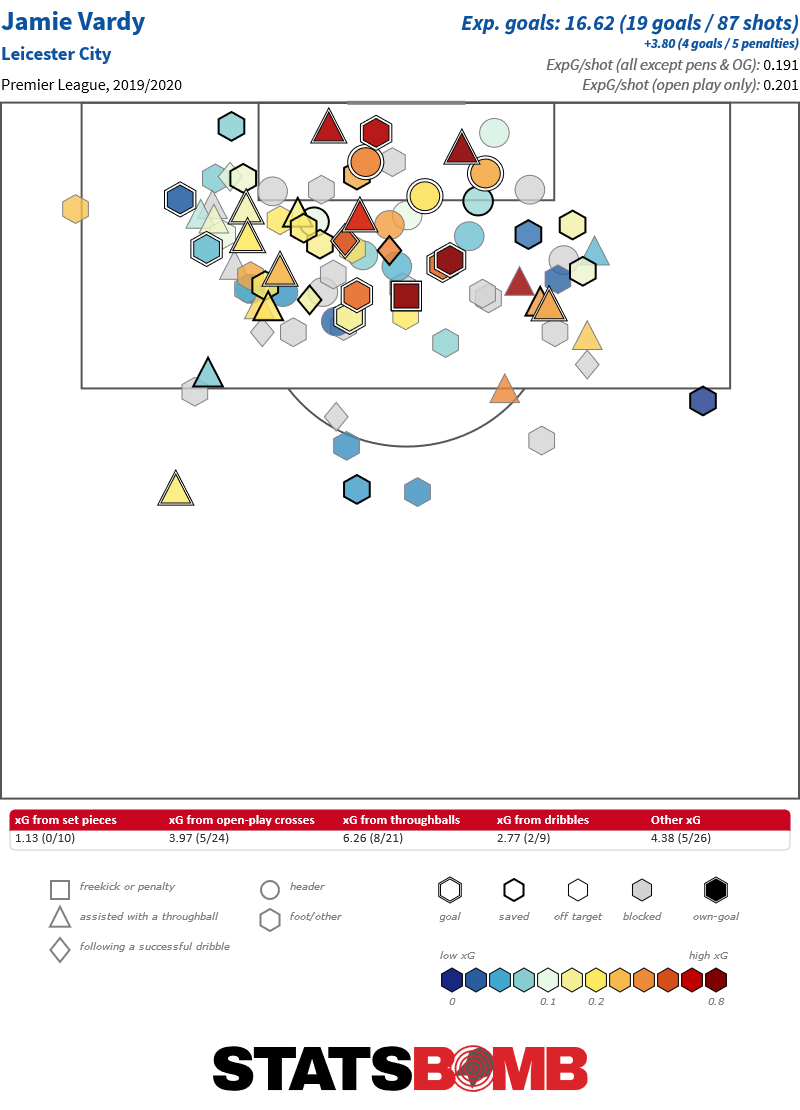
Vardy can be a streaky finisher, but in the aggregate he remains reliably over expectation. One day he will need replacing and there's an argument that for team effectiveness in buildup he's a net minus. Solving that is probably a decision for further down the line though, as his inevitable goal contribution will always be hard to replicate from elsewhere.
Projection
With the full backs contributing so heavily to Leicester's success in 2019-20, then Chilwell leaving and Pereira suffering a serious injury, it may be hard to mimic the specific set-ups we saw from August to March. Finding the balance here may well be crucial to whether Leicester can get early results, with further issues around the time until Maddison returns to full fitness and Evans missing the start of the season through suspension. A trip to Manchester City aside (they offered next to nothing in both fixtures last season), Leicester's early schedule is not unkind and they will hope that their injured stars can work their way back into contention once the schedule bites a little more. European football does focus consideration towards squad depth, and a couple more incoming players would help.
Results trending in the wrong direction (6-5-8 second half of the season, 2-3-4 post Covid break) have led to a divergent view of how good this team is and how well it can perform in 2020-21. The opening Sporting Index lines had them at around 56 points, behind all of the big six and Wolves, but the facts remain that in tied positions this team took close to 60% of all shots, for 60% of xG and scored over 60% of the goals. To ignore that entirely would negate the reality of Leicester's achievement.
As a metrics loyalist, I feel obliged to come out on the positive side of predicting Leicester. But for nagging doubts about key injuries i'd be confident that they could compete more than adequately against teams widely rated higher than them who have shown far less appeal in the numbers such as Arsenal and Tottenham. Their age profile is perfect for that of a team that can continue to progress, and this group of players is reminiscent of that which Mauricio Pochettino helmed for Tottenham at the start of their good run in the mid 2010s; a team which ironically found Leicester in their way perhaps a year or two before they hit their own peak. High praise? Sure, but there is talent throughout this team and there isn't that much that needs to be done to compete for a top four slot again.
If you're a club, media or gambling entity and want to know more about what StatsBomb can do for you, please contact us at Sales@StatsBomb.com
We also provide education in this area, so if this taste of football analytics sparked interest, check out our Introduction to Football Analytics course
Follow us on twitter in English and Spanish and also on LinkedIn
The last Everton manager before Carlo Ancelotti with a European trophy on his resume was Howard Kendall. He won the 1984-85 Cup Winner’s Cup for Everton, a clear highlight among a great run for the side in the mid-1980s. Ancelotti’s pedigree is clearly what attracted Everton’s power brokers when making the appointment, much as Jose Mourinho’s glittering history was deemed a match for Tottenham. Everton have spent quite freely in recent seasons with a view to pointing upwards, but the man in the hotseat, until now, had not fit the description of “serial winner”. Ancelotti changes that dynamic and ahead of his first full season, there is obvious pressure to get the best from his squad. Leicester were the team that managed to profit in 2019-20 from a couple of big teams hitting down years. Everton’s aspiration has to be to do similar in 2020-21. But can they do it? The base they are launching from is not high. A twelfth placed finish was the lowest Everton had recorded since 2003-04 and the whole season was hand-braked by a run of poor form under Marco Silva. He left the club after securing 14 points in 15 games and with the team in 18th place. Ancelotti’s subsequent tenure saw the club pick up points at a rate of close to 1.5 per game--57 points over a full season. This pegs the level that he’s achieved slightly ahead of the average of the last six seasons, a useful line in the sand since Roberto Martinez logged a huge 72 points in 2013-14. Within that season too: the last time Everton beat a big six club in a league fixture away from Goodison Park, a 1-0 win over David Moyes’ Manchester United. These are the type of challenges that the team must overcome if it is to move upwards. From a metric perspective Everton’s season was well… variable: 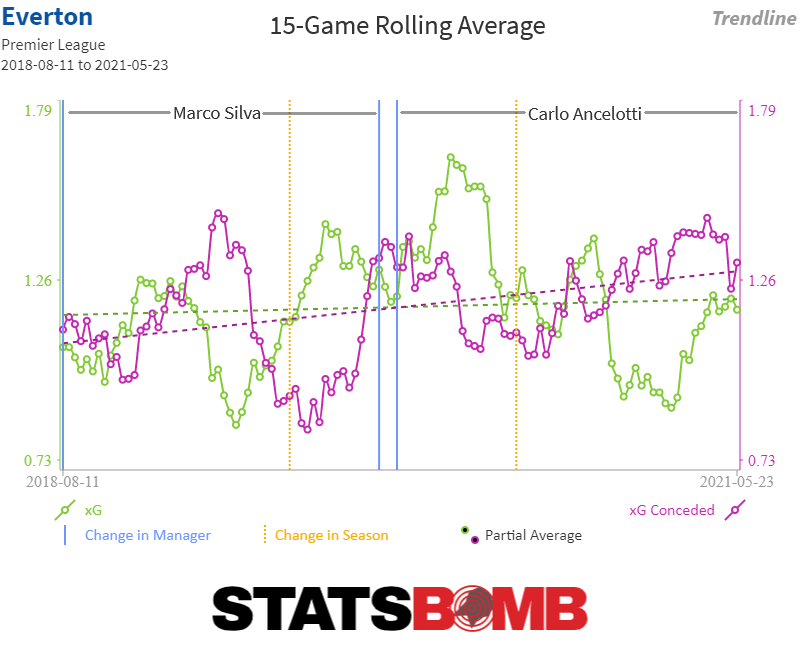 The first stretch for Marco Silva involved a big skew where results failed to overcome declining expected numbers, which ultimately did for him. The period that Ancelotti oversaw from late December to the Covid break was genuinely good: a 5-3-3 record was scant reward for third best in the league expected metrics (+0.7xG per game vs a flat, zero actual goal difference). Then in the New World, metrics declined, in particular in attack. The positive read of all this is that the good Ancelotti period was extremely promising. The negative read is more a question of why couldn’t they get anywhere near those heights in June and July? It’s fundamentally erroneous to draw lines based on player participation, so I will not point out that Fabian Delph started a lot of games in the good period and Andre Gomes played more in the bad. The whole before/after Covid break dichotomy is an added layer that makes projecting teams in 2020-21 an ever more hazardous procedure and it would not be surprising if a variety of teams played out the season with half an eye on the autumn and this restart. Personnel Everton have been far from shy in the transfer market in recent seasons, and their recruitment has had a mixed outcome. Marcel Brands was tasked with emerging from the weight that Steve Walsh’s tenure left on the club’s roster, and has made some pointed and valuable moves. Richarlison remains a certain hit, Lucas Digne has grown into one of the better two-way full backs in the league and while Delph isn’t one for the future, he was a relatively cheap and experienced player to slot into the midfield. Elsewhere, Andre Gomes remains elegant on the ball, but probably needs to be less elegant off the ball. Moise Kean is still very young and without the yips (two goals from over four xG) might have raised more eyebrows in first season from which he emerged from the bench most frequently, while Alex Iwobi needs to get back his creative boots if he’s going to continue to mini-Özil his way through life and scarcely shoot. On paper, at least, Jean-Philippe Gbamin was the answer to some of Everton’s issues around their midfield, but the poor guy is already out til 2021 and has undergone his third operation in a luckless run at the club. With a surfeit of centre forwards and winger types on the books, and mixed impact and bad luck in midfield, it's straightforward to identify where to strengthen, and Everton have followed that obvious route. Allan was the first through the door, a veteran of Ancelotti's Napoli tenure and a player who who has long provided great energy from midfield:
The first stretch for Marco Silva involved a big skew where results failed to overcome declining expected numbers, which ultimately did for him. The period that Ancelotti oversaw from late December to the Covid break was genuinely good: a 5-3-3 record was scant reward for third best in the league expected metrics (+0.7xG per game vs a flat, zero actual goal difference). Then in the New World, metrics declined, in particular in attack. The positive read of all this is that the good Ancelotti period was extremely promising. The negative read is more a question of why couldn’t they get anywhere near those heights in June and July? It’s fundamentally erroneous to draw lines based on player participation, so I will not point out that Fabian Delph started a lot of games in the good period and Andre Gomes played more in the bad. The whole before/after Covid break dichotomy is an added layer that makes projecting teams in 2020-21 an ever more hazardous procedure and it would not be surprising if a variety of teams played out the season with half an eye on the autumn and this restart. Personnel Everton have been far from shy in the transfer market in recent seasons, and their recruitment has had a mixed outcome. Marcel Brands was tasked with emerging from the weight that Steve Walsh’s tenure left on the club’s roster, and has made some pointed and valuable moves. Richarlison remains a certain hit, Lucas Digne has grown into one of the better two-way full backs in the league and while Delph isn’t one for the future, he was a relatively cheap and experienced player to slot into the midfield. Elsewhere, Andre Gomes remains elegant on the ball, but probably needs to be less elegant off the ball. Moise Kean is still very young and without the yips (two goals from over four xG) might have raised more eyebrows in first season from which he emerged from the bench most frequently, while Alex Iwobi needs to get back his creative boots if he’s going to continue to mini-Özil his way through life and scarcely shoot. On paper, at least, Jean-Philippe Gbamin was the answer to some of Everton’s issues around their midfield, but the poor guy is already out til 2021 and has undergone his third operation in a luckless run at the club. With a surfeit of centre forwards and winger types on the books, and mixed impact and bad luck in midfield, it's straightforward to identify where to strengthen, and Everton have followed that obvious route. Allan was the first through the door, a veteran of Ancelotti's Napoli tenure and a player who who has long provided great energy from midfield: 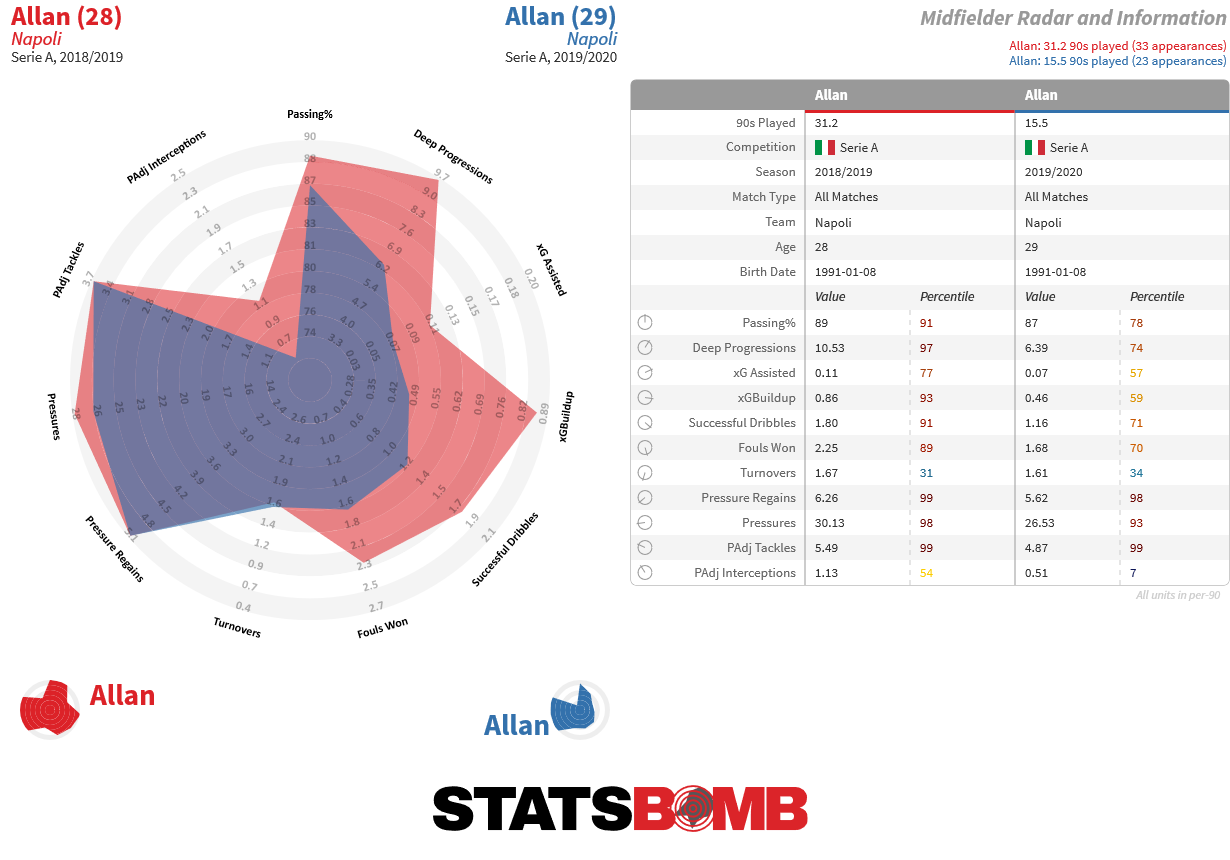 We can see here that 2019-20 under Gennaro Gattuso saw his on the ball metrics drop back, while he maintained extremely high pressure metrics. To be fair, his season was stop-start with niggling injuries and time on the bench impacting his overall game time. There is an understandable degree of caution in that he's soon to turn 30 years old, and the hope here has to be that he can continue to contribute at levels seen prior to last season. However for his stylistic profile, the balance between "he is a great player" and "he is at the wrong end of the age curve" is impossible to deny. Age queries are also something that can be aimed at James Rodriguez, who looks likely to join up this week too. As a former Galactico of sorts, his pedigree is undeniable, and as a creative, flair player, concerns about his residual quality and reliability as he ages are perhaps less than that of Allan. It's really not that long since he was at Bayern putting together a profile like this:
We can see here that 2019-20 under Gennaro Gattuso saw his on the ball metrics drop back, while he maintained extremely high pressure metrics. To be fair, his season was stop-start with niggling injuries and time on the bench impacting his overall game time. There is an understandable degree of caution in that he's soon to turn 30 years old, and the hope here has to be that he can continue to contribute at levels seen prior to last season. However for his stylistic profile, the balance between "he is a great player" and "he is at the wrong end of the age curve" is impossible to deny. Age queries are also something that can be aimed at James Rodriguez, who looks likely to join up this week too. As a former Galactico of sorts, his pedigree is undeniable, and as a creative, flair player, concerns about his residual quality and reliability as he ages are perhaps less than that of Allan. It's really not that long since he was at Bayern putting together a profile like this: 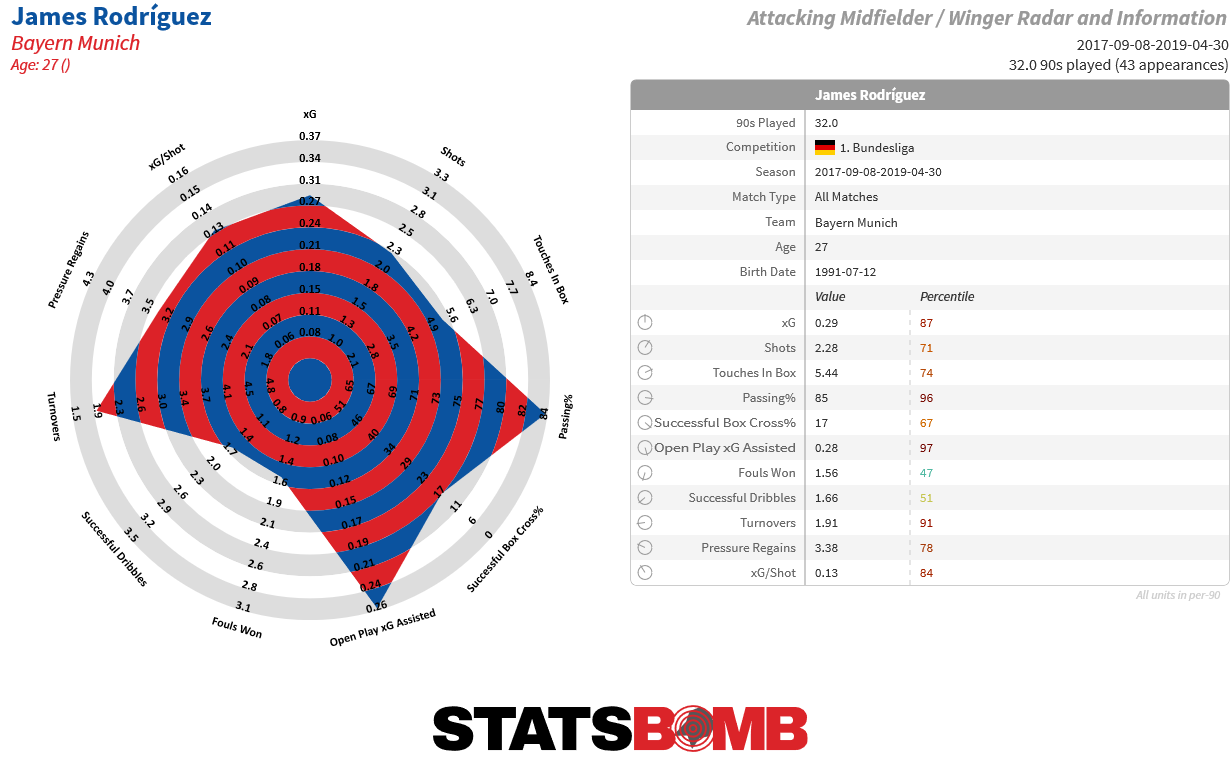 Dominic Calvert-Lewin and Richarlison will undoubtedly be thrilled to see a world class creator teeing up set pieces and throughballs for them. The upgrade here versus Gylfi Sigurðsson is nothing short of huge. The warning when Sigurðsson signed for Everton was that so much of his shot creation was inhabited within set pieces. He got 12 assists for Swansea in 2016-17 and only four were from open play. His actual key pass rate was a shade over 0.5 per game which is miniscule for any nominally creative player. His seasons at Everton have seen this rate broach one per 90 only once (1.03 in 2018-19) and he was back at below 0.5 in 2019-20. James gives you at least as much as Sigurðsson from set-pieces while adding elite open play shot creation numbers on top, reliably over two per game. This difference is shown amply by James' open play key pass chart at Bayern vs that of Sigurðsson last season for Everton. Even allowing for difference of quality in team-mate, the variation is stark and by any stretch, James as an upgrade is hugely enticing. He's also two years younger:
Dominic Calvert-Lewin and Richarlison will undoubtedly be thrilled to see a world class creator teeing up set pieces and throughballs for them. The upgrade here versus Gylfi Sigurðsson is nothing short of huge. The warning when Sigurðsson signed for Everton was that so much of his shot creation was inhabited within set pieces. He got 12 assists for Swansea in 2016-17 and only four were from open play. His actual key pass rate was a shade over 0.5 per game which is miniscule for any nominally creative player. His seasons at Everton have seen this rate broach one per 90 only once (1.03 in 2018-19) and he was back at below 0.5 in 2019-20. James gives you at least as much as Sigurðsson from set-pieces while adding elite open play shot creation numbers on top, reliably over two per game. This difference is shown amply by James' open play key pass chart at Bayern vs that of Sigurðsson last season for Everton. Even allowing for difference of quality in team-mate, the variation is stark and by any stretch, James as an upgrade is hugely enticing. He's also two years younger: 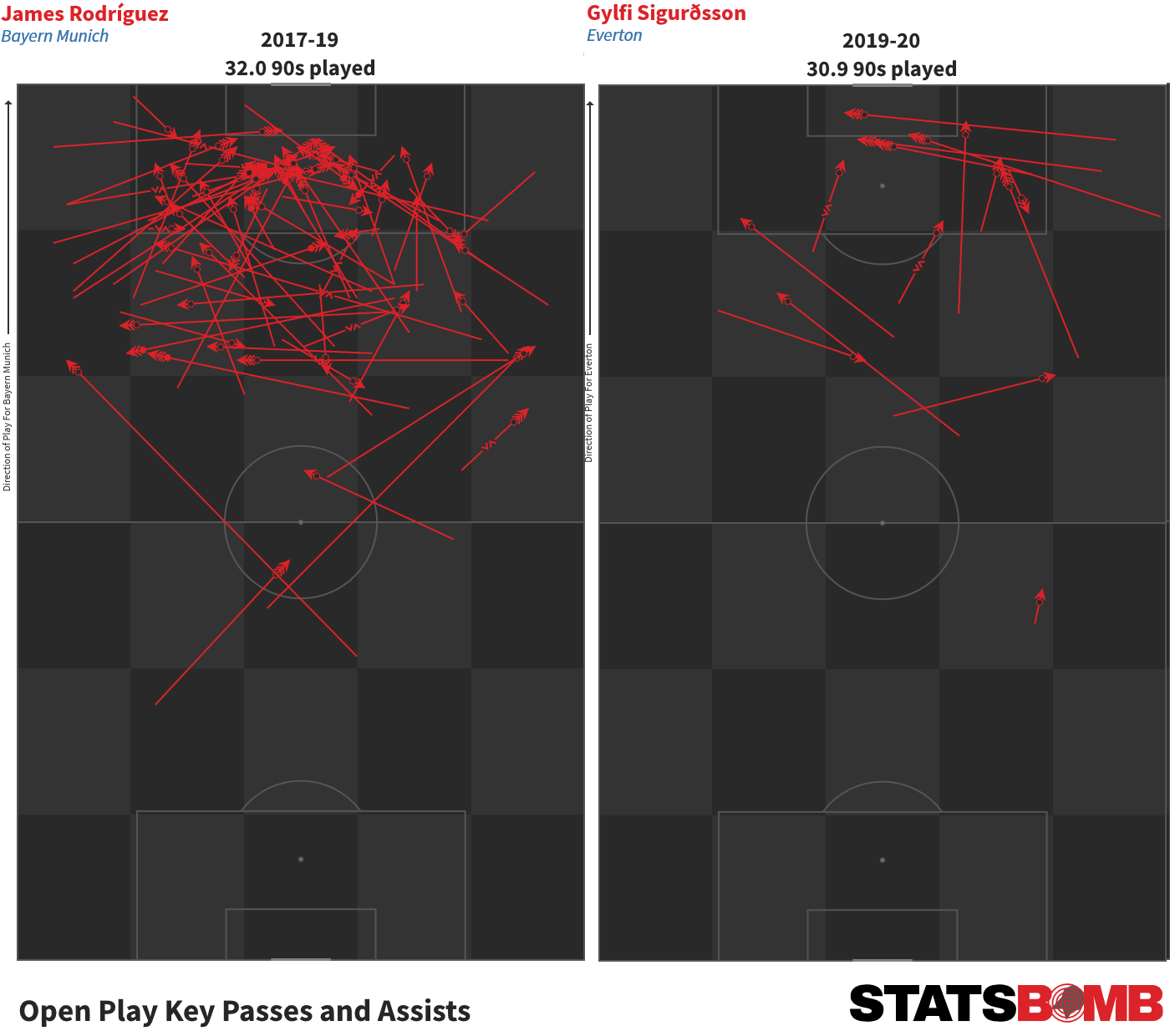 James also has experience under Ancelotti for a brief period during their time at Bayern Munich, so there could well be some benefit from these high quality players being able to join up, and quickly drop in to the team. Do Allan's legs allow James to create with some impunity? Perhaps so, but undeniably, their recruitment improves Everton in an area they were likely weakest and certainly makes the short term likelihood of Everton raising their floor very real. Given erratic game time for each in recent times, it will be interesting to see how frequently they feature and how frequently Everton get a full shift from them. As much as queries around contracting players into their 30s will persist, getting Everton's first 11 onto the pitch reliably will have a large impact on outcomes. It's also looking as though Abdoulaye Doucouré will be joining from Watford. As an aside a quick glace at the squad makes me feel a little more full back depth could go a long way. Projection What is success for this team this season? Everton have invested in players at a cost that demands a challenge to the top six. At times it has felt as though each new manager and season has been treated as a blank canvas, and the residual squad members from previous regimes have been hard to move on. Everton need to find a way to move on from that cycle, and on balance, enough of their more recent recruitment in the Marcel Brands era has created a team that at its core has the makings of a prosperous side. Very little more needs to go right to regain a slot in the eternal seventh to tenth zone that Everton frequently occupy, but a big impact from their new recruits could steer them upwards. Sporting Index opened up with a ninth placed 52-53 point estimation and that may be a low base, considering what we know about 2019-20 and the Ancelotti era. As discussed, his actual point accrual rate was about five points ahead of that and a further handful of points probably gets you to the top six mix. Maximising outcome is Ancelotti's challenge. He needs to get close to the top six for 2020-21 to be deemed successful. The form of the team was concerning during the restart, but it can be hoped that the planning was orientated towards this season instead. Teams that understand the brutal schedule and plan to adapt will be set-up to fare best in 2020-21 and there is an opportunity here for those that do. Everton do have a large squad too. If Ancelotti can't manage to point this team upwards, further change in management and personnel may be in the offing, and the cycle could recur.
James also has experience under Ancelotti for a brief period during their time at Bayern Munich, so there could well be some benefit from these high quality players being able to join up, and quickly drop in to the team. Do Allan's legs allow James to create with some impunity? Perhaps so, but undeniably, their recruitment improves Everton in an area they were likely weakest and certainly makes the short term likelihood of Everton raising their floor very real. Given erratic game time for each in recent times, it will be interesting to see how frequently they feature and how frequently Everton get a full shift from them. As much as queries around contracting players into their 30s will persist, getting Everton's first 11 onto the pitch reliably will have a large impact on outcomes. It's also looking as though Abdoulaye Doucouré will be joining from Watford. As an aside a quick glace at the squad makes me feel a little more full back depth could go a long way. Projection What is success for this team this season? Everton have invested in players at a cost that demands a challenge to the top six. At times it has felt as though each new manager and season has been treated as a blank canvas, and the residual squad members from previous regimes have been hard to move on. Everton need to find a way to move on from that cycle, and on balance, enough of their more recent recruitment in the Marcel Brands era has created a team that at its core has the makings of a prosperous side. Very little more needs to go right to regain a slot in the eternal seventh to tenth zone that Everton frequently occupy, but a big impact from their new recruits could steer them upwards. Sporting Index opened up with a ninth placed 52-53 point estimation and that may be a low base, considering what we know about 2019-20 and the Ancelotti era. As discussed, his actual point accrual rate was about five points ahead of that and a further handful of points probably gets you to the top six mix. Maximising outcome is Ancelotti's challenge. He needs to get close to the top six for 2020-21 to be deemed successful. The form of the team was concerning during the restart, but it can be hoped that the planning was orientated towards this season instead. Teams that understand the brutal schedule and plan to adapt will be set-up to fare best in 2020-21 and there is an opportunity here for those that do. Everton do have a large squad too. If Ancelotti can't manage to point this team upwards, further change in management and personnel may be in the offing, and the cycle could recur.
If you're a club, media or gambling entity and want to know more about what StatsBomb can do for you, please contact us at Sales@StatsBomb.com We also provide education in this area, so if this taste of football analytics sparked interest, check out our Introduction to Football Analytics course Follow us on twitter in English and Spanish and also on LinkedIn
Newcastle's metrics last season were bad enough to immediately make them one of the default favourites for relegation this time around. They finished 13th with a points total that was within the same range as the two previous years, but other top-line and underlying numbers revealed notable decline.
Steve Bruce’s side scored slightly fewer goals than in either of those campaigns while conceding 10 more, leading to a goal difference of -20 compared to those of -6 and -8 in the preceding seasons. That was mirrored in the metrics: the attack got marginally worse; the defence, dramatically so.
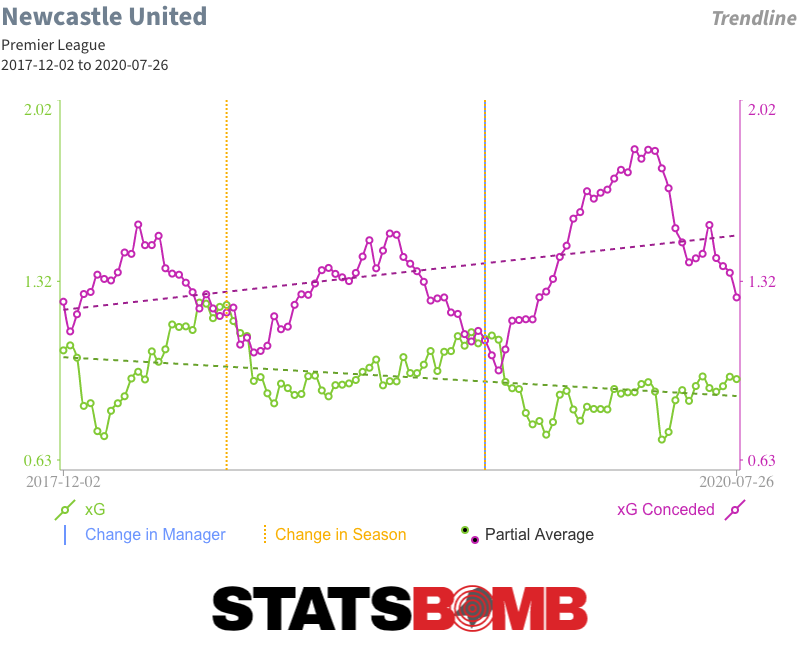
In combination, the second-worst attack and third-worst defence in the league gave them its worst expected goal (xG) difference.
So how did they stay up? Not only that, but relatively comfortably so? Two things happened: Newcastle overperformed their metrics to a greater degree than teams like Aston Villa and West Ham who finished below them, while the three relegated sides all underperformed theirs fairly significantly. Take either away and the Magpies would have been right on the cusp of relegation. Take both away, and it would have been a near certainty.
The defence falling away upset the delicate balance of the Rafael Benítez years. Under him, Newcastle were comfortably below average in attack but had the seventh best defence in the league in both 2017-18 and 2018-19. That kept them within respectable distance of a par goal difference and the mid-table safety that comes with it.
The scale of the defensive deterioration was impressive, particularly given the relative lack of squad turnover. In addition to the aforementioned 10-goal negative swing including penalties, Newcastle were 14 non-penalty goals and 9.24 xG worse off that the previous season.
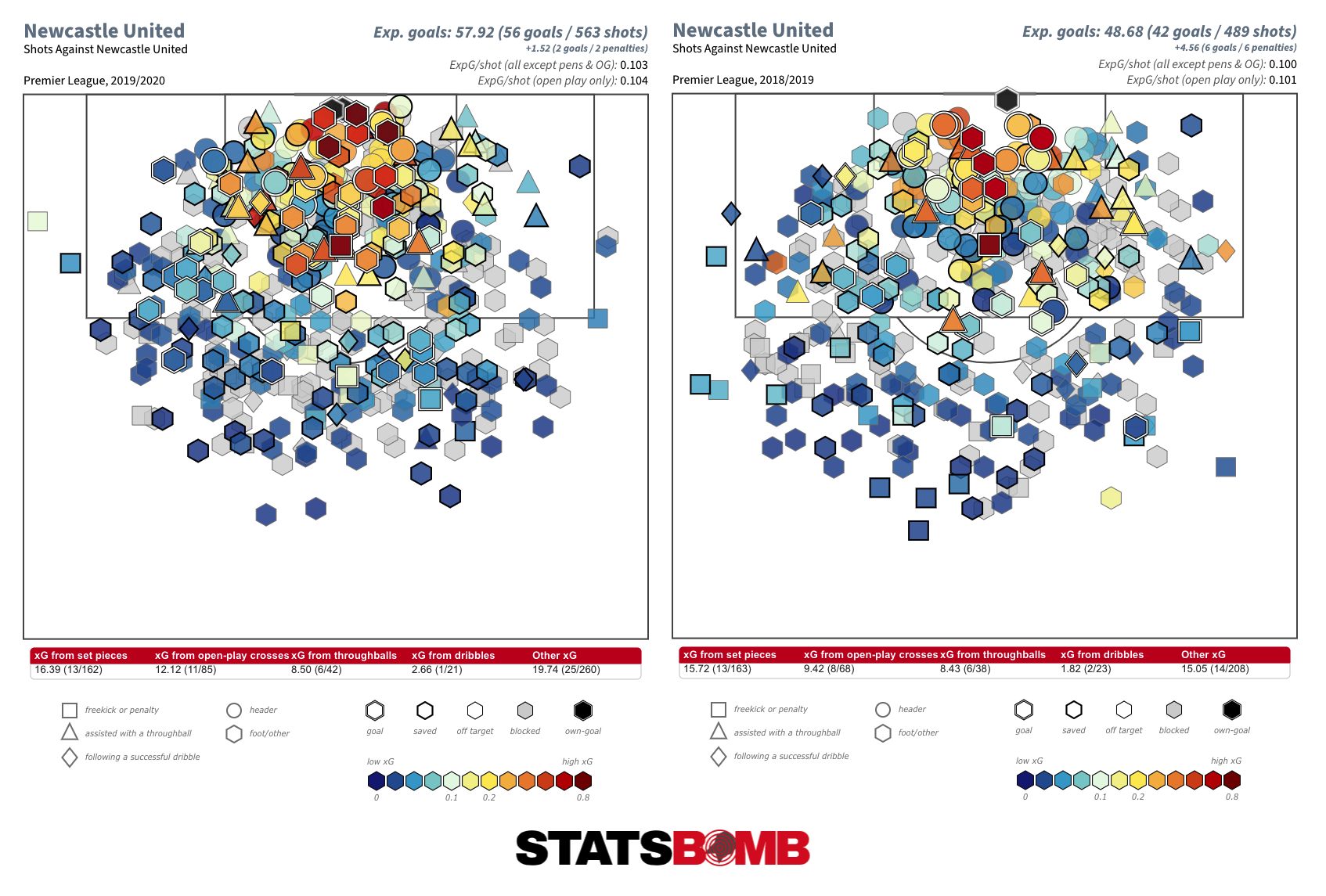
Under Benítez, Newcastle always defended a fair amount deeper and less proactively than the league average, but last season they just completely retreated into their shell. They defended deeper than any other side in the division and became almost comically passive.
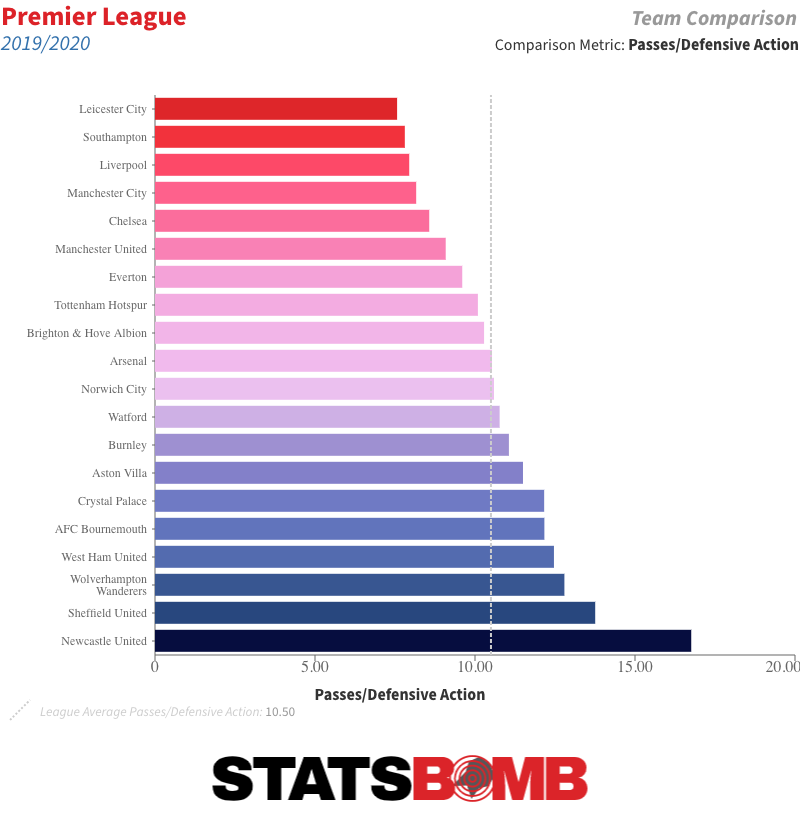
If Bruce’s idea was to restrict opposition shot quality by getting large numbers of players behind the ball then it really didn’t work out. Newcastle conceded around two more shots per match than the previous season (14.76, third worst in the league) without any change in the average quality of them.
It also doesn’t say much for his work on the training ground that Newcastle were genuinely bad at defending set pieces. Only two teams conceded more than their 13 goals from those situations, while their xG conceded of 16 was pretty comfortably the worst in the division. It wasn’t simply a case of Newcastle giving up a lot of set pieces, and consequently a lot of chances for opponents to create chances from them, due to their deep stance. They were about average in that, and anyway they were also the worst side in the league in terms of xG per set piece conceded.
The defence may have been the area of the team that declined most season-on-season, but Newcastle’s deficiencies in attack were no less alarming. A five-goal positive swing versus their expected numbers just about got them up to an average of one goal per match, but this was a team who really struggled to work the ball into good shooting positions.
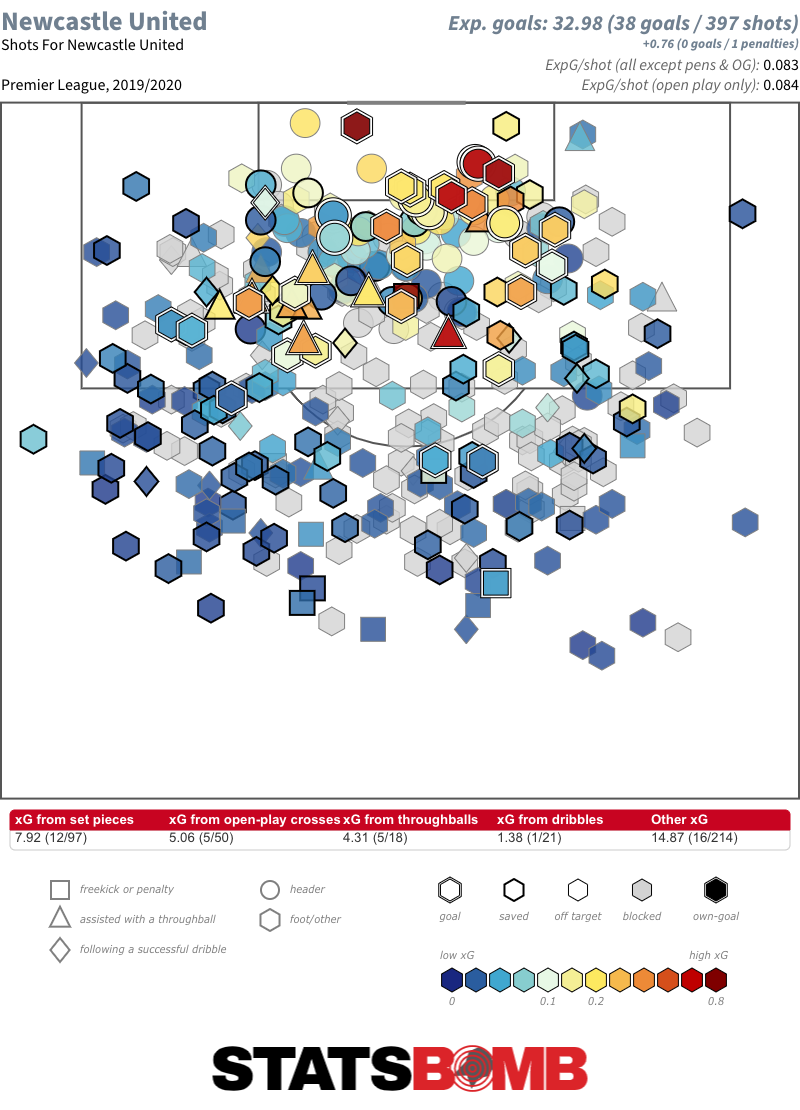
The Magpies took a below-average number of shots (10.45 per match), and those they did take were of the lowest average quality in the league. They took their shots from further out and got off less efforts from inside the area than any other team. Whenever they did shoot, they had more opposition defenders between shooter and goal than any other side.
There was a broader problem there. Newcastle lacked a reliable means of progressing the ball into advanced areas. No team in the league completed less passes within 20 metres of the opposition goal. Aside from Matt Ritchie, who missed just under the half the season through injury, no one else was able to successfully move the ball into the penalty area with even a semblance of regularity.
Newcastle were quite direct in initially advancing the ball. For the third season in a row, Jonjo Shelvey's attempted and completed passes were of a longer average length than those of any other Premier League midfielder who saw at least 900 minutes of action. That was in neat contrast to his fellow central midfielder Isaac Hayden, whose passing was demonstrably shorter and more conservative.
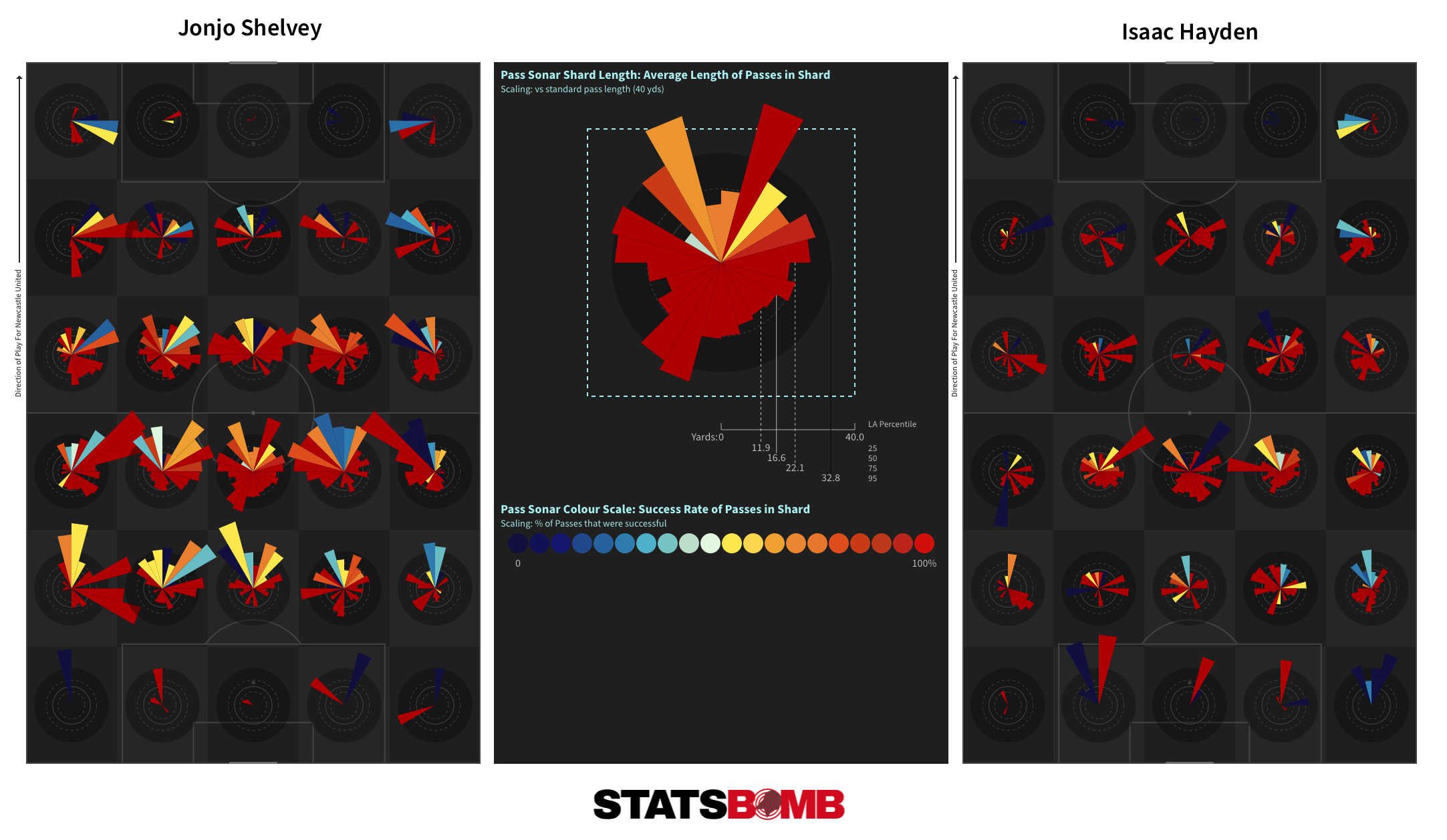
Along with Miguel Almirón, new arrivals Allan Saint-Maximin and Joelinton were Shelvey’s main targets from deeper areas. Saint-Maximin was fun to watch and also provided better end product than the rest of Newcastle’s regular attackers. Only Dwight Gayle, who only saw just over 900 minutes of action due to a recurring calf problem, bettered him in terms of both expected and actual goal and assist output per 90 minutes.
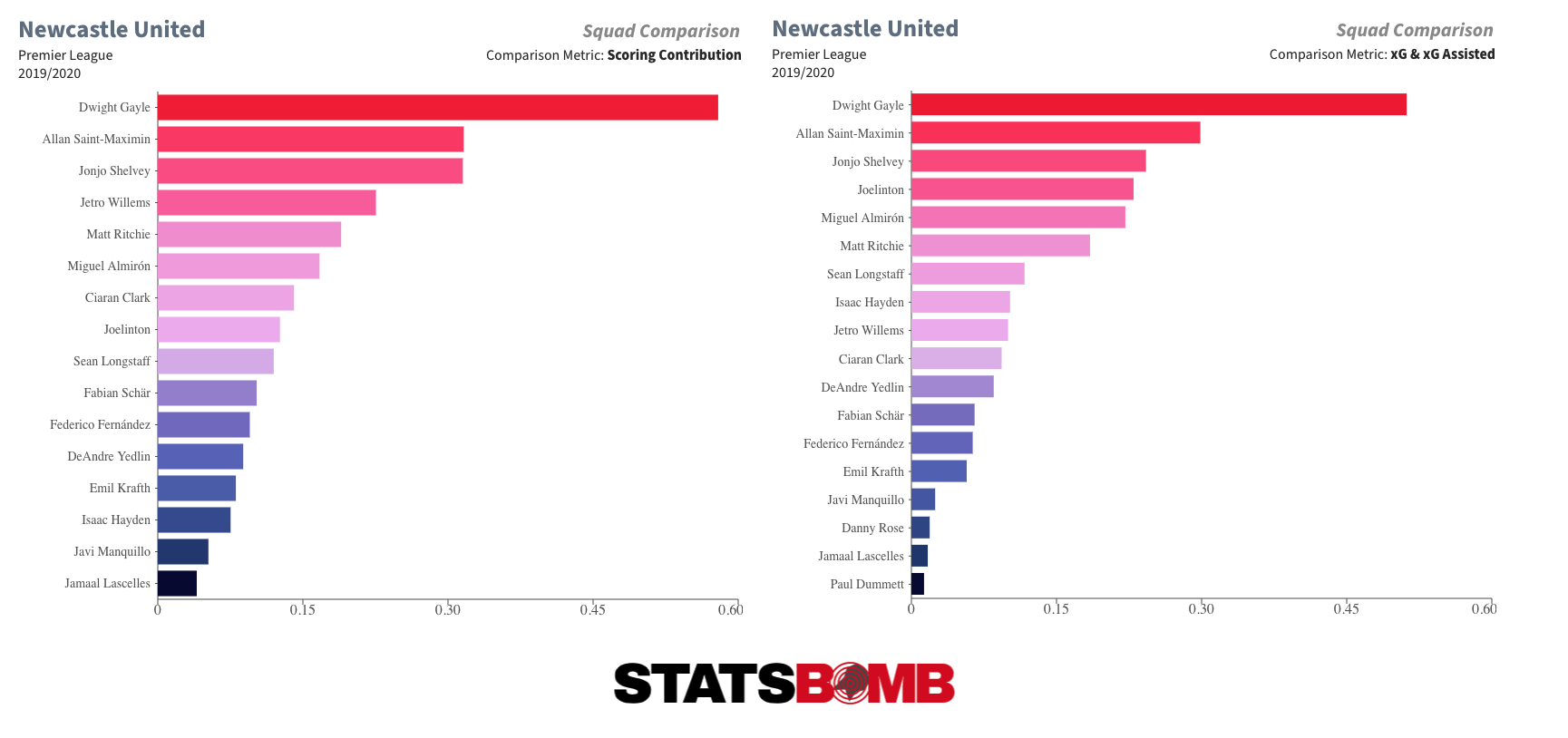
On a season total level, Shelvey was the top scorer with just six goals. No attackers got close to the marks set by the departed Ayoze Pérez (12) and Salomón Rondón (11) the season previous. Gayle and Almirón were the first attackers on the list with four. Joelinton grabbed just two from a marginally more encouraging 4.89 xG, although even that worked out to just 0.15 xG per 90.
The Brazilian striker seems to have become somewhat of a figure of fun in certain quarters, but he was rather set up to fail following his £40 million move from Hoffenheim. Not only did the fee appear inflated, but there was little evidence he was capable of playing the role Newcastle required of him. He was plucked from a high-pressing, attack-minded team with options all around him and plonked straight into the role of battering ram striker on a deep-lying, defensive-minded side with huge spaces between teammates.
If goals were what Newcastle wanted, he wasn't really the man either. He was, after all, only a one-in-three goalscorer on an attacking team in the most open of the big five European leagues. He was more roving facilitator than main striker, receiving, combining, carrying the ball forward and offering a solid combination of shot and creative output. Ishak Belfodil and Andrej Kramarić were the main goal-getters. At Newcastle, shorn of close collaborators and subjected to a bombardment of aerial service (46.81% of the passes he received were high balls, compared to just 24.36% at Hoffenheim), he looked very much out of place.

Joelinton was never going to be a direct stylistic replacement for Rondón, and his signing asks questions of the recruitment department or a huge disconnect between them and the coaching staff.
The club had made just a couple of low-profile free transfer signings ahead of the new season at time of writing, with goalkeeper Mark Gillespie and winger Jeff Hendrick coming in from Motherwell and Burnley respectively. There is talk of strong interest in the Bournemouth pair of Ryan Fraser and Callum Wilson, which would at least refresh things a little in attack, even though it is likely to take a bit more than that to avoid a struggle against the drop.
For months, hopes rested on the promise of a Saudi-backed takeover that would have brought with it a huge injection of funds and the arrival of high-profile coaching and playing staff. Regardless of where you stand on the Premier League’s decision to deny it, it was undeniably a much more enticing prospect than the alternative: another season of Bruce and the gang.
Relying on enough other teams to be worse and/or more unlucky than you it not a viable long-term strategy for remaining in the Premier League. Something has to change in comparison to last season, but it is genuinely hard to see where that change and improvement might come from within the current coaching and playing staff, certainly under the stewardship of the current ownership. If it doesn’t, Newcastle may just sleep walk their way to relegation.
If you're a club, media or gambling entity and want to know more about what StatsBomb can do for you, please contact us at Sales@StatsBomb.com We also provide education in this area, so if this taste of football analytics sparked interest, check out our Introduction to Football Analytics course Follow us on twitter in English and Spanish and also on LinkedIn
Champions League, World Club Cup and Premier League. Game completed. What comes next? The 2019-20 season wasn't just odd due to the three month winter break in the middle of it. It was odd in the way that Liverpool cocked a snook at any idea that their 97 point 2018-19 total was going to be hard to replicate and promptly went charging off looking for 100. As such, the title finally returned asterisk free to Merseyside after a 30 year wait. The ever likeable Jürgen Klopp cemented his place in Anfield folklore. Usually when teams log 90+ point seasons, they follow them up by coming back down to earth a little. The two exceptions (Chelsea 2004-05 and 2005-06, 95 and 91 and Manchester City 2017-18 and 2018-19, 100 and 98) did come back down in the next season but still stayed at over 80 points which is historically great and has won many a title. There's no denying Liverpool have been exceptional for (at least) two seasons. In 2018-19, they lost one league game and were unbeaten until January. In 2019-20 they were unbeaten until February 29th, and that's not even a proper day most years, so who's to say it counts? They're consistent, they have superb talent in all positions, they have found many different ways to win and they tend to do so.
One of the tricky aspects to evaluate with regard to Liverpool 2019-20 is that quite a lot of the season ended up being a parade. They were six points clear at the end of October, ten clear by mid-December and the Club World Cup jaunt, nineteen clear by the end of January and twenty-five clear on lockdown. The revolutionary strategy of winning every* game was bearing fruit. From an analysis perspective, at what point do we shrug and ignore actual on pitch activity, because it kinda didn't matter? Liverpool's four season expected goal trendlines clearly show that the back half of 2019-20 saw some of their worst metrics in years, but again: did it really matter?
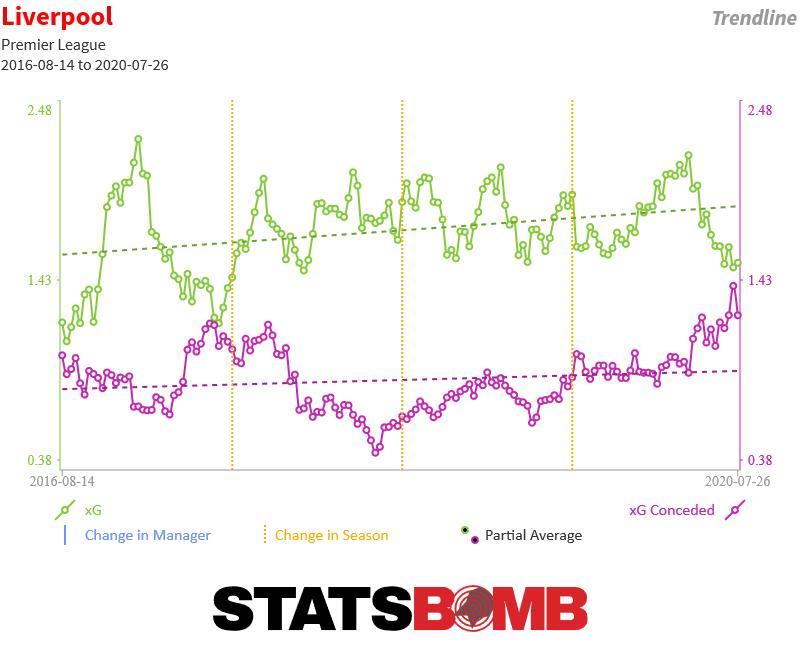
A valid point here is that Liverpool were better in 2018-19 than they were in 2019-20, but then again, they had to be. A lot has been made about the fact that Liverpool's expected metrics lagged behind those of Manchester City last season, which to my mind misses the point somewhat. That chart above shows that Liverpool have had excellent metrics for most of the last four seasons; excellent metrics put you in the mix to win titles, and Liverpool were a hair's breadth away from winning the last two. There's also the difference between necessity and game management to which a combination of quality and circumstance enabled Liverpool to navigate their way through the first half of 2019-20.
During late 2019, Liverpool were really good at getting to 2-0, and once they were at 2-0, they were really good at managing their way to the end of games. In the first half of 2019-20, they put together a 1-0, 2-0 combination within sixteen minutes eight times, seven of which were within the first half. Sure, good teams do this and all the recent points-hoarders have a fine record in building quick decisive leads, but to concentrate this into the first half of the season was notable and a worthwhile driver towards their exemplary results.
Also worthwhile was their amazing 16 game run of scoring first, which started in November and only finished in the still curious Watford defeat. Scoring first is again a hallmark of a good team, but to go 16 games without a weird ricochet or moment switching off is quite remarkable. These are the little quirks that help power dominant seasons, and while you can't rely on them to specifically recur, they sure as heck help out. Let's look at Liverpool's expected goals particularly the defensive end another way, game by game:
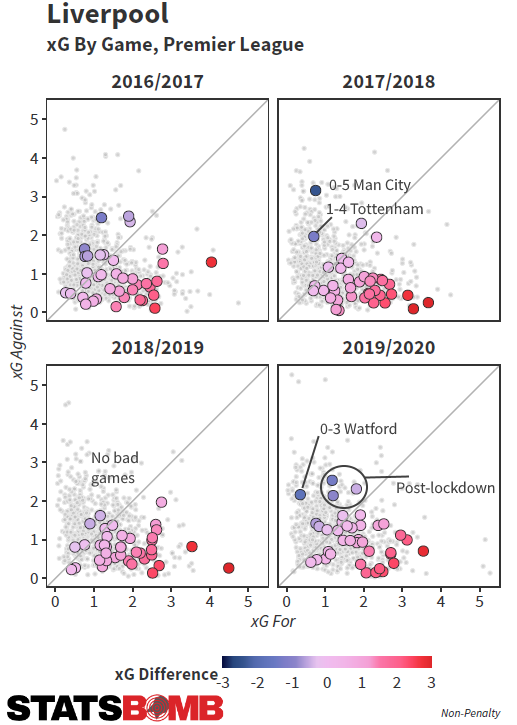 One of the main plotlines that underlies this chart is that between September 2017 and The Watford Game in February 2020, nearly two and a half years and 98 games, Liverpool did not give up more than two non-penalty expected goals in a league game. So that's the process right there; don't give up much in defence. It kicked on into reality too, as they went nearly as long without being two goals behind in a league game. This team has been so consistent for so long that the Watford game--in which they were comprehensively beaten 3-0 (2.2 vs 0.4 xG)--stands out alone in as an outlier across over 100 games. Ironically, post-Watford and post Covid break Liverpool did show vulnerability at the back and as a result "time spent behind" and "deviation from expectation while ahead" measures fell back towards more "normal" levels having been wildly out of kilter in a positive direction beforehand. Things like giving up more than two non-penalty expected goals occurred in three more games, although they won two of them (5-3 v Chelsea, 3-1 v Brighton) and only lost to Manchester City. There's not much more to be said here apart from don't make a habit of it. Personnel A quick word for Virgil Van Dijk here as he tops by a huge margin a metric I toyed with to ascertain how effective centre backs were at clearing or passing the ball out from dangerous central in-box zones:
One of the main plotlines that underlies this chart is that between September 2017 and The Watford Game in February 2020, nearly two and a half years and 98 games, Liverpool did not give up more than two non-penalty expected goals in a league game. So that's the process right there; don't give up much in defence. It kicked on into reality too, as they went nearly as long without being two goals behind in a league game. This team has been so consistent for so long that the Watford game--in which they were comprehensively beaten 3-0 (2.2 vs 0.4 xG)--stands out alone in as an outlier across over 100 games. Ironically, post-Watford and post Covid break Liverpool did show vulnerability at the back and as a result "time spent behind" and "deviation from expectation while ahead" measures fell back towards more "normal" levels having been wildly out of kilter in a positive direction beforehand. Things like giving up more than two non-penalty expected goals occurred in three more games, although they won two of them (5-3 v Chelsea, 3-1 v Brighton) and only lost to Manchester City. There's not much more to be said here apart from don't make a habit of it. Personnel A quick word for Virgil Van Dijk here as he tops by a huge margin a metric I toyed with to ascertain how effective centre backs were at clearing or passing the ball out from dangerous central in-box zones: 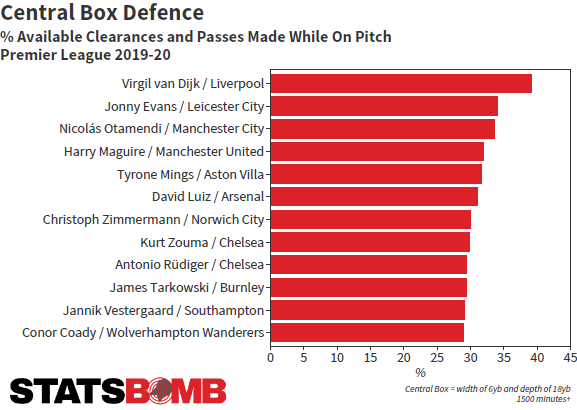 There's an interesting question around Liverpool's centre back partnerships that springs up from this. Van Dijk is evidently a dominant force within the league, but Joe Gomez is far more passive. Across two seasons his rate for this metric is around 20% (compared to Van Dijk's 35% 2018-19 and 39% in 2019-20). The now departed Dejan Lovren rated a shade higher at around 22-23% while Joel Matip was higher still at 25% and 29%. The point is that since Van Dijk arrived, he's been ever present and the three others have partnered him. When Gomez is on the pitch, you just get less defensive activity in key areas, much of which is aerial based. It's not that Van Dijk or someone else is covering, it's just a clear dropoff versus when Lovren or Matip have played. Now: does this matter? That's hard to say, but the only evidence we have recently of Liverpool's defence declining is in the recent period with Gomez alongside Van Dijk, the back half of 2019-20. The split between Gomez, Lovren and Matip to partner Van Dijk has been fairly even across the long dominant defensive period. Yes, Gomez remains the future of Liverpool's defence, but also, Matip must have a good shout at getting his place back. It will be something to monitor going forward. Elsewhere there are few surprises. The three man forward line remains as good and democratic as any in world football and there are no secrets around the full-back contributions now either. The right sided of the three midfielders tends to be the extra moving part to the attack, be it Alex Oxlade-Chamberlain or Jordan Henderson. There was a lot of chatter about Firmino's finishing last season, but in undershooting his expected goals, he wasn't obviously revealing a flaw; he'd been +3 vs expectation across the last three seasons before a blip of -4.5 in 2019-20. Closer examination shows he has finished well with his head long term and is weakest with his left foot, but he contributes so much else with regard to creation and pressing, it's erroneous to be over-critical. And Liverpool do still press, nothing's changed there:
There's an interesting question around Liverpool's centre back partnerships that springs up from this. Van Dijk is evidently a dominant force within the league, but Joe Gomez is far more passive. Across two seasons his rate for this metric is around 20% (compared to Van Dijk's 35% 2018-19 and 39% in 2019-20). The now departed Dejan Lovren rated a shade higher at around 22-23% while Joel Matip was higher still at 25% and 29%. The point is that since Van Dijk arrived, he's been ever present and the three others have partnered him. When Gomez is on the pitch, you just get less defensive activity in key areas, much of which is aerial based. It's not that Van Dijk or someone else is covering, it's just a clear dropoff versus when Lovren or Matip have played. Now: does this matter? That's hard to say, but the only evidence we have recently of Liverpool's defence declining is in the recent period with Gomez alongside Van Dijk, the back half of 2019-20. The split between Gomez, Lovren and Matip to partner Van Dijk has been fairly even across the long dominant defensive period. Yes, Gomez remains the future of Liverpool's defence, but also, Matip must have a good shout at getting his place back. It will be something to monitor going forward. Elsewhere there are few surprises. The three man forward line remains as good and democratic as any in world football and there are no secrets around the full-back contributions now either. The right sided of the three midfielders tends to be the extra moving part to the attack, be it Alex Oxlade-Chamberlain or Jordan Henderson. There was a lot of chatter about Firmino's finishing last season, but in undershooting his expected goals, he wasn't obviously revealing a flaw; he'd been +3 vs expectation across the last three seasons before a blip of -4.5 in 2019-20. Closer examination shows he has finished well with his head long term and is weakest with his left foot, but he contributes so much else with regard to creation and pressing, it's erroneous to be over-critical. And Liverpool do still press, nothing's changed there: 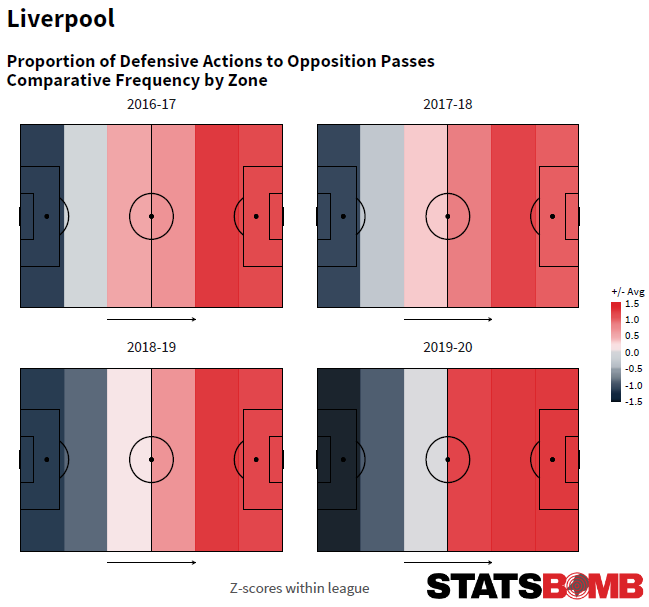 Once more off-season transfers don't seem to be the primary focus with the core first team all still within peak ages ranges and performing so well, but the team has moved finally to lock up a back-up left-back in Kostas Tsimikas. We reviewed him for our Pro Scouting project and liked him, for all that we didn't foresee a jump up to one of the best teams in the world. Our executive summary was as follows: Kostas Tsimikas is an all-round full back with a very impressive defensive output. A very aggressive presser, he somewhat foul prone. In attack he combines above average passing with decent crossing to offer a solid but unspectacular package. He can make the jump to a bigger league this summer. He also has throw-in ability, can execute combination play in build-up and is an effective ball carrier. We felt he could fit into a squad for a Europa League level team, but if we consider his age, and the stylistic package as a relatively well priced gamble to back up one of the world's best left backs, it's hard not to like.
Once more off-season transfers don't seem to be the primary focus with the core first team all still within peak ages ranges and performing so well, but the team has moved finally to lock up a back-up left-back in Kostas Tsimikas. We reviewed him for our Pro Scouting project and liked him, for all that we didn't foresee a jump up to one of the best teams in the world. Our executive summary was as follows: Kostas Tsimikas is an all-round full back with a very impressive defensive output. A very aggressive presser, he somewhat foul prone. In attack he combines above average passing with decent crossing to offer a solid but unspectacular package. He can make the jump to a bigger league this summer. He also has throw-in ability, can execute combination play in build-up and is an effective ball carrier. We felt he could fit into a squad for a Europa League level team, but if we consider his age, and the stylistic package as a relatively well priced gamble to back up one of the world's best left backs, it's hard not to like. 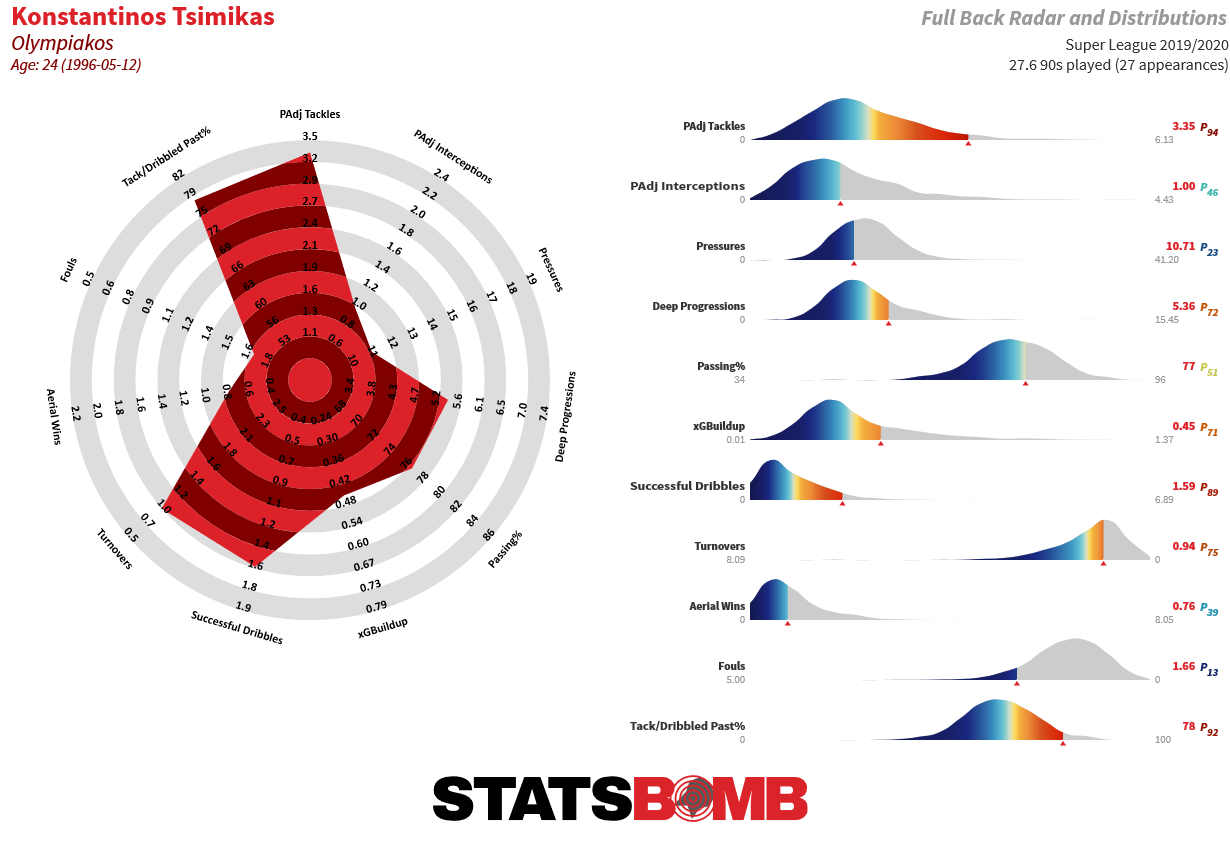 The other will he/won't he saga is the tempting switch to bring Thiago Alcântara in for Georginio Wijnaldum. The role of Wijnaldum has long been tricky to pin down, as it scarcely reveals itself via obvious numerical means, but his positioning, ball retention and discipline have clearly contributed plenty to the success of this team. He's also reliably fit, which is something that can't be said of Thiago. With a year on his contract and on the cusp of 30, Wijnaldum's time may have passed, and Barcelona are rumoured to be interested. Thiago is one of the world's best midfielders and appears to be looking for a
The other will he/won't he saga is the tempting switch to bring Thiago Alcântara in for Georginio Wijnaldum. The role of Wijnaldum has long been tricky to pin down, as it scarcely reveals itself via obvious numerical means, but his positioning, ball retention and discipline have clearly contributed plenty to the success of this team. He's also reliably fit, which is something that can't be said of Thiago. With a year on his contract and on the cusp of 30, Wijnaldum's time may have passed, and Barcelona are rumoured to be interested. Thiago is one of the world's best midfielders and appears to be looking for a pay day new challenge, and sure, he's about the same age, but we're not going to get Lionel Messi in the Premier League this summer, can we have him instead? However this little dance plays out, it would be preferable if one of these players was on Merseyside next season: 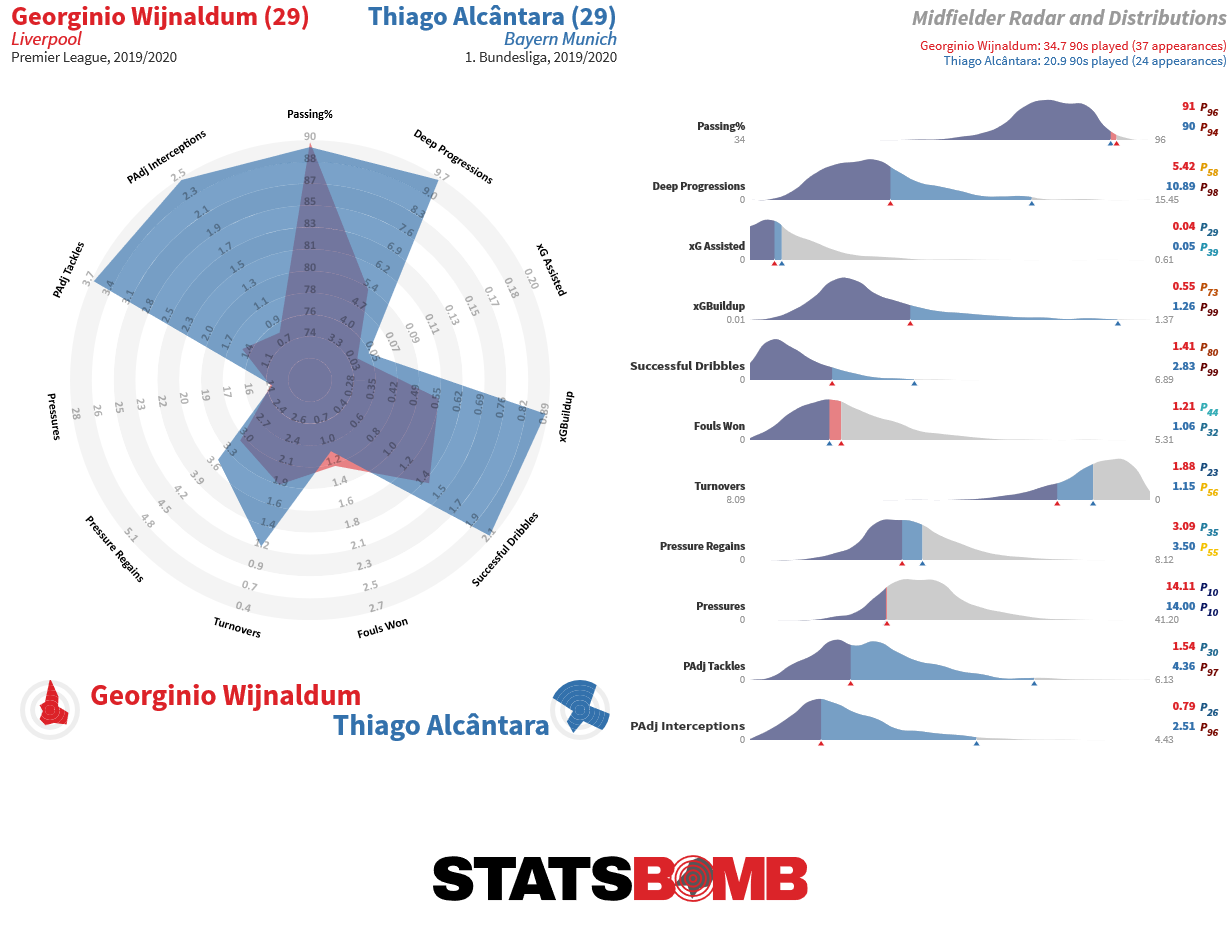 Projection Once he'd raised then to the standard of title winners, Klopp got three more decent seasons out of Borussia Dortmund, before the team suffered in 2014-15. Even with key members of this team aging together, it still seems likely that the absolute core of this team has another couple of years before remedial work is required. As we've seen with Barcelona, the problem is when much of your core talent is 32 to 33 not 28 to 30. As it's now 6 months since Liverpool have played a legitimate competitive and meaningful fixture, it has to be said: they will need to regroup, focus and start this season at the top of their game. This is Klopp's real challenge this season. As they have achieved their immediate goals, he needs to maintain the focus that got them there to compete at the same level again. It would not be surprising if this team dropped back ten points, and were still excellent in the main. That felt like the most likely outcome last season too and they rose to the challenge with some aplomb. Sporting Index's early lines peg them around here too, close enough to Manchester City (for whom excellent overall metrics will inevitably drive betting lines). But this Liverpool side the same team that got to two Champions League finals. The same team that landed back to back high-90 point totals. Predicting them outside the mix is not realistic. Every year that Klopp has been in charge it has appeared that they have learned a new technique to ensure that they can go longer and deeper into seasons (remember the bad Januarys?). Last season it felt like they had learned to manage their way out of games from advantageous positions, conserving energy for the inevitable hard grind of a tight schedule. This year the schedule will be tighter than ever, and this is a team that understands that consistency will take them furthest. If you turn up every gameweek and put up two expected goals to your opponent's one, you will win a lot of matches. Liverpool have been more consistent than their rivals for most of two seasons. They just have to be so again.
Projection Once he'd raised then to the standard of title winners, Klopp got three more decent seasons out of Borussia Dortmund, before the team suffered in 2014-15. Even with key members of this team aging together, it still seems likely that the absolute core of this team has another couple of years before remedial work is required. As we've seen with Barcelona, the problem is when much of your core talent is 32 to 33 not 28 to 30. As it's now 6 months since Liverpool have played a legitimate competitive and meaningful fixture, it has to be said: they will need to regroup, focus and start this season at the top of their game. This is Klopp's real challenge this season. As they have achieved their immediate goals, he needs to maintain the focus that got them there to compete at the same level again. It would not be surprising if this team dropped back ten points, and were still excellent in the main. That felt like the most likely outcome last season too and they rose to the challenge with some aplomb. Sporting Index's early lines peg them around here too, close enough to Manchester City (for whom excellent overall metrics will inevitably drive betting lines). But this Liverpool side the same team that got to two Champions League finals. The same team that landed back to back high-90 point totals. Predicting them outside the mix is not realistic. Every year that Klopp has been in charge it has appeared that they have learned a new technique to ensure that they can go longer and deeper into seasons (remember the bad Januarys?). Last season it felt like they had learned to manage their way out of games from advantageous positions, conserving energy for the inevitable hard grind of a tight schedule. This year the schedule will be tighter than ever, and this is a team that understands that consistency will take them furthest. If you turn up every gameweek and put up two expected goals to your opponent's one, you will win a lot of matches. Liverpool have been more consistent than their rivals for most of two seasons. They just have to be so again.
If you're a club, media or gambling entity and want to know more about what StatsBomb can do for you, please contact us at Sales@StatsBomb.com We also provide education in this area, so if this taste of football analytics sparked interest, check out our Introduction to Football Analytics course Follow us on twitter in English and Spanish and also on LinkedIn
The last game of the season, West Ham versus Aston Villa. Six minutes from time, Jack Grealish scored to make it 1-0. The talisman of Villa’s season, the homegrown boy-come-good, had done it again. Villa were safe from relegation.
Within 90 seconds, Andriy Yarmolenko had contrived to equalise. A freak deflection caused the ball to loop over Pepe Reina and make it 1-1. Immediately, Villa’s entire season was back balancing precariously on a knife edge. Fortunately, little of note filled those remaining few, long minutes and Villa’s tenure in the Premier League was extended for another season. They hadn’t done it the easy way--eight points from their last four games were required--but they had done enough, just. For Bournemouth and Watford, this meant disaster, relegation and the acceptance that close only counts in horseshoes and hand grenades.
The transition back to the Premier League was at no point smooth for Villa. The squad arrived at the gates of the big house short-handed and significant investment was required to compete. Last summer, fees of around £130m were agreed to bring in twelve new players and a risky overhaul took place. Was 17th place a good enough return for that investment? Apparently not as large scale changes have now been made to the team involved in that spree. Johan Lange replaced Jesus Garcia Pitarch as Sporting Director and Rob Mackenzie has now arrived as Head of Recruitment. Each has some heritage in using data, with Lange telling Sky Sports in February that while at Copenhagen:
“At the identification phase, our process is very data-driven. We are trying to find players earlier in their career. That is difficult to predict but it is important to try. The partnership between myself, the manager and the scouts is crucial. We take time at the start of the process to establish exactly what we are looking for. Then we can set the parameters with the data. It is only after that stage that it becomes about live scouting.”
Mackenzie is well known in terms of data and recruitment having worked at Leicester, Tottenham, Derby and Leuven while also acting as a mentor for candidates in Opta’s Pro Forum. There have also been changes in the backroom staff with the arrival of Craig Shakespeare, fresh from a semi-successful short tenure with Nigel Pearson at Watford.
Villa’s 2019 recruitment appeared somewhat scattergun (with a curious interest in the Belgian league), while the club has tried and abandoned a data-led strategy before, albeit with Tim Sherwood in charge. Can this time be different? It certainly makes sense to add more accountability to the process and with another potential large scale investment ahead of this new season, the new mens’ moxie will be tested quickly. The fundamental contradiction to overcome here is to buy players for now and a more comfortable season in the Premier League while having half a mind on building for the long term future. It is not always straightforward to balance these two aims, but is paramount here.
The metrics were clear enough in 2019-20: Villa ranked 19th for expected goal difference. However, post lockdown, Villa’s defence was excellent with only Leicester and the two Manchester sides allowing a lower xG Against, and shots against dropping from a woeful 18 per game down to just 10.
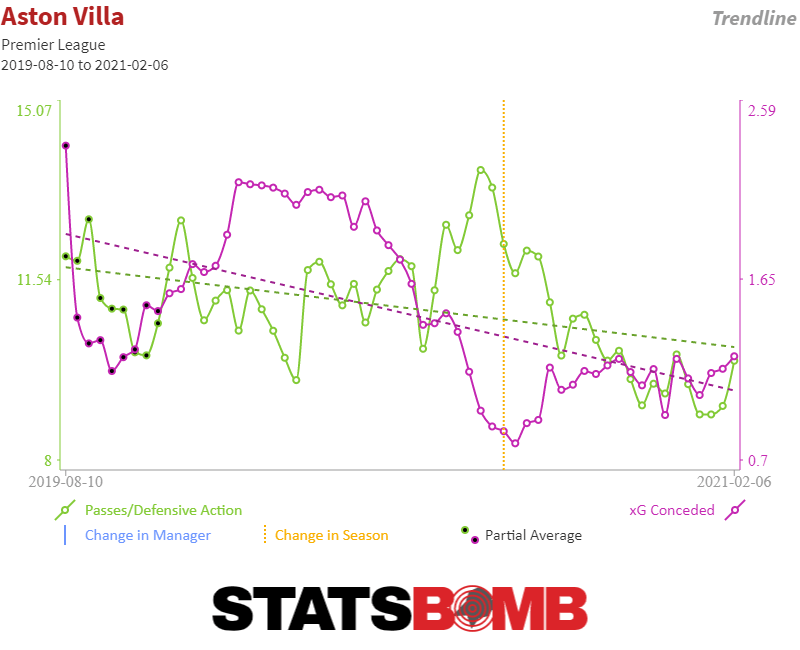
It's unwise to weigh expectation too heavily on the post-break games, but it appears possible to make a case here that Dean Smith and his coaching team were not idle during the enforced break. There is a degree of caution here though again, as typically Smith teams have been somewhat vulnerable to giving up shots, and the whole season line still reads "most shots against" and "most counter attacking shots against".
If the defence is possibly on the right track, the fan view of recruitment comes into play and that is: "we need more attackers". Jack Grealish was the star of Villa’s season, but the advanced left sided position he ended up playing came as much from necessity as suitability. Up front, Wesley was not contributing effectively (5 goals from around 1.6 shots per 90) before a New Year’s Day injury finished his season while his swiftly purchased replacement, Mbwana Samatta fared even worse (one goal from 1.5 shots per 90). Grealish top scored with eight while Trézéguet rescued an otherwise underwhelming season with some key goals down the stretch to get to six. A scorer was lacking and Grealish's strengths alone aren't enough to power an entire attack by himself:
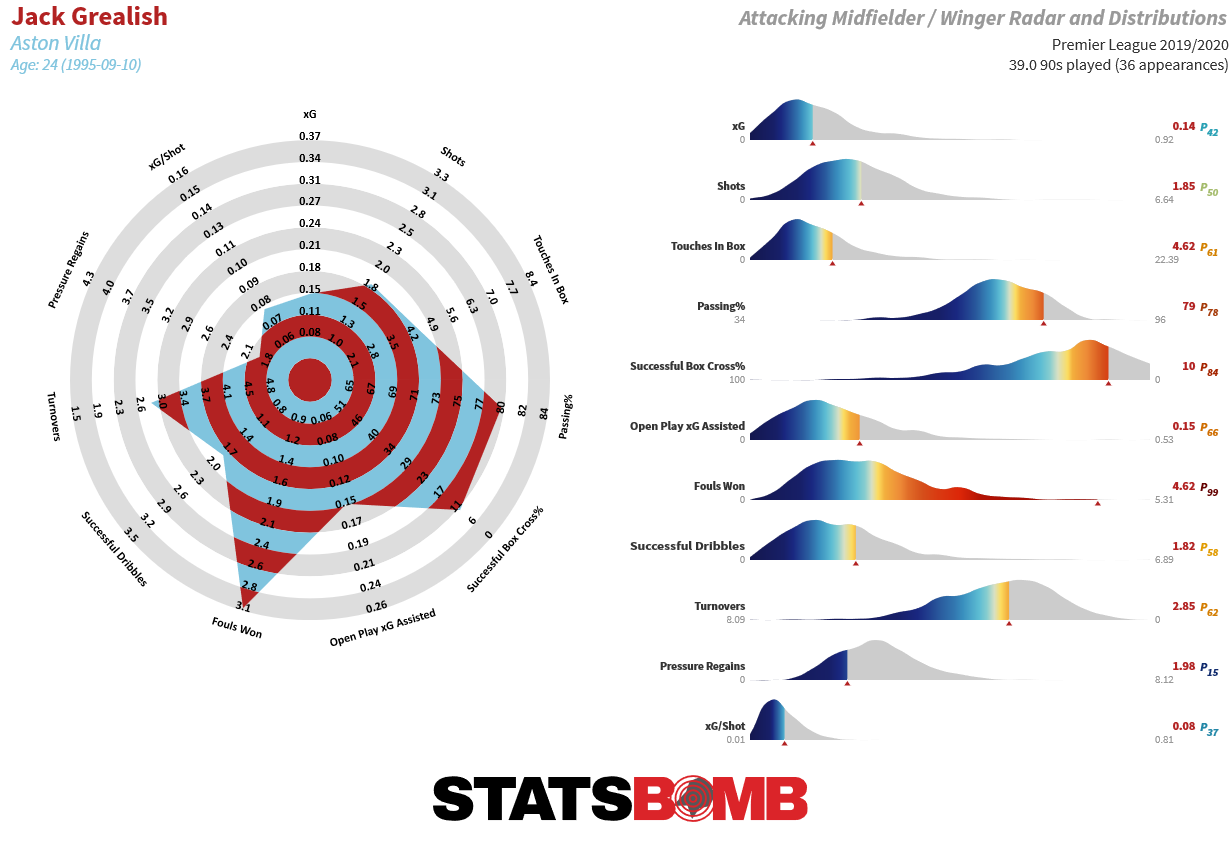
Grealish spent the back half of the season being mercilessly trailed by a sign labelled “Has been fouled more than any other player in the Premier League” that leapt onto TV screens the moment he featured. That trait could be a double edged sword too. Frustratingly Grealish can often kill attacks by holding on too long and drawing the foul, but those fouls can be productive too. Villa’s thirteen goals from set pieces was enough to rank them joint fourth in the division and included five from indirect free kick situations. This was useful as the attack was limp in open play. In ranking in amongst the stragglers both before and after the pandemic break. Villa’s 17th place finish was everything they needed from the season, but from a performance standpoint, it was impossible to upgrade.
The noise on transfers is that some of the Championship's best are being eyed, and the arrival of Matty Cash from Nottingham Forest has finally kicked off the summer's recruitment round. There's a deal of sense behind this move, as Frédéric Guilbert was the starting right back for the whole period in which Villa's defence was awful and played little after the restart while Ahmed El Mohamady is 32 years old and was nominally back-up last season anyway, a role he can continue to play. As a converted wide man, perhaps the attacking instincts of Cash will allow some added contribution down that flank. There is an obvious upgrade with regard to passing, with Cash completing nearly 75% of his passes in or into the final third last season compared to Guilbert down at close to 50%. Cash is more able to carry the ball from deep and when he gets to the final third penetrate the penalty box or get deep, as we can see here:
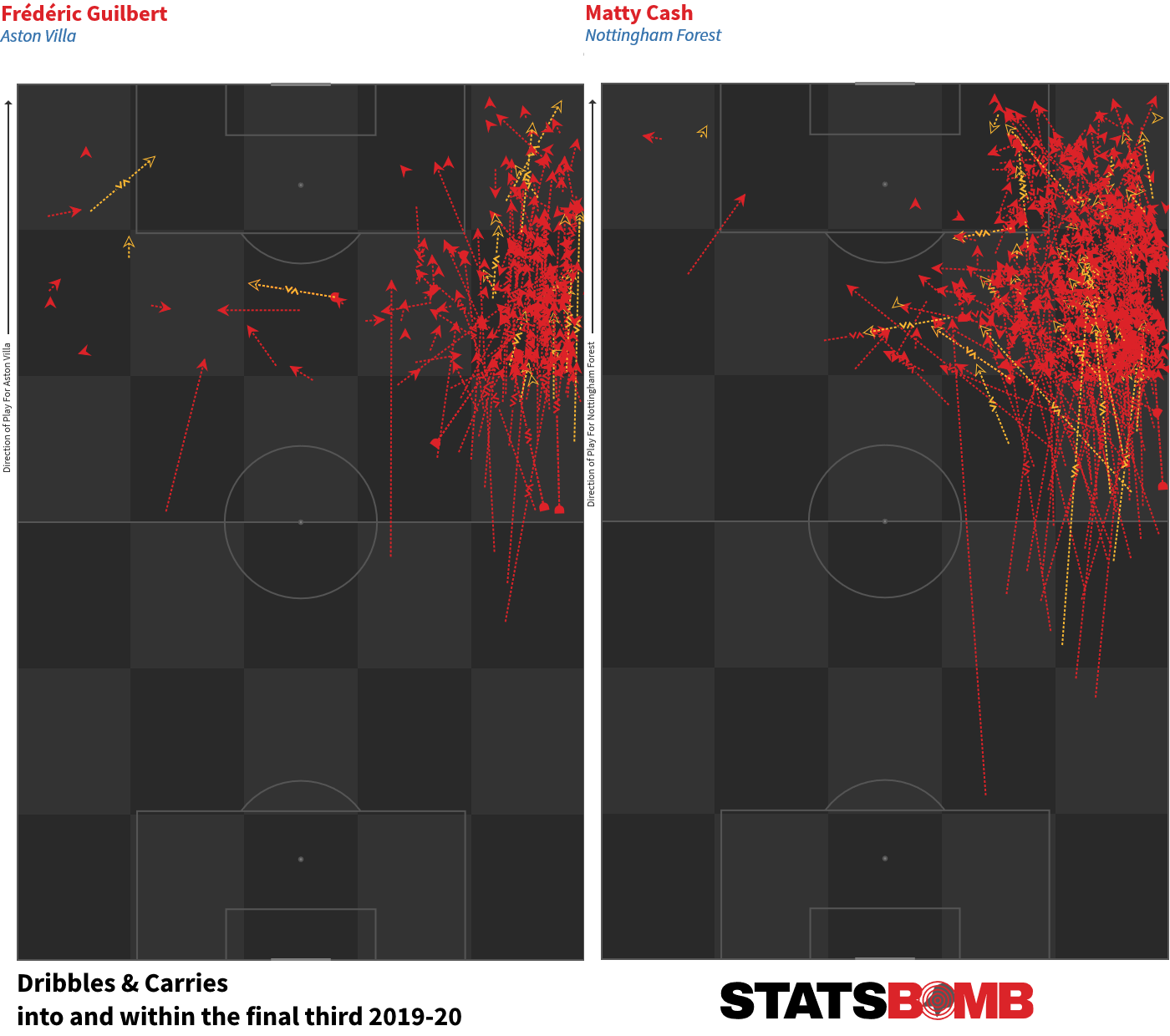
These may sound like small aspects, but it's important that Villa make these incremental improvements in every new player they sign. After Cash, there's still a requirement to beef out goal scoring and goal creation, and it would be no surprise if Villa ended up depositing a large cheque at Brentford for one of their jewels. Ollie Watkins is the obvious play here after his 26 goal 2019-20, but his shot map shows us why alone, he or anyone with a similar shooting profile can't be the last signing:
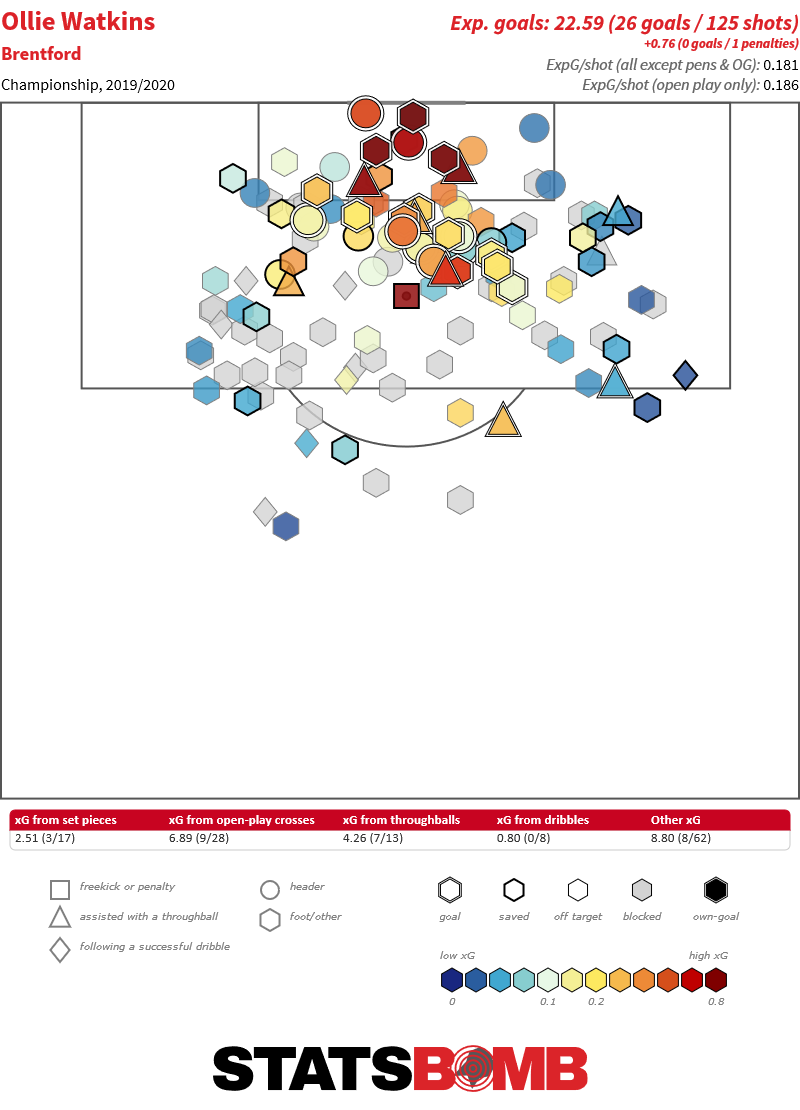
With 24 of 26 goals from within the space between the penalty spot and the goal, he will need providers to give him these chances. Grealish was Villa's only regular starter to average good volume chance creation from open play (close to two per 90, El Mohamady 1.5, then John McGinn at 1.2). He can't do it all.
Projection
So what’s the aim for 2020-21? Firstly it has to be 17th place once more. If Villa can replicate the features of the games they played post-lockdown, they have a great chance of pointing upwards, but we will need to see longer than a ten game stretch to have confidence that this can happen. And if the recruitment side of the organisation is empowered with cold, hard cash, it will be hard to suggest that Villa aren’t doing everything in their power to become a solid Premier league outfit. There also looks to be a good chance that their jewel, Grealish, will be retained. An uncertain Covid-19 world only pushes him deeper into the zone formerly occupied by Wilfried Zaha: too valuable to sell cheaply, too expensive to be a certain purchase for one of the giants.
The Sporting Index opening lines had Villa 18th but very much in the mix with West Brom, Palace, Fulham and Newcastle as the "below 40 points" brigade. It would be trivial of me to suggest all these teams should take a guaranteed 17th place today as I did for Palace, but it remains true enough. Extremely sub-par metrics and close relegation escapes aren't naturally predictive of comfortable mid table finishes. The last few weeks of the transfer window may once more be decisive for Villa. They simply need to get stronger to ensure they can compete better this season and stay clear of trouble.
If you're a club, media or gambling entity and want to know more about what StatsBomb can do for you, please contact us at Sales@StatsBomb.com
We also provide education in this area, so if this taste of football analytics sparked interest, check out our Introduction to Football Analytics course
Follow us on twitter in English and Spanish and also on LinkedIn
It took two attempts, but last season there was finally enough ‘boing’ in the Baggies to complete their ascent back up the perpetual yo-yo that seemingly connects them from the Premier League to the Championship. Slaven Bilić will be a familiar face to top-tier dugouts, having accepted the drop in class and the challenge of returning West Brom to the top flight, and he succeeded in making them a far more convincing outfit than they had been the previous campaign. Their promotion was a formality for the most part: from September onwards, West Brom were never outside of the top two. As the post-lockdown mini-season commenced, the Baggies had nine games to hold onto a six-point lead over 3rd-placed Fulham and a ten-point lead over Brentford in 4th in order to seal their Premier League return. That, however, paints the campaign to be far more routine than it actually turned out to be. Who can forget that Friday night when West Brom lost their penultimate fixture of the season to Huddersfield, giving Brentford, having won seven games straight, the opportunity to overtake them if they won the following day? Bilić was even quoted after the game as seeing their promotion bottled: “I don’t expect that (Brentford will drop points). We’ll be ready for the play-offs”. Now looking like the ultimate mind game, Brentford lost and West Brom were able to better the Bees’ result on the final day to seal their Premier League return. They failed to win any of their last four fixtures, but to focus only on their late season stumbles would take away from a solid promotion campaign overall. After all, it was mission accomplished. Having only just entered the building that summer, it’s said that Bilić was expecting a slower transition before the team would start to perform to his standards, but it transpired to take no time at all. At Christmas, West Brom were top of the tree having taken 50 points from 23 games, and were no fewer than 11 points clear of 3rd. There was some slight overperformance on the metrics but nothing to suggest their promotion push would be in danger in the second half of the season. On the attacking end, the Baggies had finished their chances very well, netting 41 goals from 31.75 xG (plus 5/5 penalties) 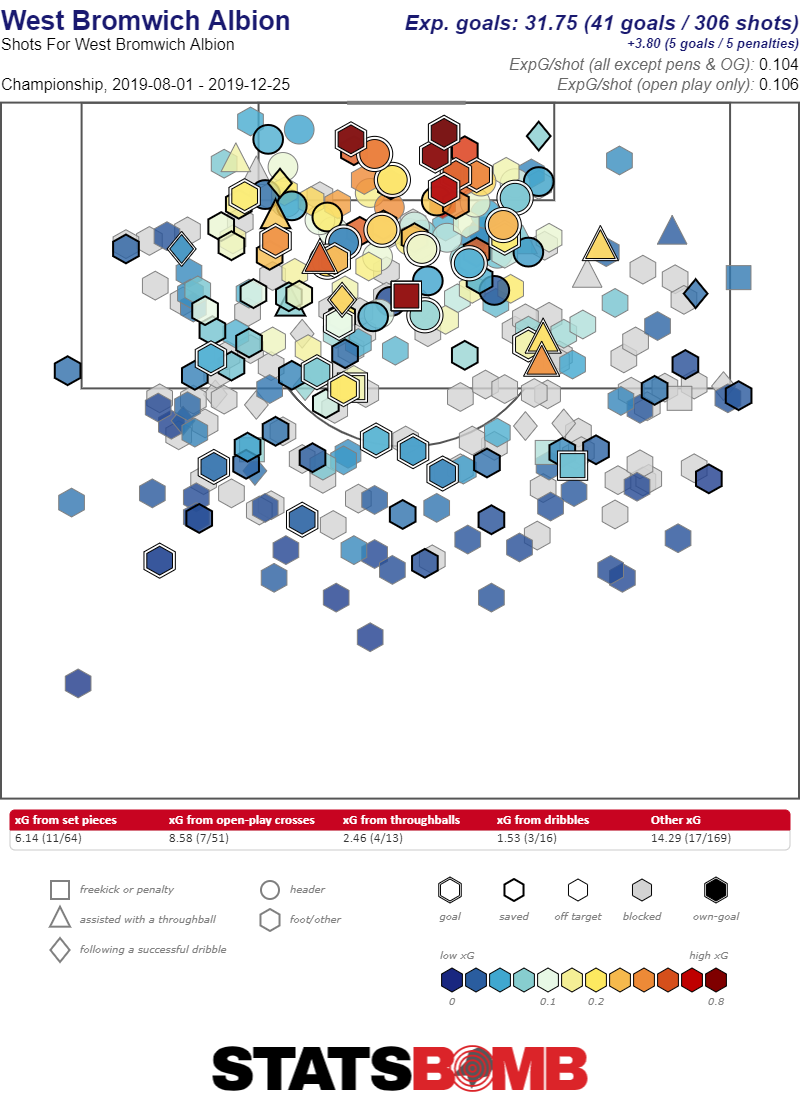 Whilst at the back, there was a little bit of separation on the actual total versus expectation, but nothing as dramatic, conceding 21 times from 25.35xG (plus 3/4 penalties).
Whilst at the back, there was a little bit of separation on the actual total versus expectation, but nothing as dramatic, conceding 21 times from 25.35xG (plus 3/4 penalties). 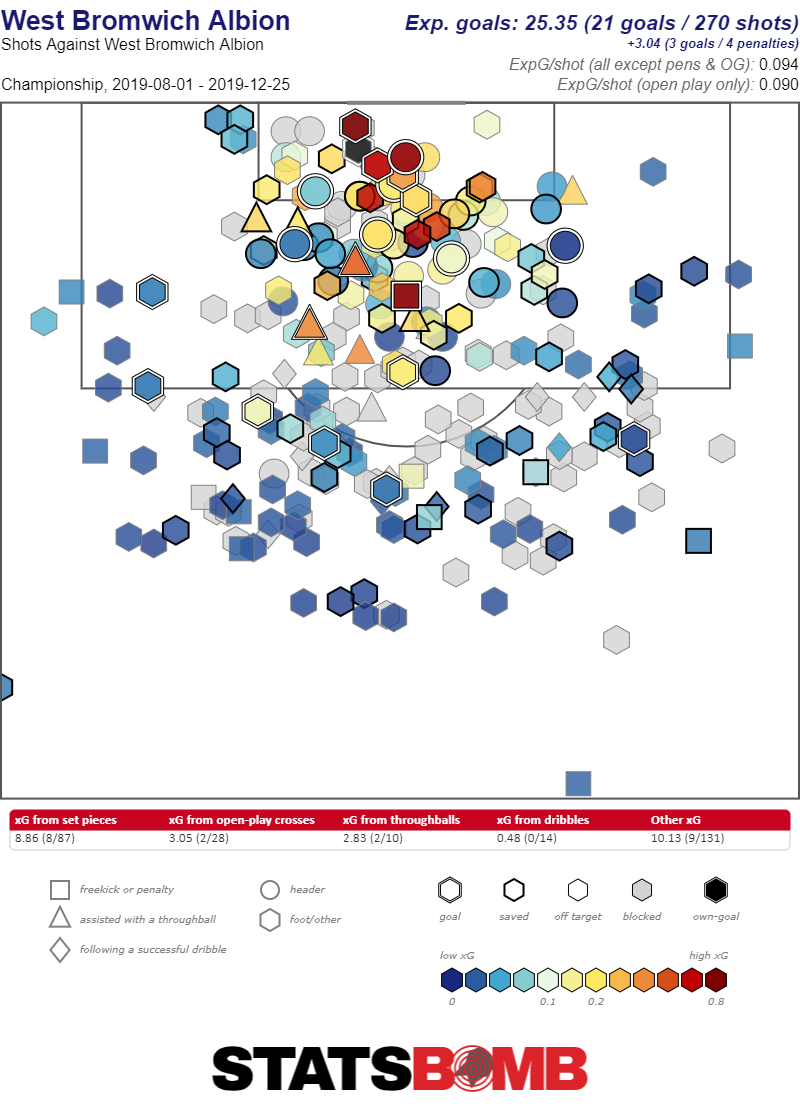 Running at a 100-point pace in the first half of the season meant that West Brom had the breathing space required to afford them a stagger and stumble on the home stretch. Their subsequent haul of 33 points from the second set of 23 games – only the 10th best record in the Championship in that period - should ring alarm bells for a side bracing themselves to face the Premier League juggernauts ahead, but the underlying numbers may counter the narrative that the Baggies are going into it as a worse side than the one that raced into 1st place by Christmas.
Running at a 100-point pace in the first half of the season meant that West Brom had the breathing space required to afford them a stagger and stumble on the home stretch. Their subsequent haul of 33 points from the second set of 23 games – only the 10th best record in the Championship in that period - should ring alarm bells for a side bracing themselves to face the Premier League juggernauts ahead, but the underlying numbers may counter the narrative that the Baggies are going into it as a worse side than the one that raced into 1st place by Christmas. 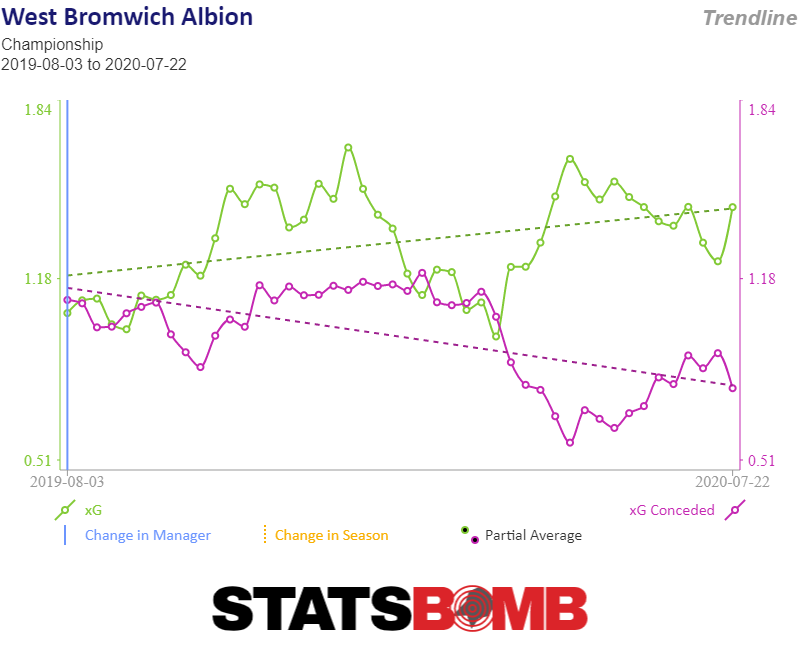 Metrics took a nosedive through the Winter period as they rode out a seven-match winless streak in that time but to a large extent that can be explained by the quashing of two of their best performers at that point in the season. West Ham dynamo Grady Diangana, on loan for the season and with 5 goals + 5 assists at that point, picked up an injury which in itself weakened West Brom’s attacking power, but it also allowed the opposition to put even more focus on outstanding talent Matheus Pereira, on 5 goals + 10 assists by that point, shutting him down and roughing him up to an even greater extent. They recovered sufficiently though and, although results were much less impressive, the metrics were virtually identical in the second half of the season: they scored 29 from 32.76xG (plus 2/2 penalties) and conceded 20 from 18.36xG. So, if anything, the metrics were even better and the surface level drop off in results shouldn’t be too much cause for concern, particularly as the pace set in the first half of the season was never likely to sustain anyway. Had they picked up their 83 points in 42 and 41 splits, as their relatively stable (save for the mid-season blip) metrics suggested they could’ve, then there wouldn’t even be a conversation to be had about it. Coming into the top tier, it’s clear West Brom will need reinforcements and a bit of a rejuvenation to the squad - whether they get it or not is another matter. Bilić has already hinted that it’s likely their transfer business will be more Sheffield United than Aston Villa, when comparing to the activities of the promoted Championship sides in last summer’s window. However, The Baggies have made one of the signings of the summer already in making Pereira’s loan deal permanent. Signed from Sporting Lisbon on deadline day in August 2019 for a £750k loan fee, the agreed £8million price tag at that time has turned out to be an absolute snip as Pereira established himself as one of the best players, let alone attacking midfielders, seen in the Championship last season.
Metrics took a nosedive through the Winter period as they rode out a seven-match winless streak in that time but to a large extent that can be explained by the quashing of two of their best performers at that point in the season. West Ham dynamo Grady Diangana, on loan for the season and with 5 goals + 5 assists at that point, picked up an injury which in itself weakened West Brom’s attacking power, but it also allowed the opposition to put even more focus on outstanding talent Matheus Pereira, on 5 goals + 10 assists by that point, shutting him down and roughing him up to an even greater extent. They recovered sufficiently though and, although results were much less impressive, the metrics were virtually identical in the second half of the season: they scored 29 from 32.76xG (plus 2/2 penalties) and conceded 20 from 18.36xG. So, if anything, the metrics were even better and the surface level drop off in results shouldn’t be too much cause for concern, particularly as the pace set in the first half of the season was never likely to sustain anyway. Had they picked up their 83 points in 42 and 41 splits, as their relatively stable (save for the mid-season blip) metrics suggested they could’ve, then there wouldn’t even be a conversation to be had about it. Coming into the top tier, it’s clear West Brom will need reinforcements and a bit of a rejuvenation to the squad - whether they get it or not is another matter. Bilić has already hinted that it’s likely their transfer business will be more Sheffield United than Aston Villa, when comparing to the activities of the promoted Championship sides in last summer’s window. However, The Baggies have made one of the signings of the summer already in making Pereira’s loan deal permanent. Signed from Sporting Lisbon on deadline day in August 2019 for a £750k loan fee, the agreed £8million price tag at that time has turned out to be an absolute snip as Pereira established himself as one of the best players, let alone attacking midfielders, seen in the Championship last season. 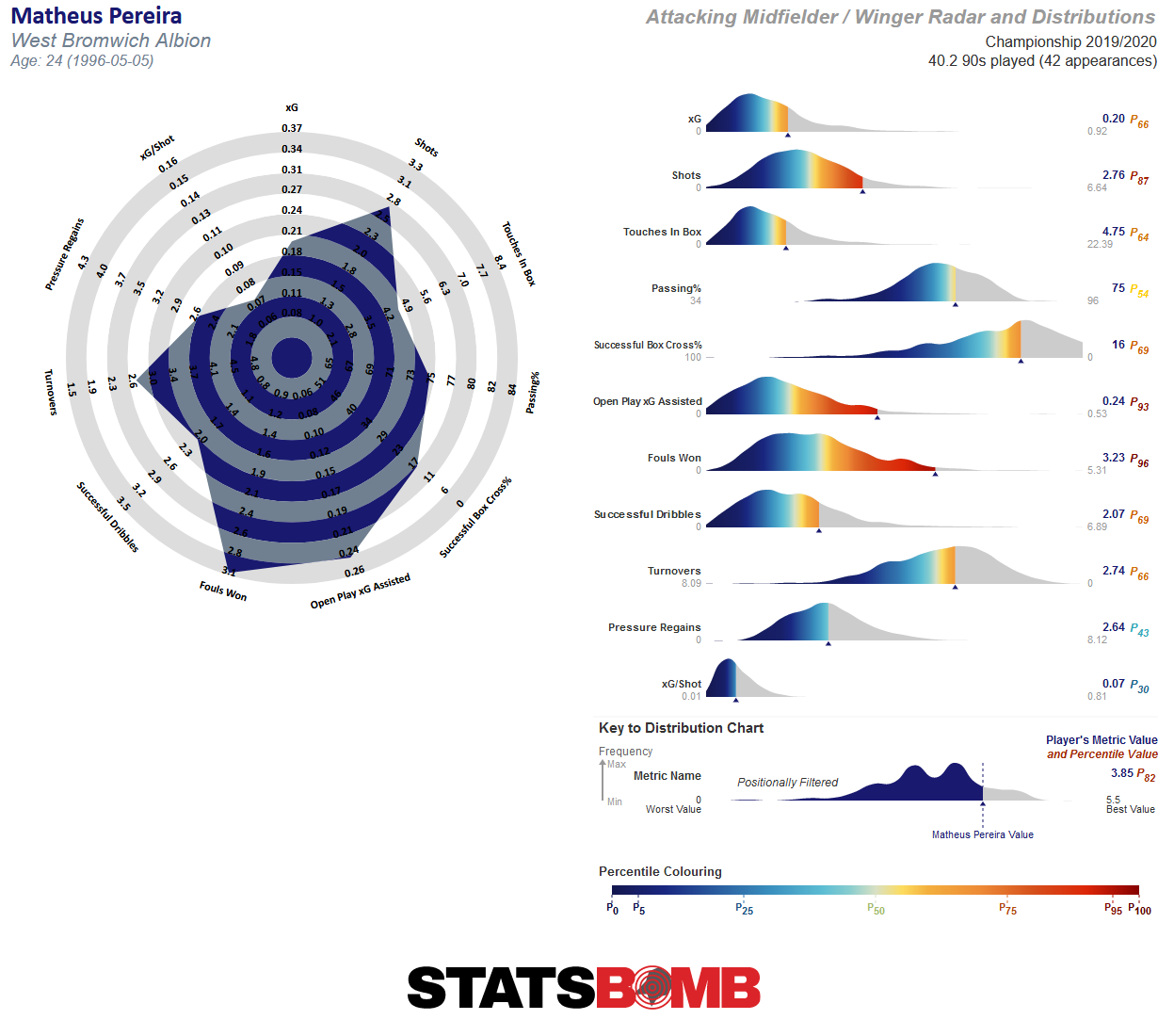 The Brazilian finished the campaign with a total of 8 goals and 16 assists, a contribution eclipsed only by Brentford’s Ollie Watkins, and it’s one piece of the jigsaw Bilić and West Brom fans will be relieved at not having to try and replace, especially at that price point. A reunion with buddy Filip Krovinović remains on the cards, the Croatian came on loan from Sporting’s rivals Benfica but struck up a fruitful relationship on and off the pitch with Pereira. Krovinović’s ball retention turned out to be the perfect counter point to the risk-friendly Pereira and there was often a regular supply line between the two. If reports are to be believed, negotiations are well underway for his return. A deal that could be just as important, and equally shrewd to the Pereira deal if they can successfully negotiate it, is the return of Grady Diangana on a permanent from West Ham, with the Hammers apparently considering accepting an offer for the England U21 winger. Diangana’s season wasn’t held to quite as much fanfare outside of the West Midlands largely due to the medium-term injury he suffered, but Baggies fans know what a talent they had dovetailing with Pereira and probably hadn’t even considered a return for him would be likely on a temporary basis, let alone on a permanent, expecting his good form to take him into the West Ham first team.
The Brazilian finished the campaign with a total of 8 goals and 16 assists, a contribution eclipsed only by Brentford’s Ollie Watkins, and it’s one piece of the jigsaw Bilić and West Brom fans will be relieved at not having to try and replace, especially at that price point. A reunion with buddy Filip Krovinović remains on the cards, the Croatian came on loan from Sporting’s rivals Benfica but struck up a fruitful relationship on and off the pitch with Pereira. Krovinović’s ball retention turned out to be the perfect counter point to the risk-friendly Pereira and there was often a regular supply line between the two. If reports are to be believed, negotiations are well underway for his return. A deal that could be just as important, and equally shrewd to the Pereira deal if they can successfully negotiate it, is the return of Grady Diangana on a permanent from West Ham, with the Hammers apparently considering accepting an offer for the England U21 winger. Diangana’s season wasn’t held to quite as much fanfare outside of the West Midlands largely due to the medium-term injury he suffered, but Baggies fans know what a talent they had dovetailing with Pereira and probably hadn’t even considered a return for him would be likely on a temporary basis, let alone on a permanent, expecting his good form to take him into the West Ham first team. 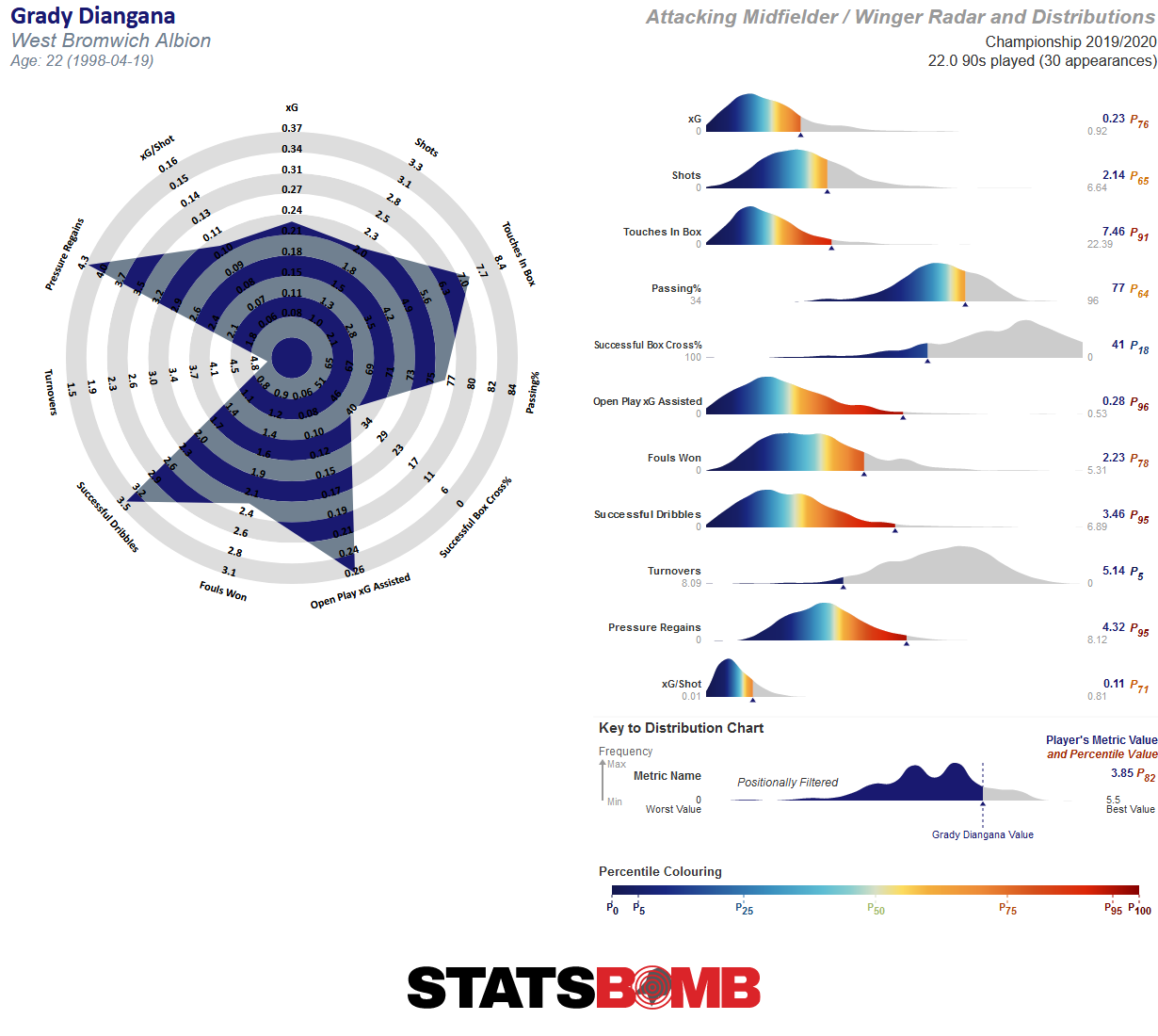 * Despite only managing 1980 minutes, Diangana undoubtedly made West Brom a much better side when he was in it and his 0.64 goals+assists per 90 minutes ranked 6th in the Championship for players with 1500 minutes or more – ahead of the likes of Pereira, Watkins, Mitrovic and Benrahma – and his 3.46 successful dribbles per 90 ranked 2nd in the league, getting the better of whichever fullback he was up against virtually every week. Reuniting Pereira, Diangana and Krovinovic, three key contributors to West Brom’s promotion, would be a huge boost and perhaps one that was unexpected at the close of the season, Pereira’s formality of a transfer aside. Probably the most important business they still have to do will be in recruiting a centre forward. None of Charlie Austin, Hal Robson-Kanu or Kenneth Zohore nailed down the role through last season and an upgrade is a high priority. Romaine Sawyers and Jake Livermore had excellent seasons as the double pivot in midfield but will need more help with little depth behind them, whilst Semi Ajayi needs a partner at centre back as Ahmed Hegazy and Kyle Bartley were rotated and apparently not entirely trusted by Bilić. A move for Brighton’s Shane Duffy failed as he opted to join Celtic, but that in itself could open the door for West Brom to make a move to bring Kristoffer Ajer south of the border who has been linked.
* Despite only managing 1980 minutes, Diangana undoubtedly made West Brom a much better side when he was in it and his 0.64 goals+assists per 90 minutes ranked 6th in the Championship for players with 1500 minutes or more – ahead of the likes of Pereira, Watkins, Mitrovic and Benrahma – and his 3.46 successful dribbles per 90 ranked 2nd in the league, getting the better of whichever fullback he was up against virtually every week. Reuniting Pereira, Diangana and Krovinovic, three key contributors to West Brom’s promotion, would be a huge boost and perhaps one that was unexpected at the close of the season, Pereira’s formality of a transfer aside. Probably the most important business they still have to do will be in recruiting a centre forward. None of Charlie Austin, Hal Robson-Kanu or Kenneth Zohore nailed down the role through last season and an upgrade is a high priority. Romaine Sawyers and Jake Livermore had excellent seasons as the double pivot in midfield but will need more help with little depth behind them, whilst Semi Ajayi needs a partner at centre back as Ahmed Hegazy and Kyle Bartley were rotated and apparently not entirely trusted by Bilić. A move for Brighton’s Shane Duffy failed as he opted to join Celtic, but that in itself could open the door for West Brom to make a move to bring Kristoffer Ajer south of the border who has been linked. 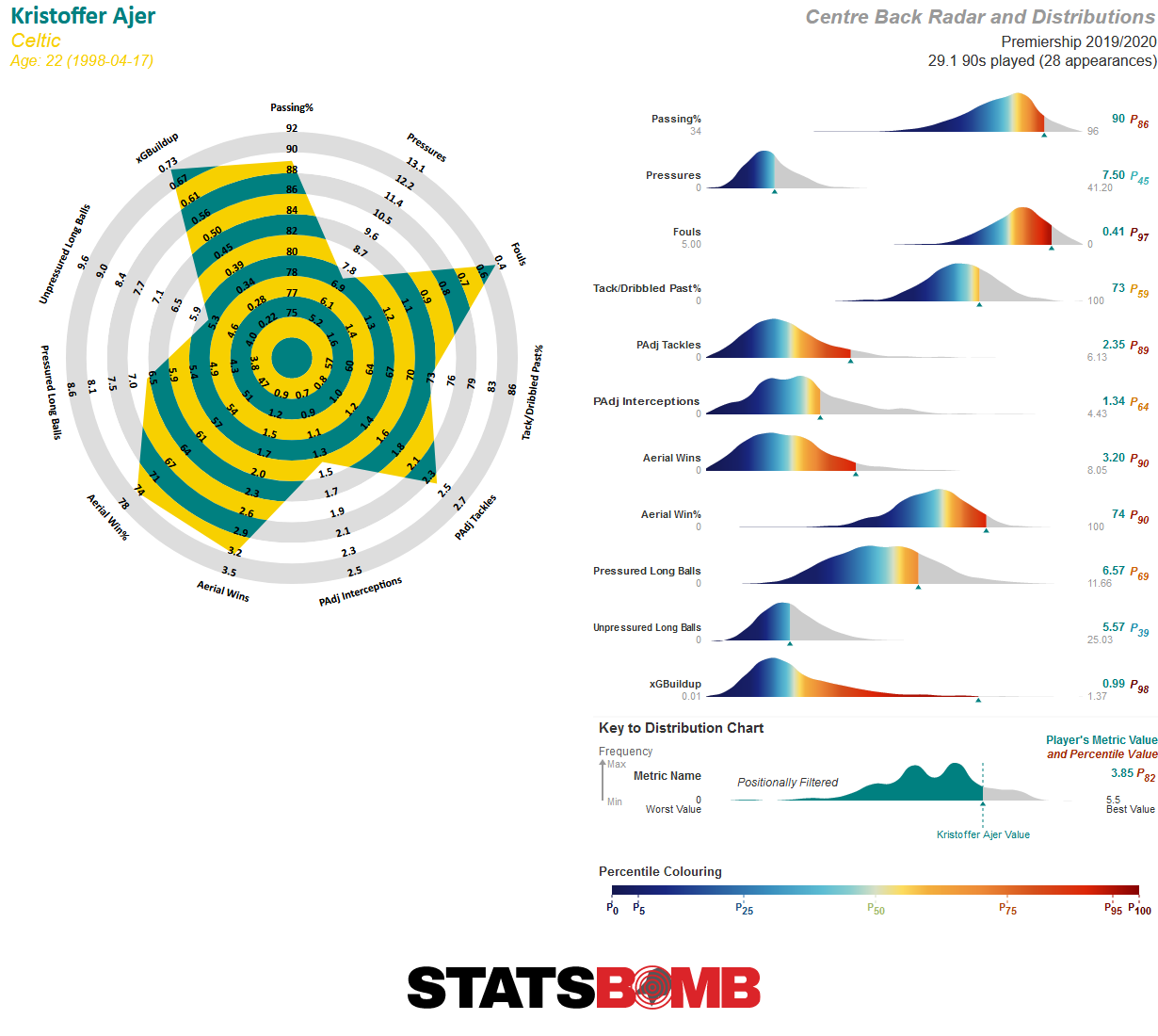 The apparent faltering at the back end of the campaign has probably quelled confidence amongst the fanbase and there’s a sense of realism that they’ll have to overcome the odds to finish above the dotted red line in 2020/21. The squad was already in need of retooling anyway - let alone to be ready to step up to the Premier League - and there seemingly isn’t a huge amount of backing available in order to do that. That said, shrewd additions in problem areas will at least help the Baggies to be competitive and should Bilić adjust the tactical setup sufficiently in order to keep them solid at the back, providing a foundation for the star quality in the side to thrive, then they may just have a chance. Otherwise, a return trip down the yo-yo in May 2021 could beckon.
The apparent faltering at the back end of the campaign has probably quelled confidence amongst the fanbase and there’s a sense of realism that they’ll have to overcome the odds to finish above the dotted red line in 2020/21. The squad was already in need of retooling anyway - let alone to be ready to step up to the Premier League - and there seemingly isn’t a huge amount of backing available in order to do that. That said, shrewd additions in problem areas will at least help the Baggies to be competitive and should Bilić adjust the tactical setup sufficiently in order to keep them solid at the back, providing a foundation for the star quality in the side to thrive, then they may just have a chance. Otherwise, a return trip down the yo-yo in May 2021 could beckon.
If you're a club, media or gambling entity and want to know more about what StatsBomb can do for you, please contact us at Sales@StatsBomb.com We also provide education in this area, so if this taste of football analytics sparked interest, check out our Introduction to Football Analytics course Follow us on twitter in English and Spanish and also on LinkedIn
